
Contents
Contents
For your safety ........................................ 7
General information ............................. 10
Essential indicators in standby mode .........................10
Menu ....................................................................................11
Switching between applications ..........................12
Actions common to all applications ...........................12
Volume control..................................................................13
Shared memory .................................................................14
Your phone ............................................ 15
Making a call .....................................................................15
Making a call using the Contacts directory ......15
Calling your voice mailbox (Network Service)..16
Speed dialling a phone number ............................16
Making a conference call (Network Service) ....16
Answering a call ...............................................................17
Options during a call ...............................................17
Call waiting (Network Service) .............................18
Diverting calls (Network Service).........................18
Log - Call register and general log..............................19
GPRS data counter ...................................................19
Recent calls register.................................................19
Call duration...............................................................20
Viewing the general log..........................................21
Personal information ............................ 22
Contacts..............................................................................22
Creating and editing contact cards.....................22
Copying contacts between the SIM card and phone
memory........................................................................23
Adding a ringing tone for a contact card or group
23
Voice dialling .............................................................24
Assigning speed dialling keys................................25
Viewing subscribed contacts.................................25
Managing contact groups......................................26
Presence (Network Service)...........................................26
Changing your availability information .............27
Changing who can view your Presence information
27
Updating your Presence information..................29
Presence settings......................................................30
Positioning (Network Service) ......................................30
Calendar..............................................................................31
Creating calendar entries.......................................31
To-do....................................................................................32
Importing data from compatible Nokia phones ......33
Multimedia ............................................ 34

Copyright © 2004 Nokia. All rights reserved.
Contents
Camera................................................................................ 34
Taking pictures.......................................................... 34
Recording videos ...................................................... 36
Viewing images................................................................. 37
Zooming on a saved image.................................... 37
Keyboard shortcuts.................................................. 38
RealPlayer™........................................................................ 38
Playing media files................................................... 39
Changing the settings............................................. 40
Movie director................................................................... 40
Gallery ................................................................................. 41
Opening files.............................................................. 42
Other default folders............................................... 42
Downloading files .................................................... 43
Uploading images to an image server (Network
Service)........................................................................ 43
Messaging.............................................. 45
Writing text ....................................................................... 46
Using traditional text input .................................. 46
Using predictive text input.................................... 47
Copying text to the clipboard............................... 49
Writing and sending messages .................................... 50
Settings needed for multimedia messaging ..... 51
Settings needed for e-mail.................................... 51
Inbox - receiving messages........................................... 52
Viewing multimedia objects.................................. 52
Receiving smart messages..................................... 52
Receiving service messages (Network Service) 53
My folders ......................................................................... 54
Remote mailbox (Network Service) ............................ 54
Opening the mailbox ............................................... 54
Retrieving e-mail messages from the mailbox 54
Deleting e-mail messages...................................... 55
Disconnecting from mailbox ................................. 56
Outbox................................................................................. 56
Viewing messages on a SIM card ................................ 57
Cell broadcast (Network Service) ................................ 57
Service command editor ................................................ 58
Messaging settings.......................................................... 58
Settings for text messages .................................... 58
Settings for multimedia messages ...................... 59
Settings for e-mail................................................... 60
Settings for service messages............................... 62
Settings for Cell broadcast (Network Service). 62
Settings for the Other folder................................. 62
Tools........................................................64
Using the Setting Wizard............................................... 64
Settings............................................................................... 65
Changing general settings..................................... 65
Phone settings........................................................... 66
Call settings ............................................................... 67
Connection settings................................................. 68
Date and time............................................................ 72
Call barring (Network Service) ............................. 72

Copyright © 2004 Nokia. All rights reserved.
Contents
Network .......................................................................73
Enhancement settings.............................................73
Security................................................................................74
Phone and SIM ..........................................................74
Certif. management .................................................76
Device manager.................................................................77
File manager ......................................................................78
Viewing memory consumption .............................78
Voice commands...............................................................79
Adding a voice command to an application .....79
Starting an application using a voice command80
Replaying, erasing, or changing a voice command
81
Memory card......................................................................81
Format memory card................................................81
Backing up and restoring information................82
Locking the memory card .......................................82
Checking memory consumption ...........................83
Personalising your phone ..................... 84
Profiles.................................................................................84
Changing the profile ................................................84
Customising profiles ................................................84
Themes.................................................................................85
Editing themes...........................................................86
Extras ..................................................... 87
Wallet .................................................................................87
Entering the wallet code ........................................87
Storing personal card details ................................88
Creating personal notes..........................................89
Creating a wallet profile.........................................89
Retrieving information from the wallet to your
browser........................................................................90
Viewing ticket details..............................................90
Wallet settings ..........................................................90
Resetting the wallet and wallet code.................91
Calculator ...........................................................................91
Converter ............................................................................91
Converting units .......................................................92
Setting a base currency and exchange rates....92
Notes....................................................................................93
Clock ....................................................................................93
Changing clock settings .........................................93
Setting an alarm .......................................................93
Recorder..............................................................................94
Chat (Network Service)...................................................94
Before using Chat.....................................................95
Connecting to a chat server ..................................95
Modifying your chat settings................................95
Joining and leaving a chat group ........................96
Searching for chat groups and users ..................97
Chatting in a chat group........................................97
Starting and viewing individual conversations 98
Chat contacts ............................................................99
Editing chat group settings ...................................99

Copyright © 2004 Nokia. All rights reserved.
Contents
Chat and Presence servers...................................100
Go to..................................................................................101
Adding shortcuts ....................................................101
Services and Applications .................. 102
Web (Mobile browser) ..................................................102
Basic steps for accessing .....................................102
Setting up the phone for the browser service103
Making a connection ............................................103
Viewing bookmarks................................................104
Browsing ...................................................................104
Downloading............................................................106
Ending a connection..............................................107
Browser settings .....................................................107
Application manager.....................................................109
Installing applications - general information 109
Removing an application .....................................111
Connectivity ........................................ 112
Bluetooth connection ...................................................112
Bluetooth settings..................................................113
Sending data via Bluetooth.................................113
Paired devices view................................................115
Receiving data via Bluetooth..............................115
Disconnecting Bluetooth......................................116
Connection manager.....................................................116
Viewing connection details .................................116
Ending connections ...............................................117
Connecting your phone to a compatible computer117
Sync - remote synchronisation ..................................117
Creating a new synchronisation profile...........118
Synchronising data ................................................119
Troubleshooting .................................. 120
Q&A....................................................................................121
Battery information ........................... 123
Care and Maintenance....................... 124
Additional safety information........... 125
Index .................................................... 128
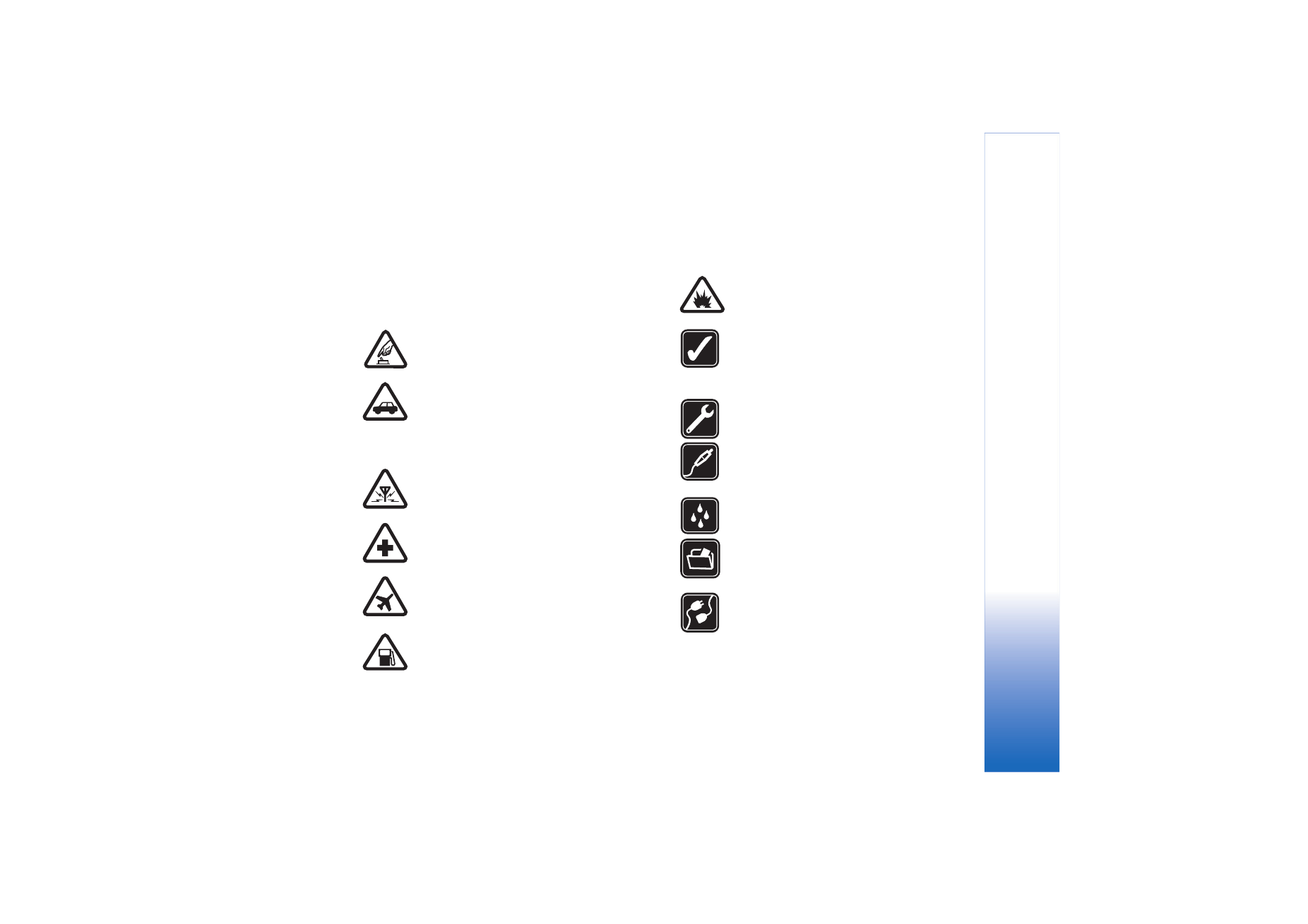
Copyright © 2004 Nokia. All rights reserved.
7
For your safety
Read these simple guidelines. Breaking the rules may be
dangerous or illegal. Further detailed information is given
in this manual.
SWITCH ON SAFELY Do not switch the phone
on when wireless phone use is prohibited or
when it may cause interference or danger.
ROAD SAFETY COMES FIRST Obey all local
laws. Always keep your hands free to operate
the vehicle while driving. Your first
consideration while driving should be road
safety.
INTERFERENCE All wireless phones may be
subject to interference, which could affect
performance.
SWITCH OFF IN HOSPITALS Follow any
restrictions. Switch the phone off near medical
equipment.
SWITCH OFF IN AIRCRAFT Follow any
restrictions. Wireless devices can cause
interference in aircraft.
SWITCH OFF WHEN REFUELLING Don’t use
the phone at a refuelling point. Don’t use near
fuel or chemicals.
SWITCH OFF NEAR BLASTING Follow any
restrictions. Don't use the phone where
blasting is in progress.
USE SENSIBLY Use only in the normal
position as explained in the product
documentation. Don’t touch the antenna
unnecessarily.
QUALIFIED SERVICE Only qualified personnel
may install or repair this product.
ENHANCEMENTS AND BATTERIES Use only
approved enhancements and batteries. Do not
connect incompatible products.
WATER-RESISTANCE Your phone is not
water-resistant. Keep it dry.
BACKUP COPIES Remember to make backup
copies or keep a written record of all
important information stored in your phone.
CONNECTING TO OTHER DEVICES When
connecting to any other device, read its user
guide for detailed safety instructions. Do not
connect incompatible products.
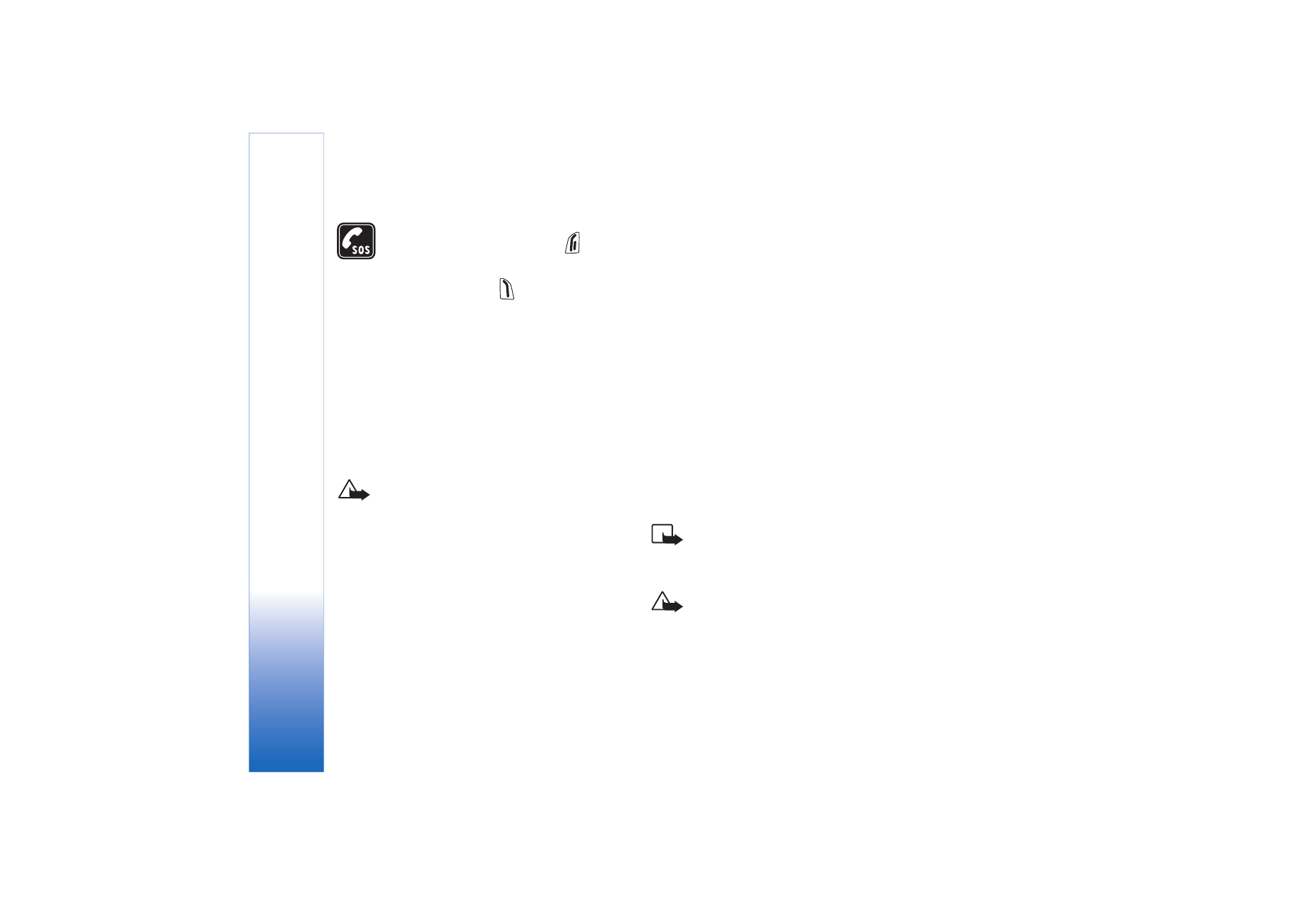
Copyright © 2004 Nokia. All rights reserved.
8
EMERGENCY CALLS Ensure the phone is
switched on and in service. Press
as many
times as needed to clear the display and return
to the start screen. Key in the emergency
number, then press
. Give your location.
Do not end the call until given premission to
do so.
About your device
The wireless device described in this guide is approved for
use on the EGSM 900 and GSM1800 and 1900 networks.
Contact your service provider for more information about
networks.
When using the features in this device, obey all laws and
respect privacy and legitimate rights of others.
Warning: To use any features in this device, other
than the alarm clock, the device must be switched
on. Do not switch the device on when wireless
device use may cause interference or danger.
Network Services
To use the phone you must have service from a wireless
service provider. Many of the features in this device
depend on features in the wireless network to function.
These Network Services may not be available on all
networks or you may have to make specific arrangements
with your service provider before you can utilize Network
Services. Your service provider may need to give you
additional instructions for their use and explain what
charges will apply. Some networks may have limitations
that affect how you can use Network Services. For
instance, some networks may not support all language-
dependent characters and services.
Your service provider may have requested that certain
features be disabled or not activated in your device. If so,
they will not appear on your device menu. Contact your
service provider for more information.
This device supports WAP 2.0 protocols (HTTP and SSL) that
run on TCP/IP protocols. Some features of this device, such
as MMS, browsing, e-mail, remote SyncML, and content
downloading via browser or over MMS, require network
support for these technologies.
Chargers and enhancements
Note: Check the model number of any charger
before use with this device. This device is intended
for use when supplied with power from ACP-8,
ACP-12, LCH-9 and LCH-12.
WARNING! Use only batteries, chargers, and
enhancements approved by Nokia for use with this
particular model. The use of any other types may
invalidate any approval or warranty, and may be
dangerous.

Copyright © 2004 Nokia. All rights reserved.
9
For availability of approved enhancements, please check
with your dealer. When you disconnect the power cord of
any enhancement, grasp and pull the plug, not the cord.
Your device and its enhancements may contain small
parts. Keep them out of reach of small children.
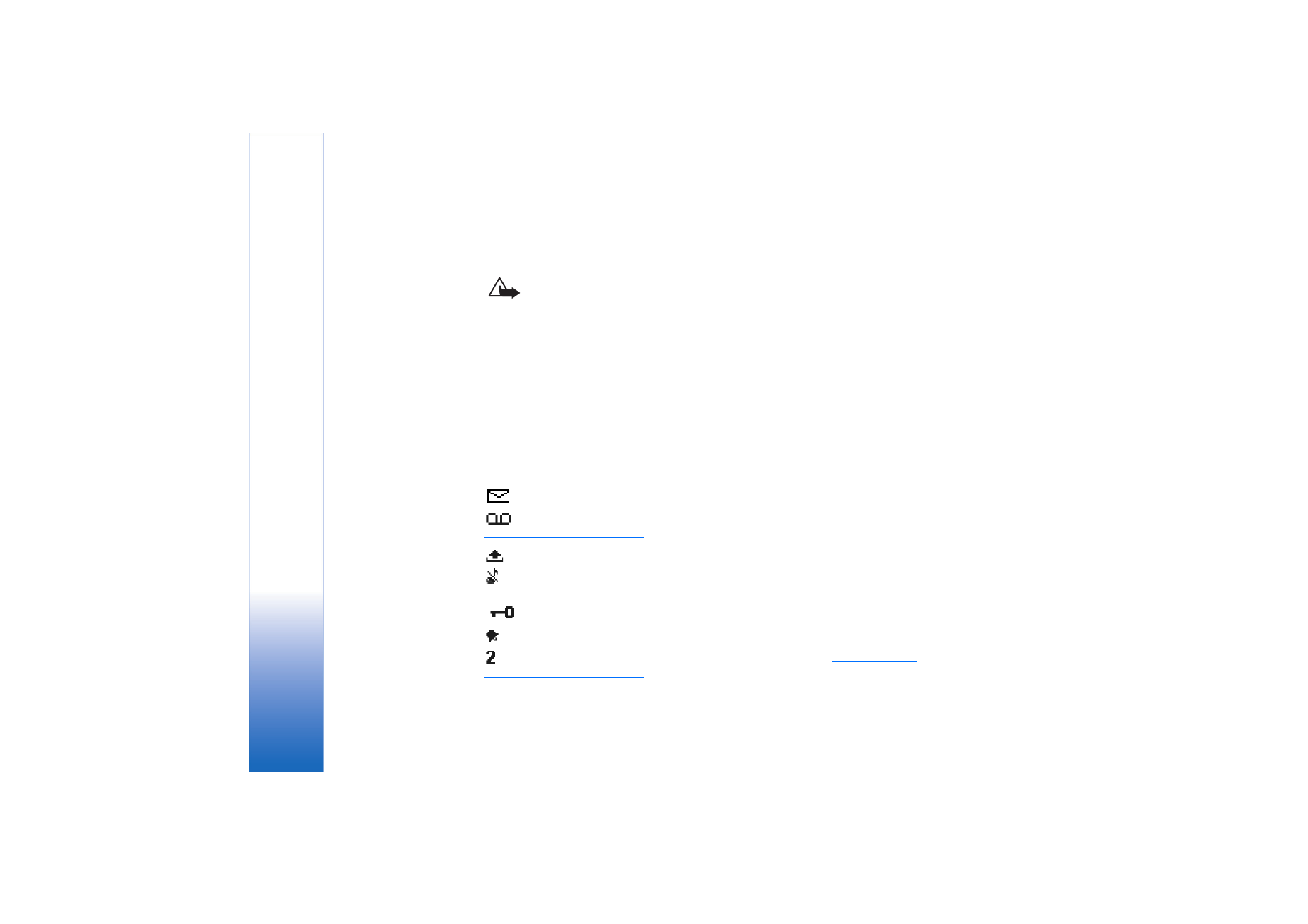
Copyright © 2004 Nokia. All rights reserved.
Gene
ral
i
n
formati
o
n
10
General information
Warning: To use any features in this device, other than the alarm clock, the device
must be switched on. Do not switch the device on when wireless device use may
cause interference or danger.
Your Nokia 6670 phone provides various functions that are ideal for daily use, such as
Camera, Video recorder, Messaging, E-mail, Wallet, Clock, Calculator, and Calendar.
Stickers in the sales package
• The stickers included on the warranty card, in the sales package, contain important
information for service and customer support purposes. The sales package also includes
instructions on how you should use these stickers.
Essential indicators in standby mode
- You have received one or several messages to the Inbox in Messaging.
- You have received one or several voice messages.
See “Calling your voice mailbox
(Network Service)” on page 16.
- There are messages waiting to be sent in Outbox.
-
Ringing type
has been set to
Silent
,
Message alert tone
to
Off
, and
Chat alert tone
to
On
in the currently active profile.
- The phone’s keypad is locked. See the Getting Started guide.
- You have an active alarm.
- You can make calls using phone line 2 only (Network Service).
See “Line in use
(Network Service)” on page 68.
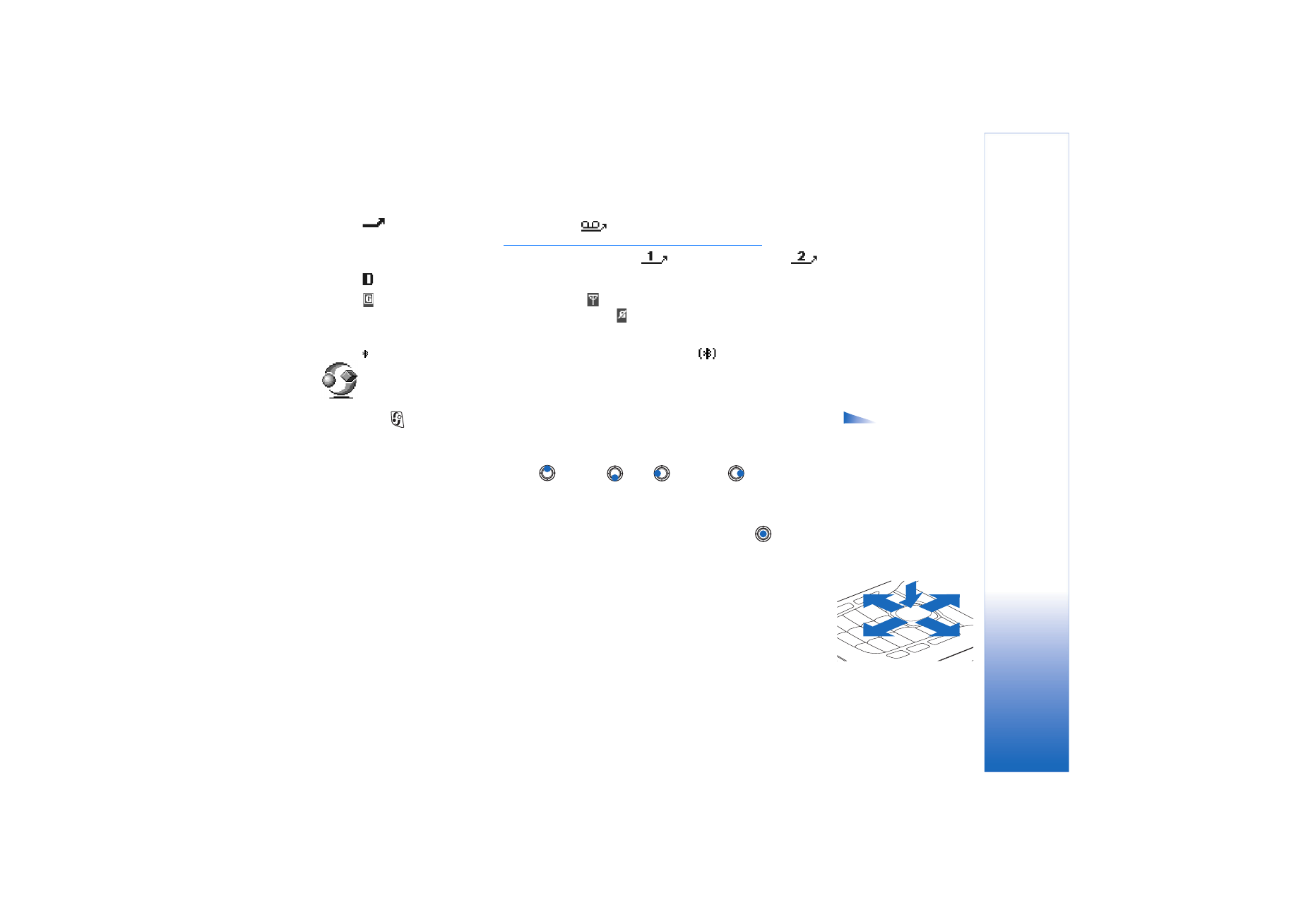
Copyright © 2004 Nokia. All rights reserved.
Gene
ral
i
n
formati
o
n
11
- All calls to the phone are diverted.
- Indicates that all calls to the phone are
diverted to a voice mailbox.
See “Diverting calls (Network Service)” on page 18.
If you have
two phone lines, the divert indicator for the first line is
and for the second line
.
- A data call is active.
- Shown instead of the antenna symbol
(shown in the top left corner in standby
mode) when there is an active GPRS connection.
- Shown when the GPRS connection
is put on hold during voice calls.
- Bluetooth is active. When data is transmitted via Bluetooth,
is shown.
Menu
Options in the
Menu:
Open
,
List view
/
Grid view
,
Move
,
Move to
folder
,
New folder
,
App.
downloads
,
Memory
details
,
Help
and
Exit
.
Press
(Menu key) to display the main Menu. In the Menu, you can access all the
applications in your phone.
Moving in the Menu
• Press the scroll key on the top
, bottom
, left
and right
(shown with
blue arrows 1 to 4) to navigate the Menu.
Opening applications or folders
• Scroll to an application or a folder and press the centre of the scroll key
(shown
with blue arrow 5) to open it.
Closing applications
• Backstep by pressing
Back
or
Exit
as many times as needed to return to standby mode
or select
Options
→
Exit
.
Fig. 1 Using the scroll key.
2
3
4
5
1
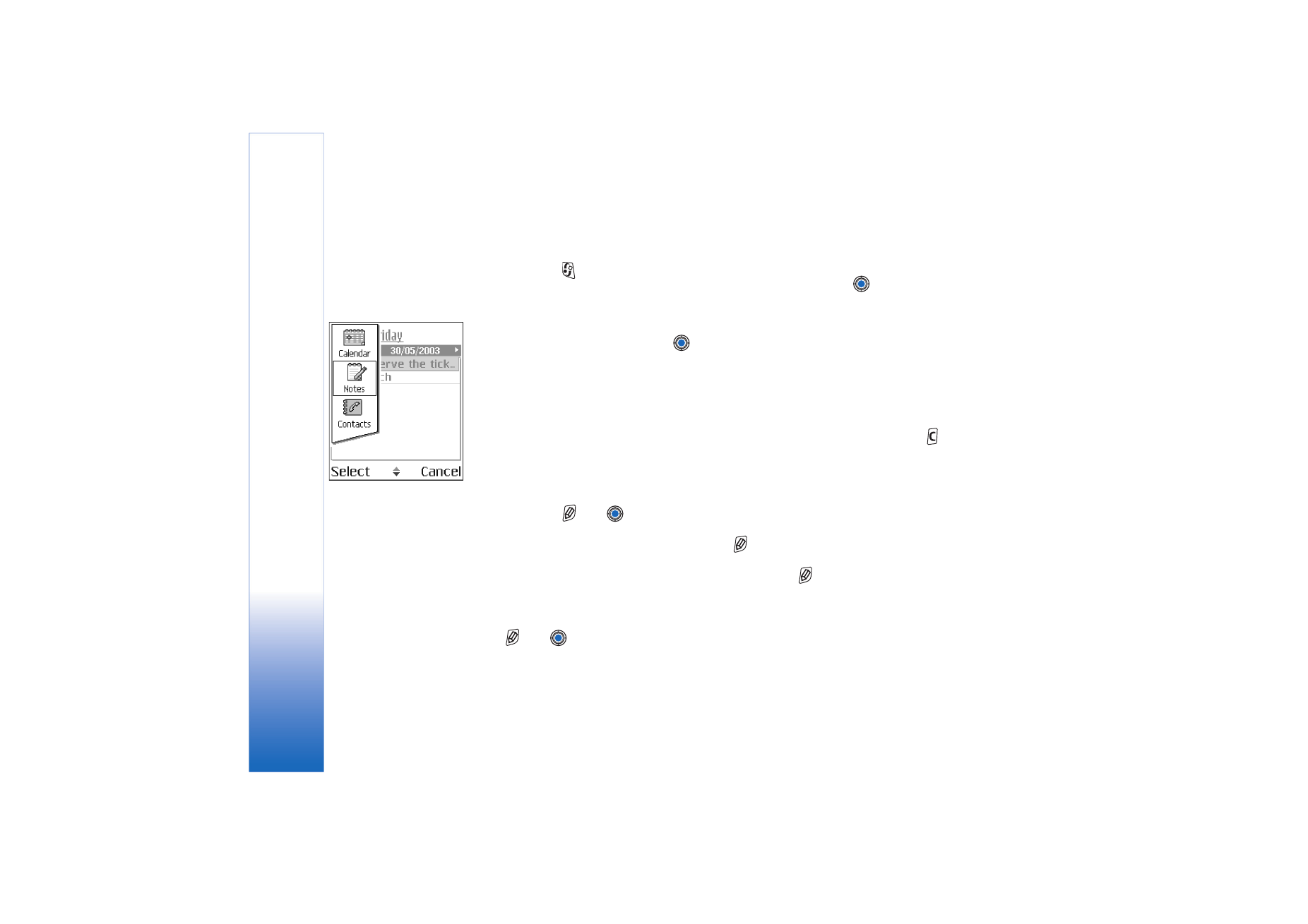
Copyright © 2004 Nokia. All rights reserved.
Gene
ral
i
n
formati
o
n
12
Switching between applications
If you have several applications open and want to switch from one application to another,
press and hold
(Menu key). The application switching window opens showing a list of
applications that are currently open. Scroll to an application and press
to go to it.
Actions common to all applications
• Opening items for viewing - When you are viewing a list of files or folders, to open an
item, scroll to an item and press
, or select
Options
→
Open
.
• Editing items - To open an item for editing, you sometimes need to first open it for
viewing and then select
Options
→
Edit
, if you want to change its contents. Use the
scroll key to scroll through all fields of the item.
• Renaming items - To give a new name to a file or folder, scroll to it and select
Options
→
Rename
.
• Removing, deleting items - Scroll to the item and select
Options
→
Delete
or press
.
To delete many items at a time, you first need to mark them. See the next paragraph:
‘Marking an item’.
• Marking an item - There are several ways to select items when you are in a list.
• To select one item at a time, scroll to it and select
Options
→
Mark/Unmark
→
Mark
or press
and
at the same time. A check mark is placed next to the item.
• To select all items in the list, select
Options
→
Mark/Unmark
→
Mark all
.
• Marking multiple items - Press and hold
, then move the scroll key down or up.
As the selection moves, a check mark is placed next to the items. To end the selection,
stop the scrolling with the scroll key and then release
.
After you have selected all the items you want, you can move or delete them by
selecting
Options
→
Move to folder
or
Delete
.
• To unmark an item, scroll to it and select
Options
→
Mark/Unmark
→
Unmark
or press
and
at the same time.
• Creating folders - To create a new folder, select
Options
→
New folder
. You are asked
to give a name to the folder (max. 35 letters).
Fig. 2 Switching between
applications.

Copyright © 2004 Nokia. All rights reserved.
Gene
ral
i
n
formati
o
n
13
• Moving items to a folder - To move items to a folder or between folders, select
Options
→
Move to folder
(not shown if there are no folders available). When you select
Move to folder
, a list of available folders opens and you can also see the root level of the
application (for moving an item out of a folder). Select the location you want the item
to be moved to and press
OK
.
• Sending items - To send items, to compatible devices, scroll to the item that you want
to send, select
Options
→
Send
. Select the method, the choices are
Via multimedia
,
Via
Bluetooth
, and
Via e-mail
.
• If you choose to send the item in an e-mail or a multimedia message, an editor opens.
Press
to select the recipient(s) from the Contacts directory or write the phone
number or e-mail address of the recipient in the
To
: field. Add text or sound and
select
Options
→
Send
.
See “Writing and sending messages” on page 50.
• Via Bluetooth.
See “Sending data via Bluetooth” on page 113.
Copyright protections may prevent some images, ringing tones, and other content from
being copied, modified, transferred or forwarded.
Volume control
Voice volume icons:
- for earpiece mode,
- for loudspeaker
mode.
When you have an active call or are listening to a sound, press
or
to increase or
decrease the volume level, respectively.
The loudspeaker allows you to speak and listen to the phone from a short distance without
having to hold the phone to your ear, for example, having it on a table nearby. The
loudspeaker can be used during a call, with sound and video applications, and when
viewing multimedia messages. Sound and video applications use the loudspeaker by
default. Using the loudspeaker makes it easier to use other applications while in a call.
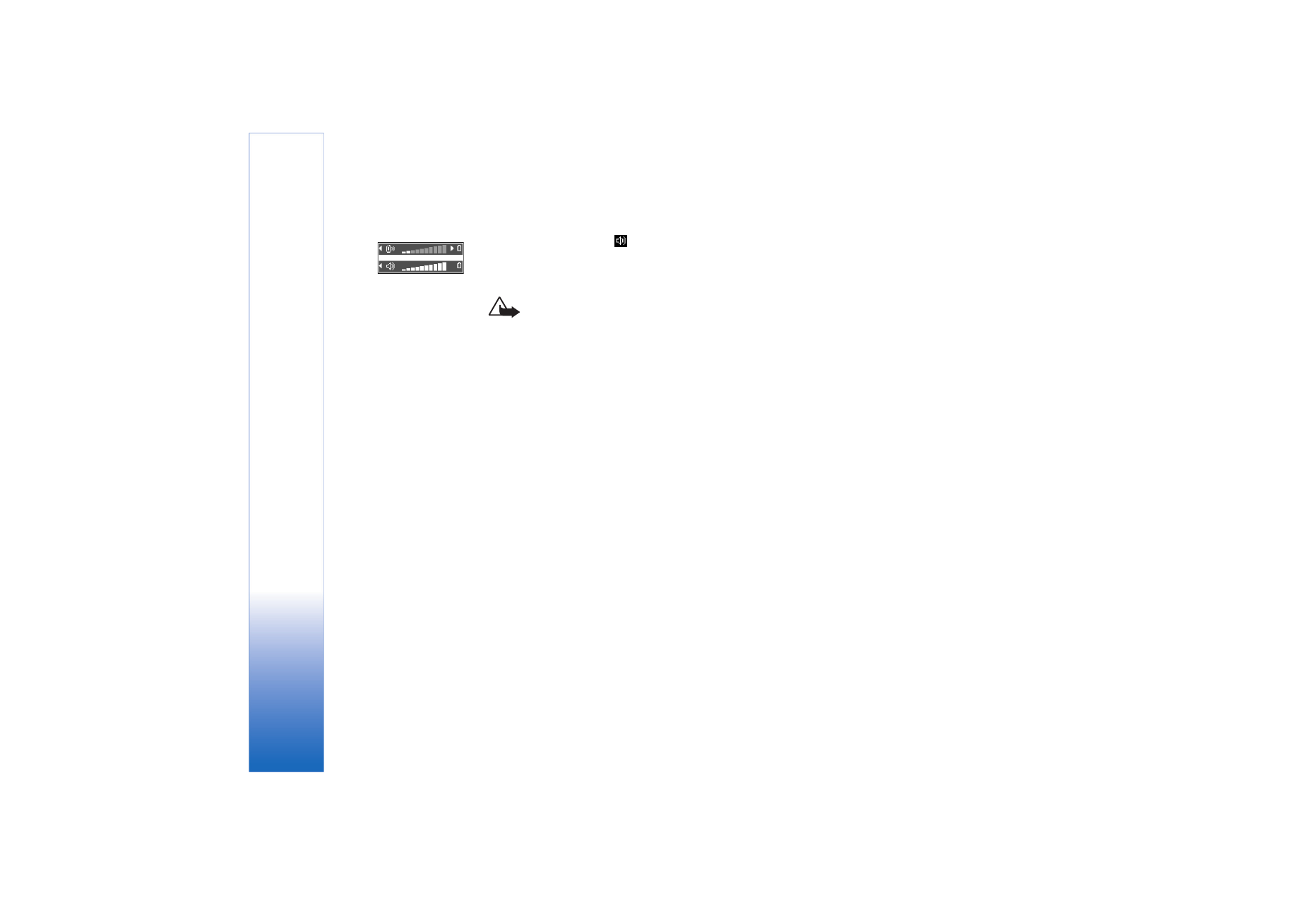
Copyright © 2004 Nokia. All rights reserved.
Gene
ral
i
n
formati
o
n
14
To start using the loudspeaker during an already active call, select
Options
→
Activate
loudsp.
. A tone is played,
is shown in the navigation bar, and the volume indicator
changes.
The loudspeaker cannot be activated when you have connected a headset to the phone.
Warning: Do not hold the device near your ear when the loudspeaker is in use,
because the volume may be extremely loud.
To turn off the loudspeaker when you have an active call, select
Options
→
Activate handset
.
Shared memory
The following features in this device may share memory: contacts, text messages, and
multimedia messages, images and ringing tones, Video recorder, RealPlayer
TM
, calendar and
to-do notes, and downloaded applications. Use of one or more of these features may
reduce the memory available for the remaining features sharing memory. For example,
saving many multimedia messages may use all of the available memory. Your device may
display a message that the memory is full when you try to use a shared memory feature.
In this case, delete some of the information or entries stored in the shared memory features
before continuing. Some of the features, such as calendar and to-do notes may have a
certain amount of memory specially allotted to them in addition to the memory shared
with other features.
Fig. 3 Volume indicators
for earpiece and
loudspeaker modes are
shown in the navigation
bar.
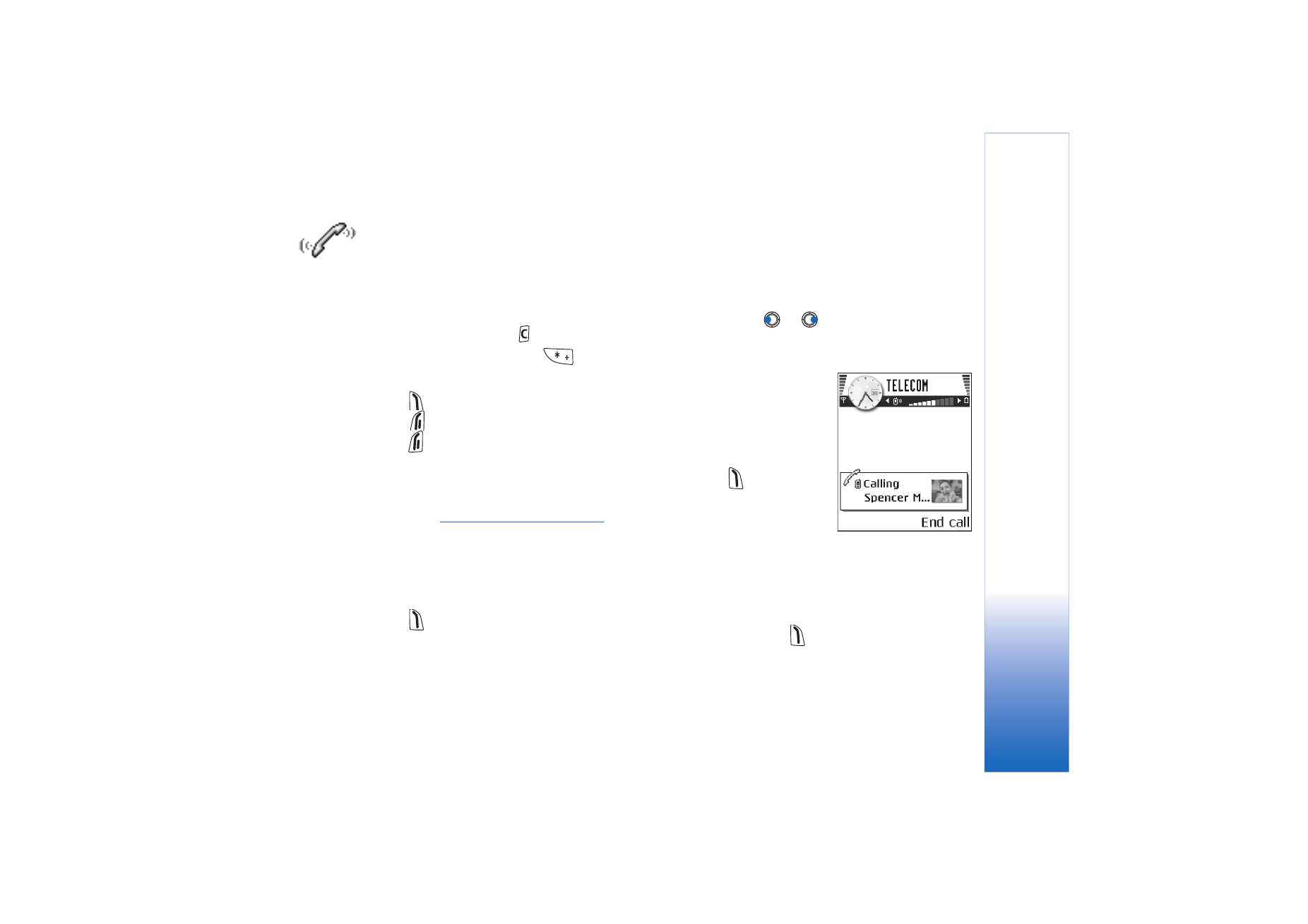
Copyright © 2004 Nokia. All rights reserved.
Your phone
15
Your phone
Making a call
1 In standby mode, key in the phone number, including the area code. Press
or
to move the cursor. Press
to remove a number.
• For international calls, press
twice for the international prefix (the +
character replaces the international access code) and then key in the country code,
the area code without 0, and the phone number.
2 Press
to call the number.
3 Press
to end the call (or to cancel the call attempt).
Pressing
will always end a call, even if another application is active and displayed.
When the keypad lock is on, calls still may be possible to the official emergency number
programmed into your device. Key in the emergency number and press
.
You can make a call using your voice so that you do not need to look at the display to key
in the number.
See “Voice dialling” on page 24.
Making a call using the Contacts directory
1 To open the Contacts directory, go to
Menu
→
Contacts
.
2 To find a contact, scroll to the desired name, or key in the first letters of the name. The
Search field opens automatically and matching contacts are listed.
3 Press
to start the call.
If the contact has more than one phone number, scroll to the number and press
to
start the call.
Fig. 4 Making a call.

Copyright © 2004 Nokia. All rights reserved.
Your phone
16
Calling your voice mailbox (Network Service)
The voice mailbox is an answering service where callers who are unable to reach you can
leave you voice messages.
• To call your voice mailbox, press
and
in standby mode.
• If the phone asks for the voice mailbox number, key it in and press
OK
. You can obtain
this number from your service provider.
See “Diverting calls (Network Service)” on page 18.
Each phone line may have its own voice mailbox number.
See “Line in use (Network
Service)” on page 68.
Changing the voice mailbox number
To change the phone number of your voice mailbox, go to
Menu
→
Tools
→
Voice mailbox
and select
Options
→
Change number
. Key in the number (obtained from your service
provider) and press
OK
.
Speed dialling a phone number
To view the speed
dialling grid, go to
Menu
→
Tools
→
Speed
dial
.
1 Assign a phone number to one of the speed dialling keys (
-
).
See
“Assigning speed dialling keys” on page 25.
2 To call the number: In standby mode, press the corresponding speed dialling key and
. If the
Speed dialling
function is set to
On
: Press and hold the corresponding speed
dialling key until the call is started.
Making a conference call (Network Service)
Your Nokia 6670 phone supports conference calling with up to six participants.
See
Fig. 5 on page 17.
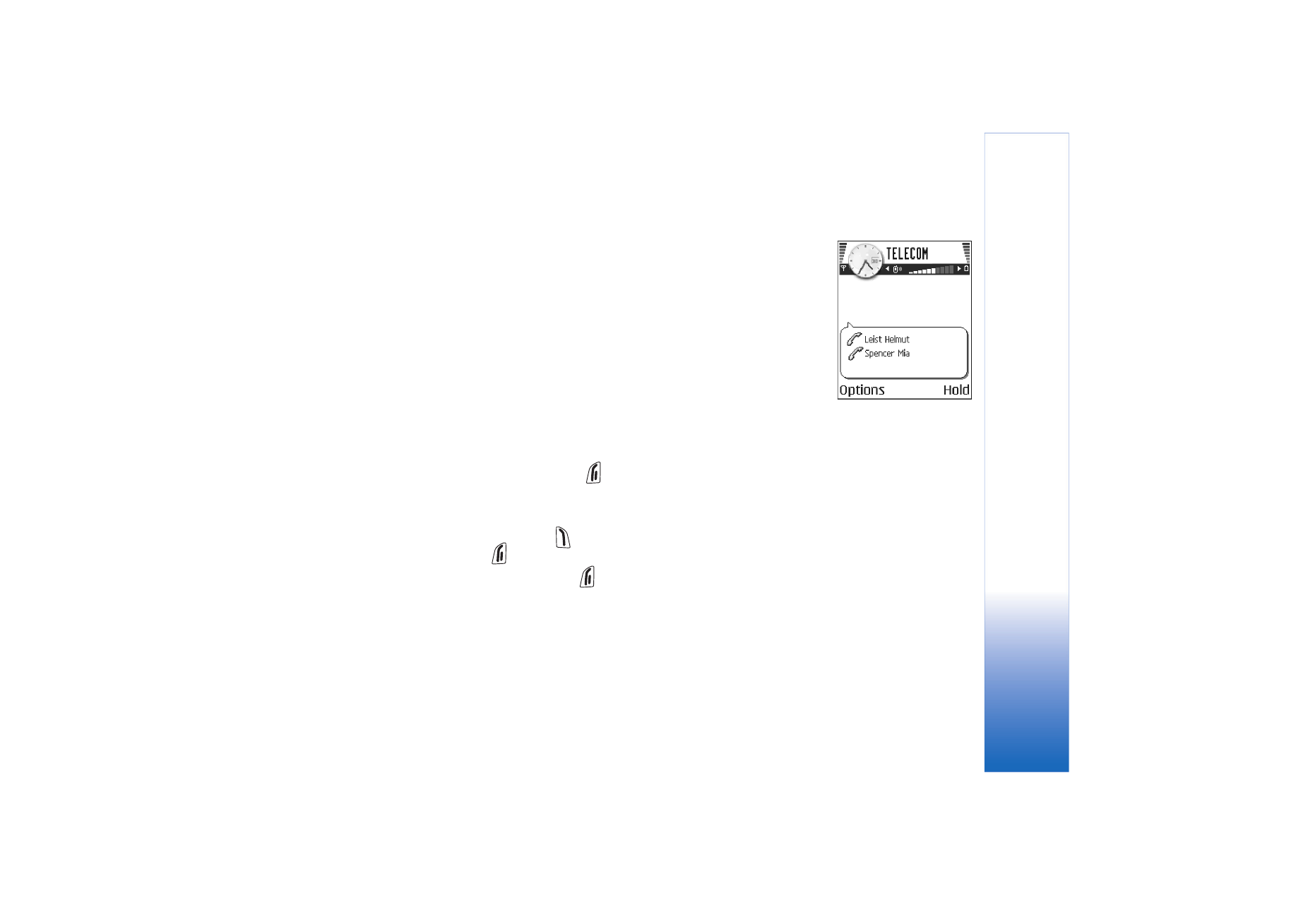
Copyright © 2004 Nokia. All rights reserved.
Your phone
17
1 Make a call to the first participant.
2 To make a call to a new participant, select
Options
→
New call
. Key in or search the
memory for the phone number of the participant and press
Call
. The first call is
automatically put on hold.
3 When the new call has been answered, join the first participant in the conference call.
Select
Options
→
Conference
.
4 To add a new person to the call, repeat step 2 and then select
Options
→
Conference
→
Add to conference
.
• To have a private conversation with one of the participants: Select
Options
→
Conference
→
Private
. Scroll to the desired participant and press
Private
. The
conference call is put on hold in your phone, and the other participants can still
continue talking with each other while you have a private discussion with one
participant only. Once you have finished the private conversation, press
Cancel
to
return to the conference call.
• To drop one participant from the conference call, select
Options
→
Conference
→
Drop participant
, then scroll to the participant and press
Drop
.
5 To end the active conference call, press
.
Answering a call
• To answer an incoming call, press
.
• To end the call, press
.
If you do not want to answer a call, press
. The caller will hear a ’line busy’ tone.
When a call comes in, press
Silence
to quickly mute the ringing tone.
Options during a call
Press
Options
during a call for some of the following options:
Fig. 5 Conference call
with two participants.
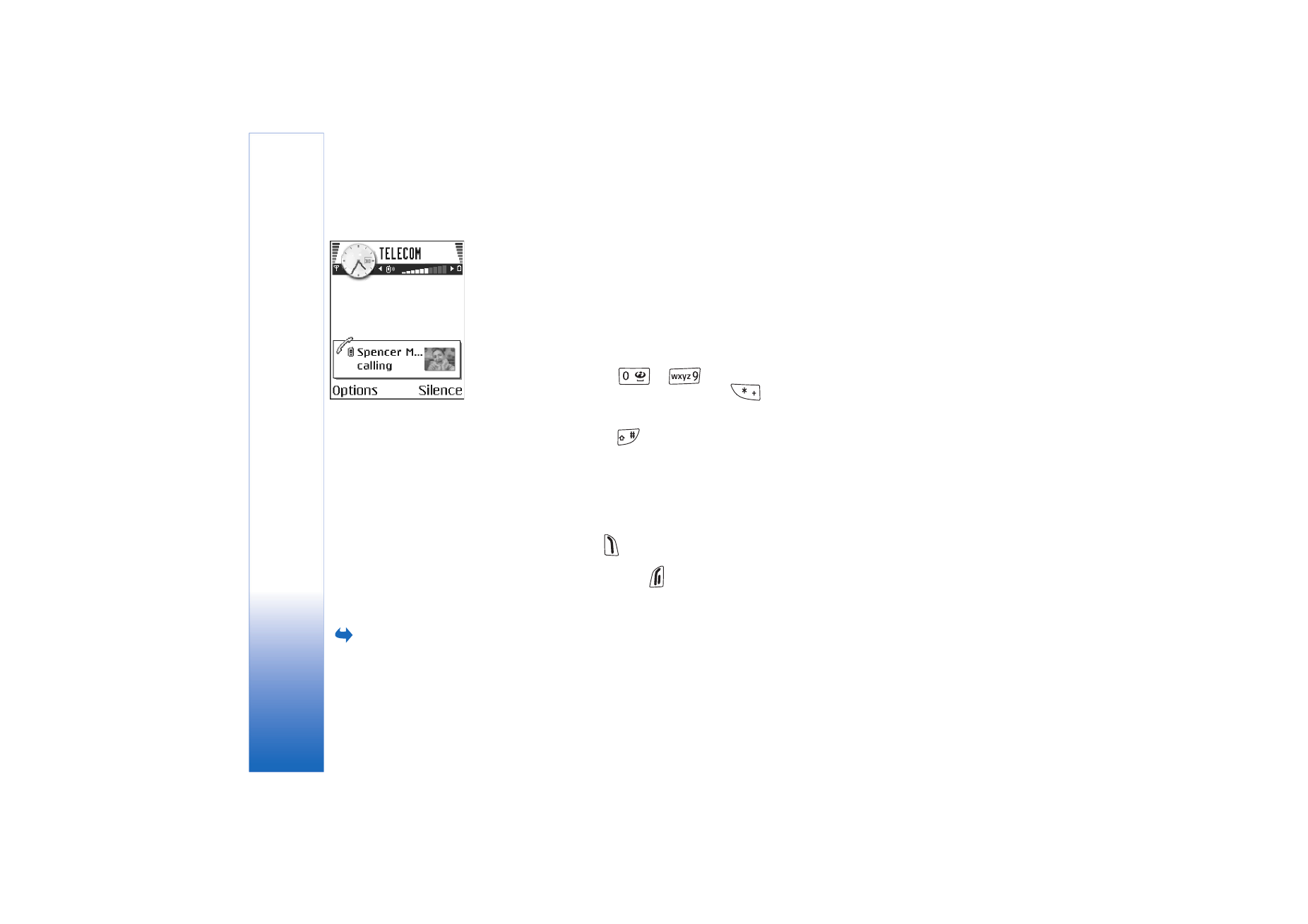
Copyright © 2004 Nokia. All rights reserved.
Your phone
18
Mute
or
Unmute
,
End active call
,
End all calls
,
Hold
or
Unhold
,
New call
,
Conference
,
Private
,
Drop participant
,
Answer
, and
Reject
.
Swap
is used to switch between the active call and the call on hold.
Transfer
is used to connect an incoming call or a call on hold with an active call and to
disconnect yourself from both calls.
Send DTMF
is used to send DTMF tone sequences, for example, passwords or bank account
numbers.
You may not have all of these options. Contact your service provider for more details.
1 Key in the digits with
-
. Each keystroke generates a DTMF tone, which
is transmitted while the call is active. Press
repeatedly to produce: *, p (inserts
a pause of approximately two seconds before, or between DTMF characters.), and w (if
you use this character, the remaining sequence is not sent until you press
Send
again
during the call). Press
to produce #.
2 To send the tone, press
OK
.
Call waiting (Network Service)
If you have activated the Call waiting service, the network will notify you of a new
incoming call while you have a call in progress.
1 During a call, press
to answer the waiting call. The first call is put on hold.
To switch between the two calls, press
Swap
.
2 To end the active call, press
.
Diverting calls (Network Service)
Go to
Menu
→
Settings
→
Call divert
.
When this network service is activated, you can direct your incoming calls to another
number, for example, to your voice mailbox number. For details, contact your service
provider.
Fig. 6 Options during a
call.

Copyright © 2004 Nokia. All rights reserved.
Your phone
19
• Select one of the divert options, for example, select
If busy
to divert voice calls when
your number is busy or when you reject incoming calls.
• Select
Options
→
Activate
to set the divert setting on,
Cancel
to set the divert setting
off, or
Check status
to check whether the divert is activated or not.
• To cancel all active diverts, select
Options
→
Cancel all diverts
.
See “Essential indicators in standby mode” on page 10.
You cannot have barring of incoming calls and call diverting active at the same time.
See
“Call barring (Network Service)” on page 72.
Log - Call register and general log
Go to
Menu
→
Log
.
In the log you can monitor phone calls, text messages, packet data connections, and data
calls registered by the phone. You can filter the log to view just one type of event and
create new contact cards based on the log information.
Connections to your remote mailbox, multimedia messaging centre, or browser pages are
shown as data calls or packet data connections in the general communications log.
GPRS data counter
Go to
Menu
→
Log
→
GPRS counter
.
The GPRS data counter allows you to check the amount of data sent and received during
packet data (GPRS) connections. This can be beneficial as you may be charged for your
GPRS connections by the amount of data sent and received.
Recent calls register
Go to
Menu
→
Log
→
Recent calls
.
The phone registers the phone numbers of missed, received, and dialled calls, and the
approximate duration of your calls. The phone registers missed and received calls only if
the network supports these functions, and the phone is switched on and is within the
network’s service area.
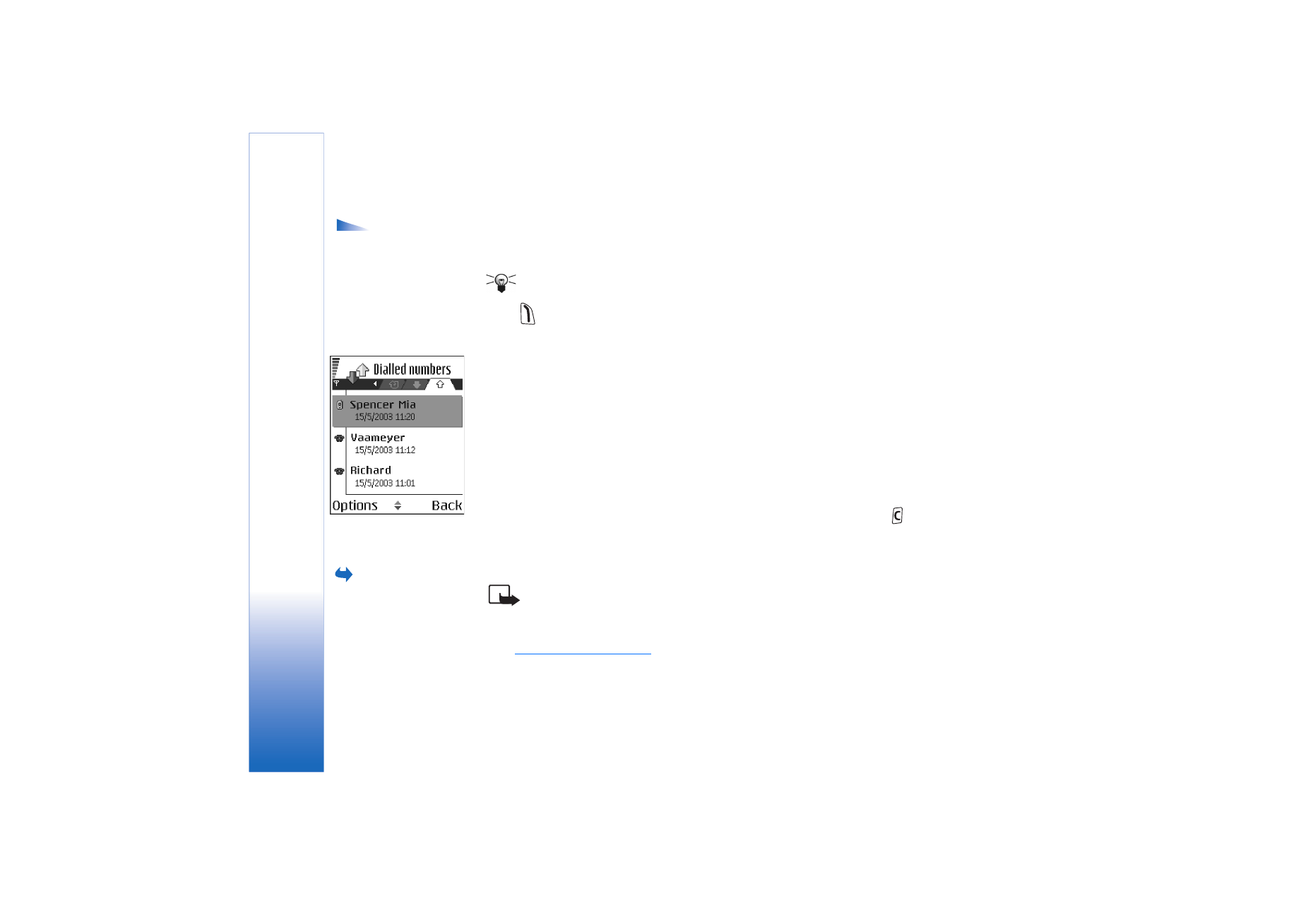
Copyright © 2004 Nokia. All rights reserved.
Your phone
20
Options in the
Missed, Received, Dialled
views:
Call
,
Create
message
,
Use number
,
Request presence
,
Delete
,
Clear list
,
Add to
Contacts
,
Help
, and
Exit
.
Missed calls and received calls
To view a list of the last 20 phone numbers from which somebody has tried to call you
without success (Network Service), go to
Log
→
Recent calls
→
Missed calls
.
Tip! When you see a note in standby mode about missed calls, press
Show
to access
the list of missed calls. To call back, scroll to the number or name you want and press
.
To view a list of the 20 numbers or names from which you have most recently accepted
calls (Network Service), go to
Log
→
Recent calls
→
Received calls
.
Dialled numbers
To view the 20 phone numbers that you have most recently called or attempted to call, go
to
Log
→
Recent calls
→
Dialled nos.
.
Erasing recent call lists
• To clear all recent call lists, select
Options
→
Clear recent calls
in the Recent calls main
view.
• To clear one of the call registers, open the register you want to erase and select
Options
→
Clear list
.
• To clear an individual event, open a register, scroll to the event, and press
.
Call duration
Go to
Menu
→
Log
→
Call duration
.
Allows you to view the duration of your incoming and outgoing calls.
Note: The actual time invoiced for calls by your service provider may vary,
depending on network features, rounding off for billing, and so forth.
Erasing call duration timers - Select
Options
→
Clear timers
. For this you need the lock
code.
See “Security” on page 74.
Fig. 7 The Dialled
numbers view.
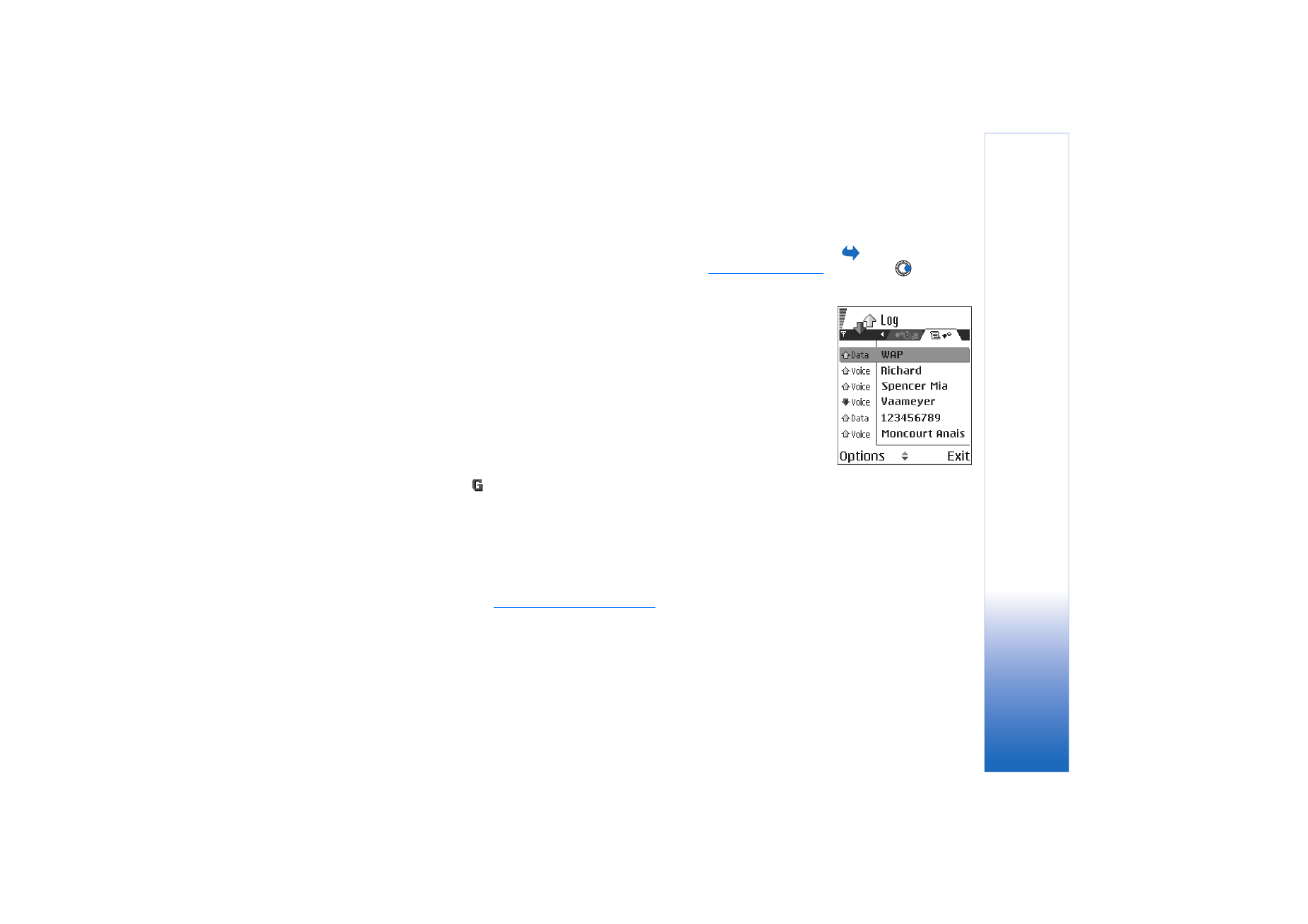
Copyright © 2004 Nokia. All rights reserved.
Your phone
21
Viewing the general log
Go to
Menu
→
Log
and press
.
In the general log, for each communication event, you can see the sender or recipient
name, phone number, name of the service provider, or access point.
See Fig. 8 on page 21.
Sub-events, such as a text message sent in more than one part and packet data
connections, are logged as one communication event.
Filtering the log
1 Select
Options
→
Filter
. A list of filters opens.
2 Scroll to a filter and press
Select
.
Erasing the contents of the log
• To erase all the log contents, Recent calls register, and Messaging delivery reports
permanently, select
Options
→
Clear log
. Confirm by pressing
Yes
.
Packet data counter and connection timer
• To view how much data, measured in kilobytes, has been transferred and how long a
certain GPRS connection has lasted, scroll to an Incoming or Outgoing event with the
access point icon
and select
Options
→
View details
.
Log settings
• Select
Options
→
Settings
. The list of settings opens.
•
Log duration
- The log events remain in the phone memory for a set number of days
after which they are automatically erased to free memory.
If you select
No log
, all the log contents, Recent calls register, and Messaging delivery
reports are permanently deleted.
•
Show call duration
.
See “Call duration” on page 20.
Fig. 8 General log of
communication events.

Copyright © 2004 Nokia. All rights reserved.
Personal information
22
Personal information
Contacts
In Contacts, you can store and manage contact information, such as names, phone
numbers, and addresses.
Options in the
Contacts main view:
Open
,
Call
,
Create
message
,
New contact
,
Open conversation
,
Edit
,
Delete
,
Duplicate
,
Add to
group
,
Belongs to groups
,
Mark/Unmark
,
Copy to
SIM direct.
,
Go to web
address
,
Send
,
Contacts
info
,
SIM directory
,
Service numbers
,
Settings
,
Help
, and
Exit
.
You can also add a personal ringing tone, voice tag, or a thumbnail image to a contact card.
You can create contact groups, which allow you to send text messages or e-mail to many
recipients at the same time.
Contact information can only be sent to or received from compatible devices.
Creating and editing contact cards
1 Press
in standby mode or go to
Menu
→
Contacts
.
2 Open Contacts and select
Options
→
New contact
.
3 Fill in the fields you want and press
Done
.
Options when
editing a contact card:
Add thumbnail
/
Remove
thumbnail
,
Add detail
,
Delete detail
,
Edit label
,
Help
, and
Exit
.
• To edit contact cards,
See “Actions common to all applications” on page 12.
• To delete contact cards, in the Contacts directory, scroll to the contact card and select
Options
→
Delete
.
• To attach a small thumbnail image to a contact card, open a contact card, select
Options
→
Edit
and then select
Options
→
Add thumbnail
. The thumbnail image is also
shown when the contact is calling you. After you attach a thumbnail image to a contact
card, you can select
Add thumbnail
to replace the image with a different thumbnail or
Remove thumbnail
to remove the thumbnail from the contact card.

Copyright © 2004 Nokia. All rights reserved.
Personal information
23
• To assign default numbers and addresses to a contact card, open a contact card and
select
Options
→
Defaults
. A pop-up window opens, listing the different options.
Copying contacts between the SIM card and phone
memory
• To copy names and numbers from a SIM card to your phone, select
Options
→
SIM
directory
, scroll to the name(s) you want to copy and select
Options
→
Copy to
Contacts
.
• If you want to copy a phone, fax, or pager number from Contacts to your SIM card, go
to Contacts, open a contact card, scroll to the number, and select
Options
→
Copy to
SIM direct.
Adding a ringing tone for a contact card or group
You can set a ringing tone for each contact card and group. When that contact or group
member calls you, the phone plays the chosen ringing tone (if the caller’s telephone
number is sent with the call and your phone recognises it).
1 Press
to open a contact card or go to the Groups list and select a contact group.
2 Select
Options
→
Ringing tone
. A list of ringing tones opens.
3 Use the scroll key to select the ringing tone you wish to use for the contact or group
and press
Select
.
• To remove the ringing tone, select
Default tone
from the list of ringing tones.
Tip! For an individual contact, the phone uses the ringing tone that was assigned
last. So, if you first change a group ringing tone and then the ringing tone of a single
contact that belongs to that group, the ringing tone of the single contact is used.

Copyright © 2004 Nokia. All rights reserved.
Personal information
24
Voice dialling
You can make a phone call by saying a voice tag that has been added to a contact card.
Any spoken word(s) can be a voice tag.
• When recording, hold the phone at a short distance away from your mouth. After the
starting tone, clearly pronounce the word, or words, you want to record as a voice tag.
Before using voice tags, note that:
• Voice tags are not language-dependent. They are dependent on the speaker's voice.
• You must say the name exactly as you said it when you recorded it.
• Voice tags are sensitive to background noise. Record voice tags and use them in a quiet
environment.
• Very short names are not accepted. Use long names and avoid similar names for
different numbers.
Note: Using voice tags may be difficult in a noisy environment or during an
emergency, so you should not rely solely upon voice dialling in all circumstances.
Adding a voice tag to a phone number
Voice tags can only be added to phone numbers stored in the phone’s memory.
See
“Copying contacts between the SIM card and phone memory” on page 23.
1 In the Contacts main view, scroll to the contact that you want to add a voice tag to,
and press
to open the contact card.
2 Scroll to the number that you want to add the voice tag to, and select
Options
→
Add
voice tag
.
3 Press
Start
to record a voice tag. After the starting tone, clearly pronounce the word(s)
you want to record as a voice tag.
4 After recording, the phone plays the recorded tag and the note
Playing voice tag
is
displayed.
5 When the voice tag has been successfully saved, the note
Voice tag saved
is displayed
and a beep sounds. A symbol
can be seen next to the number in the contact card.

Copyright © 2004 Nokia. All rights reserved.
Personal information
25
Making a call by saying a voice tag
1 In standby mode, press and hold
. A short tone is played and the note
Speak now
is displayed.
2 When you are making a call by using a voice tag, hold the phone at a short distance
away from your mouth and face and pronounce the voice tag clearly.
3 The phone plays the original voice tag, displays the name and number, and after a few
seconds dials the number of the recognised voice tag.
• If the phone plays the wrong voice tag, or you want to retry voice dialling, press
Retry
.
Voice dialling cannot be used when a data call or a GPRS connection is active.
Assigning speed dialling keys
Speed dialling is a quick way to call frequently used numbers. You can assign speed dialling
keys to eight phone numbers. Number 1 is reserved for the voice mailbox.
1 Open the contact card for which you want a speed dialling key and select
Options
→
Assign speed dial
. The speed dialling grid opens, showing you the numbers from 1-9.
2 Scroll to a number and press
Assign
. When you return to the contact information view,
you can see the speed dial icon next to the number.
• To call the contact by speed dialling, go to standby mode and press the speed dialling
key and
.
Viewing subscribed contacts
Options in the
Subscribed contacts view:
Open
,
Call
,
Create message
,
Open conversation
,
Unsubscribe
,
Subscribe new
,
Mark/Unmark
,
My Presence
,
Settings
,
Help
, and
Exit
.
In the Contacts directory, scroll right to the second tab to open the subscribed contacts
list. This list allows you to view presence data, including availability and instant messaging
(chat) status, for all subscribed contacts.
See “Presence (Network Service)” on page 26.
See
“Chat (Network Service)” on page 94.

Copyright © 2004 Nokia. All rights reserved.
Personal information
26
Managing contact groups
Options in the
Groups list view:
Open
,
New group
,
Delete
,
Rename
,
Ringing tone
,
Contacts info
,
Settings
,
Help
, and
Exit
.
Creating contact groups
1 In the Contacts directory, press
to open the Groups list.
2 Select
Options
→
New group
.
3 Write a name for the group or use the default name
Group 1
and press
OK
.
Adding members to a group
1 In the Contacts directory, scroll to the contact you want to add to a group and select
Options
→
Add to group:
. A list of available groups opens.
2 Scroll to the group to which you want to add the contact and press
.
Presence (Network Service)
Go to
Menu
→
Extras
→
Presence
.
Use Presence to inform others when, where and how you want to be contacted. Presence
allows you to view and create a dynamic profile of your contact details, visible to other
users of the service, to share information or control services. Presence information can
include your availability, whether you prefer people to call or send messages, where you
are and what you are doing.
See Fig. 9 on page 27.
Options in the
Presence view:
Open
,
My
availability
,
Viewers
,
Update presence
,
Login
,
Logout
,
Settings
,
Help
,
and
Exit
.
Before you can use Presence, you need to find a service that you want to use and then save
the settings of that service. You may receive the settings in a special text message, called
a smart message, from the service provider that offers the Presence service.
See “Receiving
smart messages” on page 52.
For more information, contact your service provider.
The Presence application allows you to change your own published information and
manage who is authorised to see your presence. To view the presence information of
others, you must use Contacts.
See “Contacts” on page 22.

Copyright © 2004 Nokia. All rights reserved.
Personal information
27
Changing your availability information
Select
Options
→
My availability
and select:
•
Available
- You are available for people to call or send you messages, for example, your
phone is in general profile.
See “Profiles” on page 84.
•
Busy
- You may be available for people to call or send you messages, for example, your
phone is in meeting profile.
•
Not available
- You are not available for people to call or send you messages, for
example, your phone is in silent profile.
Changing who can view your Presence information
Select
Options
→
Viewers
and select:
•
Public pres.
- Displays limited information, for managing ways for people to contact you.
This is available to anyone you have not blocked.
•
My availability
- Select
Available
,
Busy
, or
Not available
.
•
Viewers
- Opens the
Current viewers
view of your
Public pres.
.
See “Public viewers” on
page 28.
•
Update presence
- Updates your presence information to the presence server.
•
Login
/
Logout
- Connect to or disconnect from the presence server.
See “Chat and
Presence servers” on page 100.
•
Settings
- To manage the publishing of your presence information.
•
Private pres.
- Displays private information, so you can share more personal information.
This is only available to those that you have authorised to view your private
information. You can select the following options:
•
My availability
- Select
Available
,
Busy
, or
Not available
.
•
My presence msg.
- You can write a text message of up to 40 characters to describe
your current availability.
•
My presence logo
- You can add a logo to your availability information. Logo files are
stored in the Gallery.
See “Gallery” on page 41.
Fig. 9 The Private
Presence view.

Copyright © 2004 Nokia. All rights reserved.
Personal information
28
•
Viewers
- Opens the
Private list
view of your
Private pres.
.
See “Private viewers” on
page 28.
•
Update presence
- Updates your presence information to the presence server.
•
Login
/
Logout
- Connect to or disconnect from the presence server.
See “Chat and
Presence servers” on page 100.
•
Settings
- To manage the publishing of your presence.
•
Blocked pres.
- Displays a screen containing no personal details.
See “Blocked viewers”
on page 29.
Public viewers
Go to
Public pres.
and select
Options
→
Viewers
→
Current viewers
to see the names, phone
numbers, or user IDs of the viewers who you do not allow to view your private presence
messages, but who are currently viewing your public presence. You can scroll to a viewer,
press
Options
, and select:
•
Add to private list
- Allows the viewer to also see your private presence.
•
Block
- Prevents the viewer from seeing your presence information.
•
Add to contacts
- Adds the viewer to your Contacts directory.
•
Refresh lists
- Connect to the presence server to update the viewer lists. This option is
only available when you are offline.
Private viewers
Go to
Private pres.
and select
Options
→
Viewers
→
Private list
to see the names, phone
numbers, or user IDs of the viewers who you allow to view your private presence messages.
To prevent a viewer from seeing your private presence messages, scroll to the viewer and
press
. You can scroll to a viewer, press
Options
, and select:
•
Add new
- Add a new viewer manually or from your Contacts directory.
You can only select a contact who has a user ID in the contact card.
•
Block
- Prevents the viewer from seeing your presence information.
•
Add to contacts
- Adds the viewer to your Contacts directory.

Copyright © 2004 Nokia. All rights reserved.
Personal information
29
•
Remove from list
- Removes the viewer from the private list. The option is available also
when there are marked items as selected. If the list is empty the option is not available.
•
View details
- Shows the user ID information of the viewer.
•
Refresh lists
- Connect to the presence server to update the viewer lists. This option is
only available when you are offline.
Blocked viewers
Go to
Options
→
Viewers
→
Blocked pres.
to see the viewers you prevented from seeing your
public and private presence messages. To allow a viewer to see your presence information,
scroll to a viewer and press
. You can scroll to a viewer, press
Options
, and select:
•
Add to private list
- Allows the viewer to also see your private presence.
•
Add new
- Add a new viewer manually or from your Contacts directory.
You can only select a contact who has a user ID in the contact card.
•
Add to contacts
- Adds the viewer to your Contacts directory.
•
View details
- Shows the user ID information of the viewer.
•
Refresh lists
- Connect to the presence server to update the viewer lists. This option is
only available when you are offline.
Updating your Presence information
Go to
Menu
→
Extras
→
Presence
.
Once the connection has been established:
1 Key in your user ID and password and press
to login.
You obtain the user ID and password from your service provider.
2 Select
Options
→
Update presence
. The option is available when you are logged into the
server and have changed your presence information in
Private pres.
or
Public pres.
view
and not updated it.
3 To logout, select
Options
→
Logout
.

Copyright © 2004 Nokia. All rights reserved.
Personal information
30
Presence settings
Select
Options
→
Settings
from the Presence main menu.
See “Chat and Presence servers” on page 100.
•
Show to
- Select:
•
Private & public
- Both public and private presence is published.
•
Private viewers
- Only private viewers can see your presence information.
•
Public viewers
- Both public and private viewers see your public presence information.
•
No one
- Your presence information is not published.
•
Sync. with Profiles
- Defines which Presence attributes are changed when you change
your profile. Select:
•
Off
- The presence attributes are not changed, even if you change your profile.
•
On
- Both
My availability
and
My presence msg.
are changed when you change your
profile.
•
Availability only
-
My presence msg.
is not changed when you change your profile.
•
Private msg. only
-
My availability
is not changed when you change your profile.
Positioning (Network Service)
Go to
Menu
→
Tools
→
Positioning
.
Positioning
allows the network to detect the position of your phone. By enabling or
disabling
Positioning
, you choose when your position information is provided to the
network.
To enable
Positioning
in your phone, select
Settings
→
Positioning
→
On
.
When you receive a
Position request
, a message is displayed showing the service that is
making the request. Press
Accept
to allow your position information to be sent, or press
Reject
to deny the request.
Position request
messages are logged in the
Recv. requests
list. To view them, select
Menu
→
Positioning
→
Recv. requests
. The icon beside each request indicates whether the request is

Copyright © 2004 Nokia. All rights reserved.
Personal information
31
new, rejected, or accepted. If you want to see details of a request, scroll to the request and
press
. If you want to clear the
Recv. requests
list, select
Options
→
Clear list
.
Calendar
In Calendar, you can keep track of your appointments, meetings, birthdays, anniversaries,
and other events. You can also set a calendar alarm to remind you of upcoming events.
Calendar uses shared memory.
See “Shared memory” on page 14.
Creating calendar entries
1 Go to
Menu
→
Calendar
2 Select
Options
→
New entry
and select:
•
Meeting
to remind you of an appointment that has a specific date and time.
•
Memo
to write a general entry for a day.
•
Anniversary
to remind you of birthdays or special dates. Anniversary entries are
repeated every year.
3 Fill in the fields. Use the scroll key to move between fields.
•
Subject
/
Occasion
- Write a description of the event.
•
Location
- The place of a meeting, optional.
•
Start time
,
End time
,
Start date
, and
End date
.
•
Alarm
- Press
to activate the fields for
Alarm time
and
Alarm date
.
•
Repeat
- Press
to change the entry to be repeating. Shown with
in the Day
view.
•
Repeat until
- You can set an ending date for the repeated entry, for example, the
ending date of a weekly course you are taking. This option is shown only if you have
selected to repeat the event.
•
Synchronisation
-
Private
- After synchronisation the calendar entry can be seen only
by you and it will not be shown to others even if they have online access to view the
calendar.
Public
- The calendar entry is shown to others who have access to view your
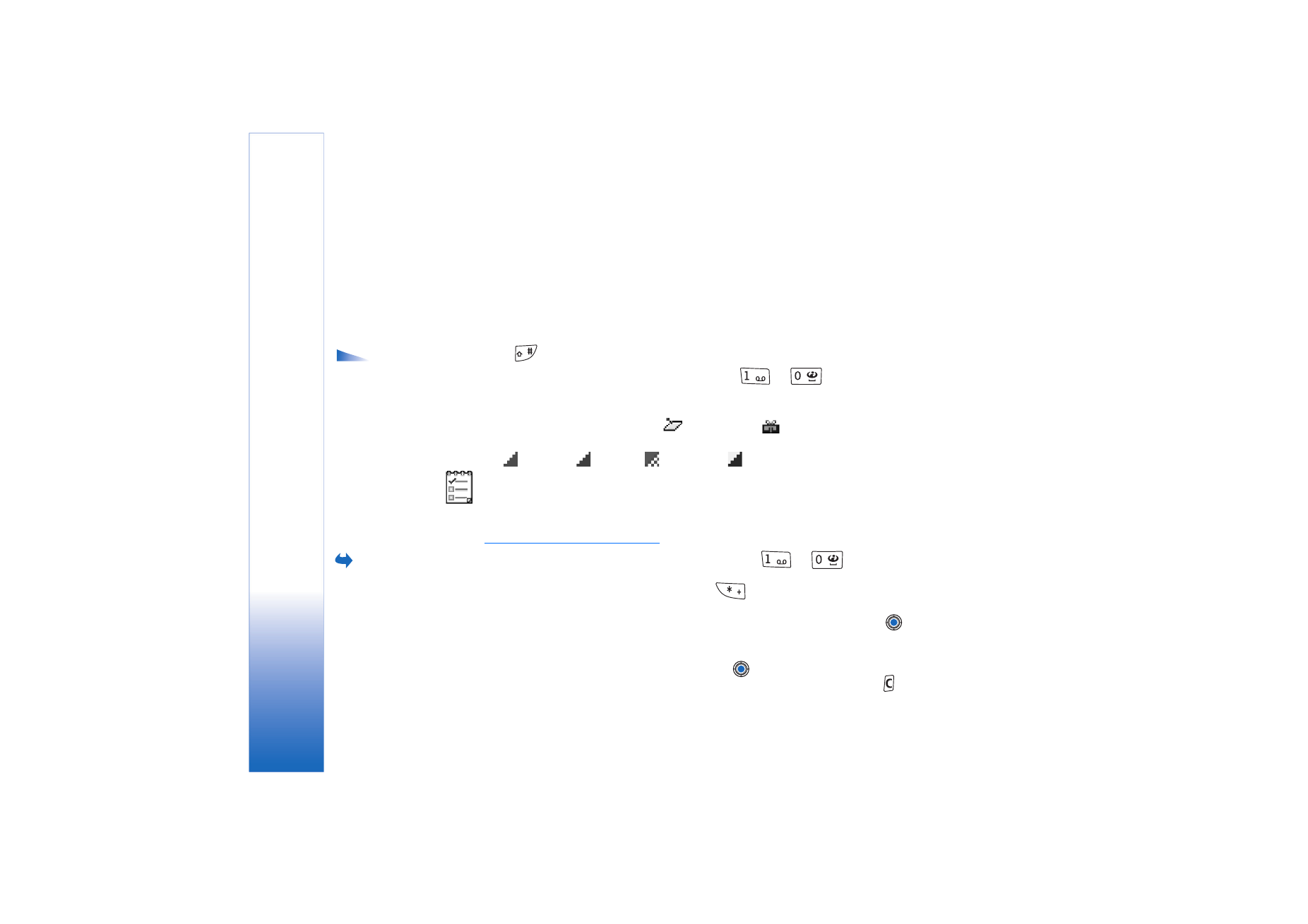
Copyright © 2004 Nokia. All rights reserved.
Personal information
32
calendar online.
None
- The calendar entry will not be copied when you synchronise
your calendar.
4 To save the entry, press
Done
.
If you are editing or deleting a repeated entry, choose how you want the changes to take
effect:
All occurrences
- all repeated entries are changed /
This entry only
- only the current
entry will be changed.
Calendar views
Options in the
different calendar views:
Open
,
New entry
,
Week
view
/
Month view
,
Delete
,
Go to date
,
Send
,
Settings
,
Help
, and
Exit
.
Press
in the Month, Week, or Day views to automatically highlight today’s date.
To write a calendar entry, press any number key (
-
) in any calendar view.
A Meeting entry is opened and the characters you keyed in are added to the
Subject
field.
• To go to a certain date, select
Options
→
Go to date
. Write the date and press
OK
.
• Icons in Day and Week views:
-
Memo
, and
-
Anniversary
.
• Synchronisation icons in Month view:
-
Private
,
-
Public
,
-
None
, and
- the day has more than one entry.
To-do
In To-do you can keep a list of tasks that you need to do. The To-do list uses shared memory.
See “Shared memory” on page 14.
Go to
Menu
→
To-do
.
1 To start to write a to-do note, press any digitkey (
-
). The editor opens
and the cursor blinks after the letters you have keyed in.
2 Write the task in the
Subject
field. Press
to add special characters.
• To set the due date for the task, scroll to the
Due date
field and key in a date.
• To set a priority for the to-do note, scroll to the
Priority
field and press
.
3 To save the to-do note, press
Done
. If you remove all characters and press
Done
, the
note will be deleted, even if you edit a previously saved note.
• To open a to-do note, scroll to it and press
.
• To delete a to-do note, scroll to it and select
Options
→
Delete
or press
.

Copyright © 2004 Nokia. All rights reserved.
Personal information
33
• To mark a to-do note as completed, scroll to it and select
Options
→
Mark as done
.
• To restore a to-do note, select
Options
→
Mark as not done
.
Importing data from compatible Nokia
phones
You can move calendar, contacts, and to-do data from compatible Nokia phones to your
phone using the Nokia PC Suite 6.3 Content Copier application on a compatible PC.
Instructions for using the application can be found in the help function of PC Suite on the
CD-ROM.
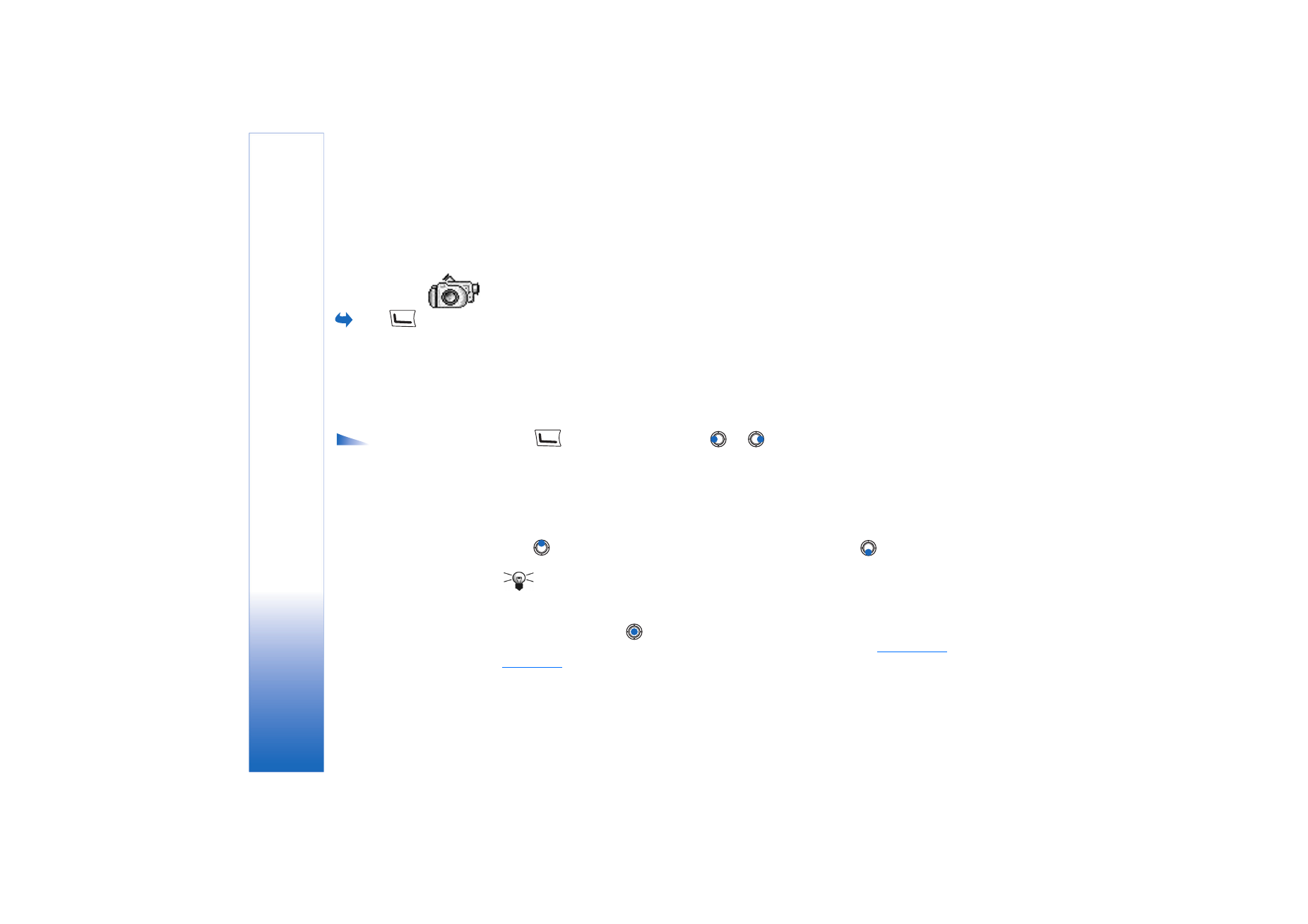
Copyright © 2004 Nokia. All rights reserved.
Multimedia
34
Multimedia
Camera
Press
in
standby mode or go to
Menu
→
Camera
.
With the
Camera
application you can take pictures and record videos while on the move.
The images are automatically saved in the Gallery application, where you can rename them
and organise them in folders. You can also send images in a multimedia message, as an e-
mail attachment, or via a Bluetooth connection. The camera produces JPEG images and
video clips are recorded in the 3GPP file format with the .3gp file extension.
Taking pictures
Options before
taking a picture:
Capture
,
Activate night mode
/
Deact. night mode
,
Go to
Gallery
,
Self-timer
,
Settings
,
Help
, and
Exit
.
1 Press
in standby mode and press
or
to move to the
Image
tab. The
Camera
application opens and you can see the view to be captured.
You can see the viewfinder and the cropping lines, which show you the image area to
be captured.
You can also see the image counter, which shows you how many images, depending on
the selected picture quality, fit in the memory of your phone or memory card, if you use
one.
2 Press
to zoom in on your subject before taking the picture. Press
to zoom out
again. The zoom indicator on the display shows the zoom level.
Tip! The resolution of a zoomed picture is lower than that of a non-zoomed
picture, but the image remains the same size. You may notice the difference in
image quality if viewed on a PC, for example.
3 To take a picture, press
. Do not move the phone before the
Camera
application
starts to save the image. The image is saved automatically in the Gallery.
See “Gallery”
on page 41.

Copyright © 2004 Nokia. All rights reserved.
Multimedia
35
Tip! To take a photo immediately after another, select
Options
→
Settings
→
Image
→
Show captured image
. Select
No
. The photos do not remain on the display
after being taken, are saved in the Gallery, and the camera is ready for use again.
Camera
goes into battery saving mode if there have been no key presses within a minute.
To continue taking pictures, press
.
Options after a
picture has been taken:
New
,
Delete
,
Send
,
Set as
wallpaper
,
Rename image
,
Go to Gallery
,
Settings
,
Help
, and
Exit
.
After the image has been saved:
• If you do not want to save the image, select
Options
→
Delete
.
• To return to the viewfinder to take a new picture, press
.
You can insert an image into a contact card.
See “Creating and editing contact cards” on
page 22.
Self-timer
Use the self-timer to delay the taking of a picture, so that you can include yourself in the
picture.
1 Select
Options
→
Self-timer
.
2 Select the delay
10 seconds
,
20 seconds
, or
30 seconds
.
3 Press
Activate
. The camera will take the picture after the selected delay has elapsed.
Settings
In the
Camera
application settings, you can adjust the image quality setting, select
whether photos remain on the display after being taken, change the default image name,
and change the memory location of saved images.
1 Select
Options
→
Settings
→
Image
.
2 Scroll to the setting you want to change:
•
Image quality
-
High
,
Normal
, and
Basic
. The better the image quality, the more
memory the image consumes.
•
Show captured image
- To take a photo immediately after another, select
No
. The
photos do not remain on the display after being taken, are saved in the Gallery, and
the camera is ready for use again.
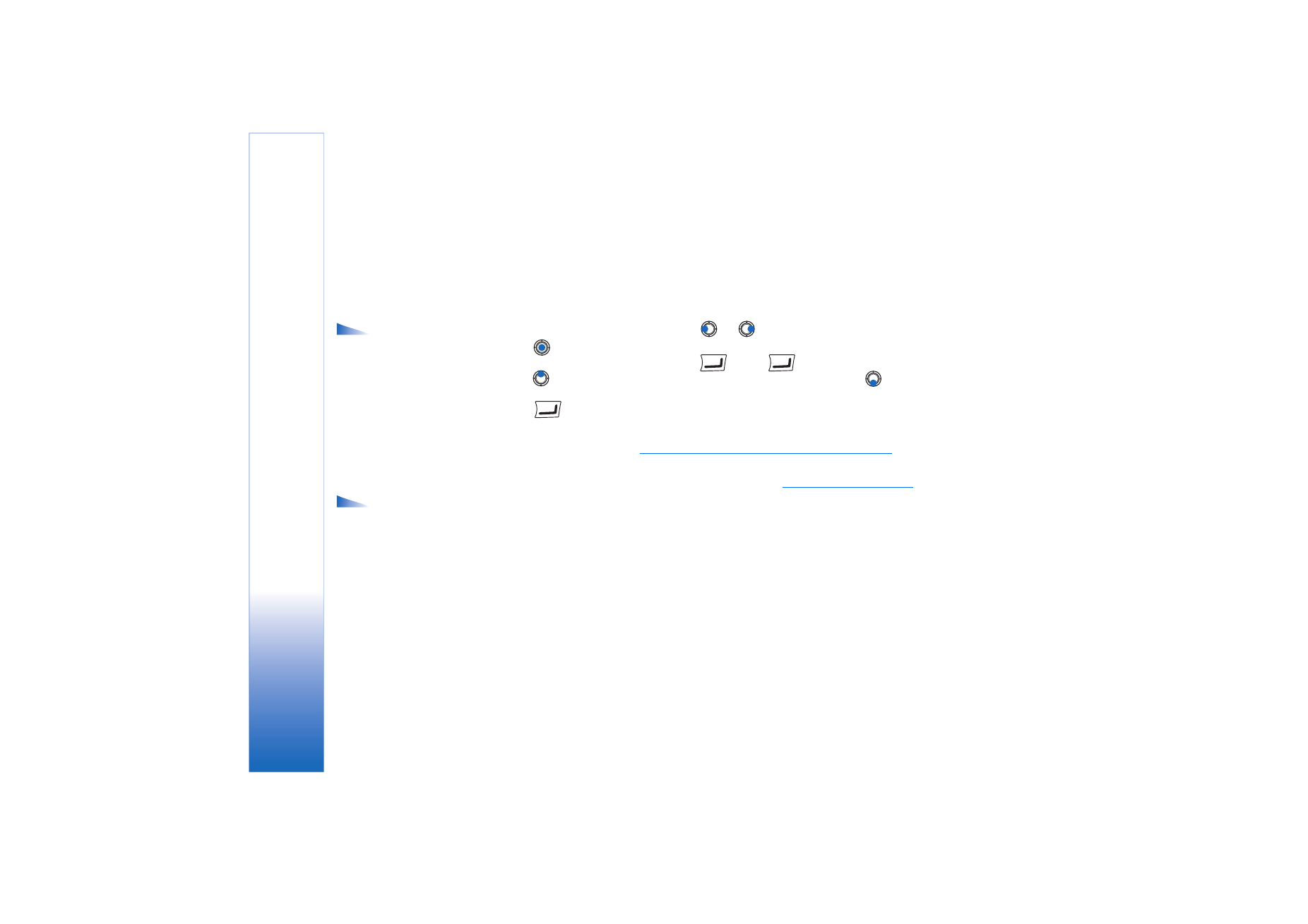
Copyright © 2004 Nokia. All rights reserved.
Multimedia
36
•
Default image name
- By default,
Camera
names images in the format ‘Image.jpg’.
Default image name
allows you to set a name for the images stored.
•
Memory in use
- Select whether you want to store your images in the phone memory
or on the memory card, if you use one.
Recording videos
Options before
recording a video:
Record
,
Activate night mode
/
Deact. night mode
,
Mute
/
Unmute
,
Go to Gallery
,
Settings
,
Help
, and
Exit
.
Press
Camera
in standby mode and press
or
to move to the
Video
tab.
• Press
to start recording.
• To pause recording at any time, press
. Press
again, to resume recording.
• Press
to zoom in on your subject before, or during, recording. Press
to zoom out
again.
• Press
to stop recording.
The video clip is saved to either the phone’s memory or the memory card, depending on the
setting of your
Memory in use
.
See “Setting up your Video recorder” on page 36.
• To immediately play the video clip you just recorded, select
Options
→
Play
.
• To play previously saved video clips, go to the Gallery.
See “Gallery” on page 41.
Options after you
have recorded a video:
New
,
Play
,
Delete
,
Send
,
Rename
,
Go to Gallery
,
Settings
,
Help
, and
Exit
.
Setting up your Video recorder
Use the following settings to define how videos are recorded.
1 Select
Options
→
Settings
→
Video
.
2 Scroll to the setting you want to change:
•
Length
- Select:
•
Maximum
- The length of the video recording is restricted to 10 minutes.
•
Short
- To record video clips up to 95 kB in size, which relates to approximately 10
seconds in duration, so that they can be conveniently sent as a multimedia
message.
•
Video resolution
- Select 128x96 or 176x144.
•
Default video name
- Define a default name.
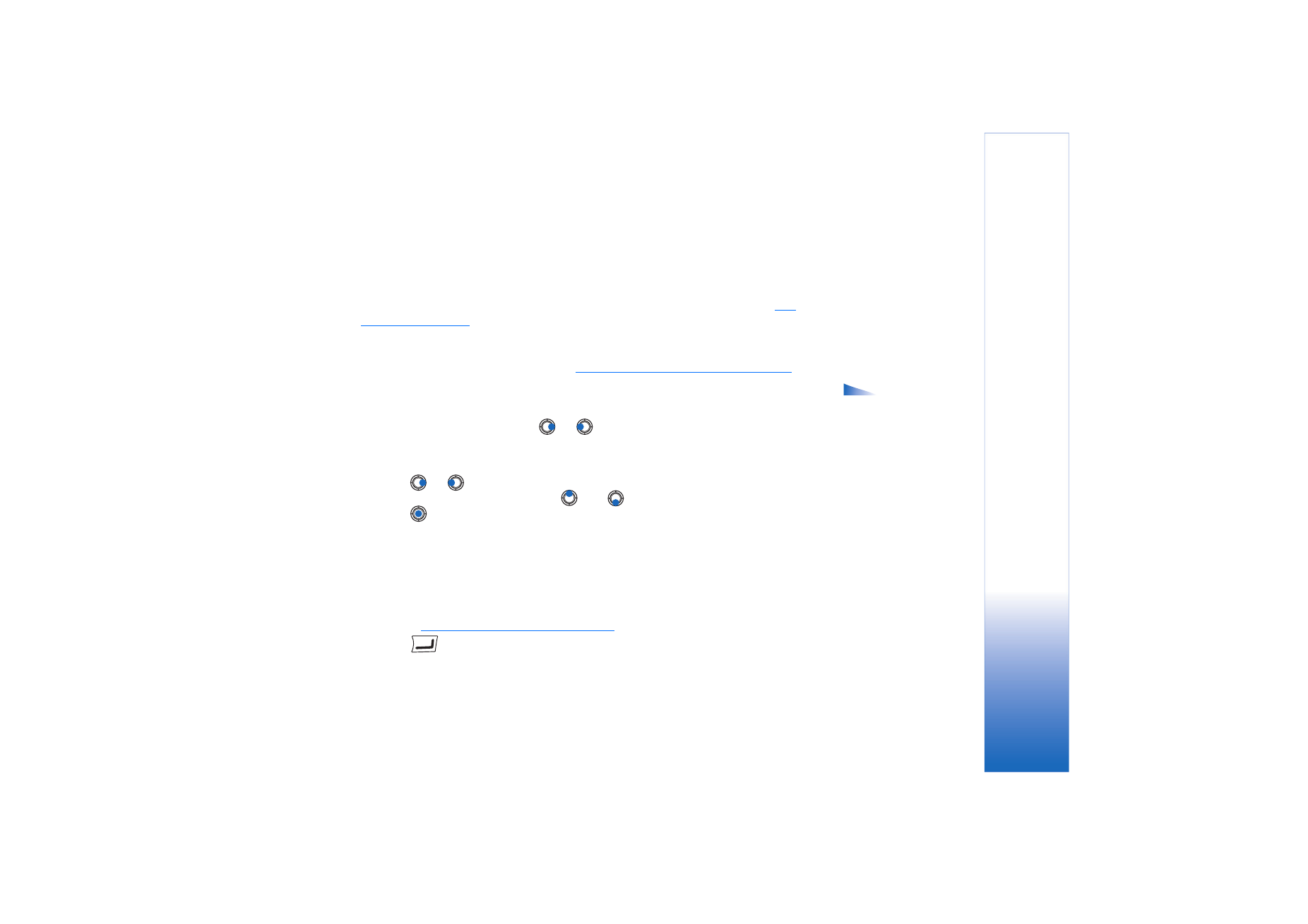
Copyright © 2004 Nokia. All rights reserved.
Multimedia
37
•
Memory in use
- Define the memory store. Choices are phone’s memory or memory
card, if one is used.
Viewing images
Pictures taken with the
Camera
application are stored as images in the Gallery.
See
“Gallery” on page 41.
Images can be sent to you in a multimedia or picture message, as an
e- mail attachment, or via Bluetooth. After receiving an image in Inbox, you need to save
it in the phone memory or on a memory card. You can save graphics sent to you in picture
messages to the Picture messages folder.
See “Picture messages folder” on page 42.
Options when
viewing an image:
Send
,
Set as wallpaper
,
Rotate
,
Zoom in
,
Zoom out
,
Full
screen
,
Delete
,
Rename
,
View details
,
Add to ’Go to’
,
Help
, and
Exit
.
Select an image from the list of images in the
Images
folder in the Gallery to start the image
viewer and display the image.
When viewing an image, pressing
or
takes you to the next or previous image in
the current folder.
In the images thumbnail view:
1 Press
or
to move between the phone and memory card.
2 To browse the list of images, press
and
.
3 Press
to open an image. When the image is open, you can see the name of the
image.
You can view animated GIF files in the same way as other images.
Zooming on a saved image
1 Select
Options
→
Zoom in
or
Zoom out
. You can see the zooming ratio at the top of the
display.
See “Keyboard shortcuts” on page 38.
2 Press
to return to the initial view. The zooming ratio is not stored permanently.
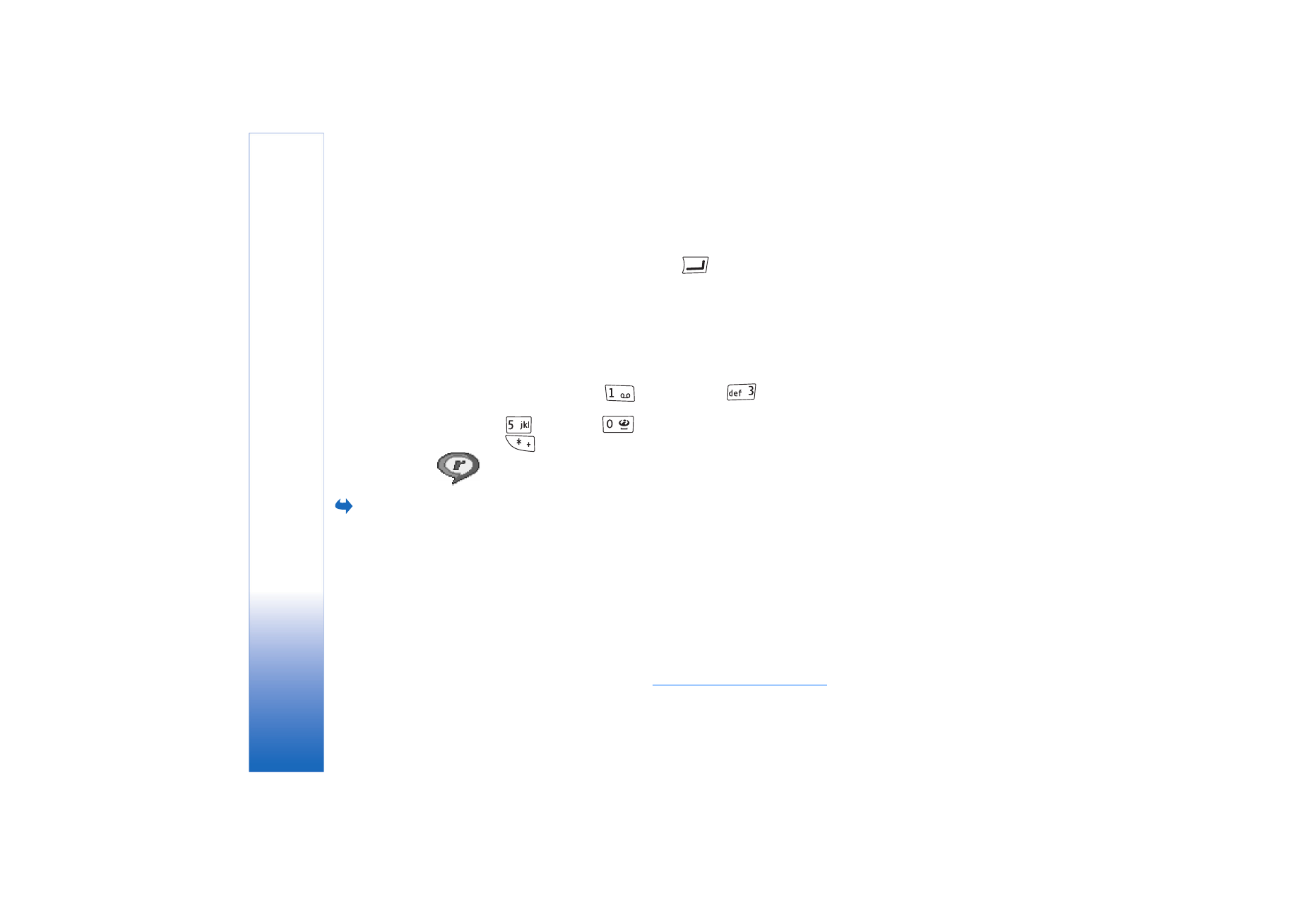
Copyright © 2004 Nokia. All rights reserved.
Multimedia
38
Full screen
When you select
Options
→
Full screen
, the panes around the image are removed so that
you can see more of the image. Press
to return to the initial view.
Moving the focus
When you are zooming an image, use the scroll key to move the focus to the left, right, up,
or down, so that you can take a closer look at one part of the image, for example, its upper
right corner.
Keyboard shortcuts
• Rotate 90 degrees:
- anticlockwise,
- clockwise. The rotation status is
not stored permanently.
•
- zoom in,
- zoom out, press and hold to return to the normal view.
•
- change between full screen and normal view.
RealPlayer™
Go to
Menu
→
RealPlayer
.
With RealPlayer™, you can play local media files stored in the phone memory, or memory
card, or stream media files over the air from a streaming link. The streaming link can be
activated during a browsing session or stored in the phone memory, or memory card.
Media files are video, music or audio clips. Files with the extensions .3gp, .amr, .mp4, .ra,
.rv, .rm and .ram are supported by RealPlayer.
RealPlayer does not necessarily support all file formats or all the variations of a file
formats. For example, RealPlayer will attempt to open all .mp4 files. However, some .mp4
files may include content that is not compliant with 3GPP standards and, therefore, is not
supported by this phone. In this case, the operation might fail and result in partial playback
or in an error message.
RealPlayer uses shared memory.
See “Shared memory” on page 14.

Copyright © 2004 Nokia. All rights reserved.
Multimedia
39
Options in
RealPlayer when a clip
has been selected (the
available options may
vary):
Play
,
Continue
,
Stop
,
Mute
,
Unmute
,
Clip details
,
Send
,
Settings
,
Help
, and
Exit
.
Playing media files
• To play a media file stored in your phone’s memory or memory card, select
Options
→
Open
and:
•
Most recent clips
- To play one of the last 6 files played in RealPlayer, or
•
Saved clip
- To play a file saved in the Gallery.
See “Gallery” on page 41.
Scroll to a file and press
to play the file.
• To stream content over the air:
• Select a streaming link saved in the Gallery. Before your live content begins
streaming, your phone will connect to the site and load the file.
• Open the link to a file in the browser.
To stream live content, you must first configure your default access point.
See “Access
points” on page 68.
Many service providers will require you to use an Internet Access Point (IAP) for your
default access point. Other service providers allow you to use a WAP access point. Contact
your service provider for more information.
In RealPlayer, you can only open an rtsp:// URL address. You cannot open an http:// URL
address, however RealPlayer will recognise an http link to a .ram file since a .ram file is a
text file containing a rtsp link.
Shortcuts during play
When a media file is playing use the scroll key to seek (move quickly through the media
file), and to mute the sound, as follows:
Press and hold
to seek forwards, or press and hold
to seek backwards through the
media file.
Press and hold
until the
indicator is displayed to mute the sound.
Press and hold
until you see the
indicator to turn on the sound.
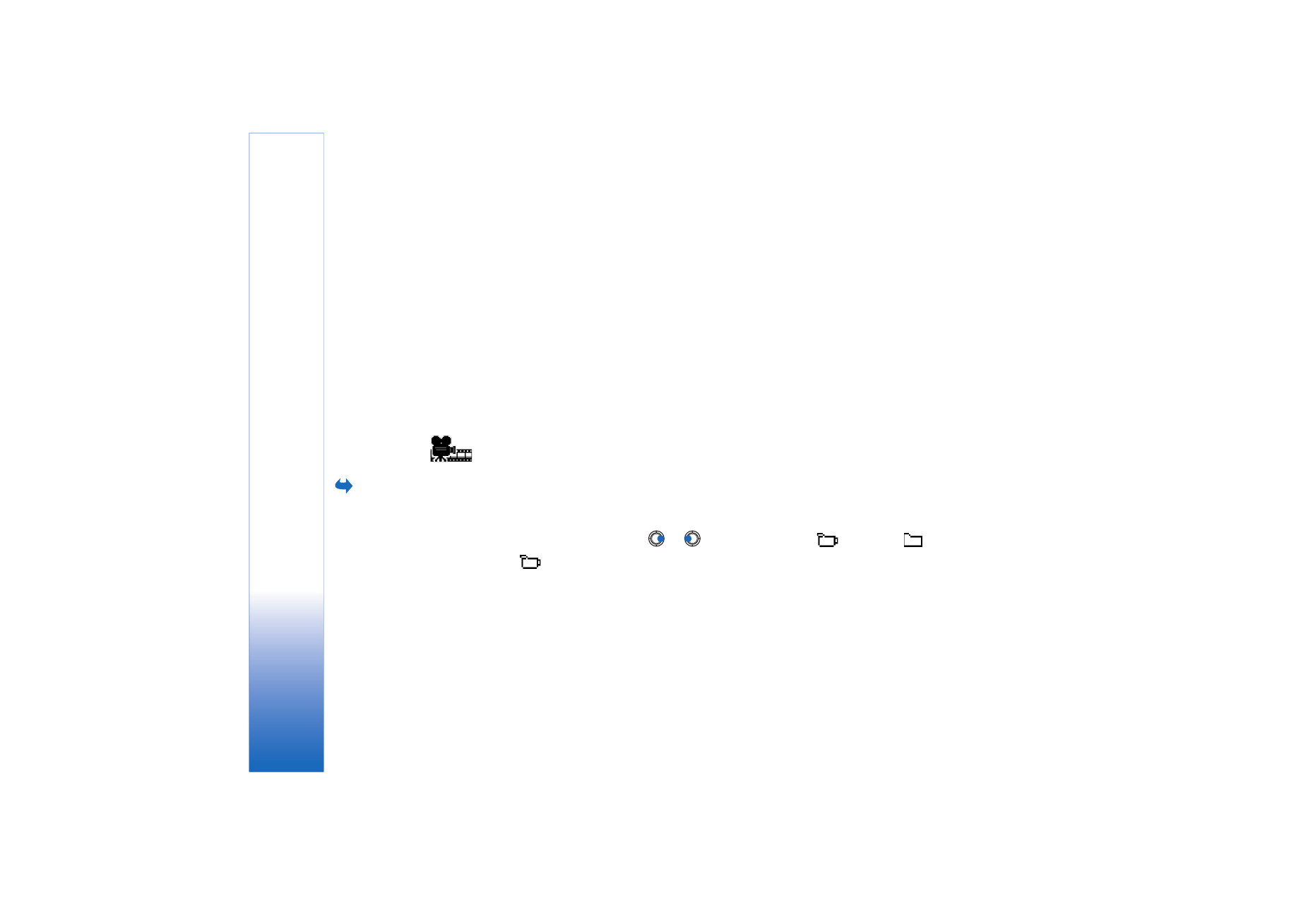
Copyright © 2004 Nokia. All rights reserved.
Multimedia
40
Changing the settings
Select
Options
→
Settings
then either
Video
,
Audio
or
Connection
.
Select
Video
to change the following settings:
•
Contrast
- Open the slider view to change the contrast.
•
Repeat
- Choose
On
to have the playing video file restart automatically once it has
finished.
Select
Audio
to change the following settings:
•
Repeat
- Choose
On
to have the playing audio file restart automatically once it has
finished.
•
Random play
- Choose
On
to select a random order for playlist items.
Select
Connection
to change the connection settings.
Movie director
Go to
Menu
→
Movie
director
.
Use
Movie director
to create edited video clips which may contain video, sound, and text.
Editing is carried out automatically according to the style that you select. The style
determines the transitions and visual effects that are used in the video clip.
Open
Movie director
and press
or
to move between the
tab and the
tab.
In the
tab, you can select:
•
Quick muvee
- Creates video clips suitable to be sent via multimedia (MMS). You can
select several video clips and the style you want to apply to them. The duration of the
Quick muvee
video clip is typically less than 10 seconds.
•
Custom muvee
- You can select video clips and apply a style, music and message, set the
duration and preview the video clip before saving. Define the following:
•
Viideo
- Select the source file or files you want to use. Select
Mark/Unmark
,
Play
or
Capture
.

Copyright © 2004 Nokia. All rights reserved.
Multimedia
41
•
Style
- Select a style from the list. Styles determine the effects and message caption.
Each style is associated with default music and message text.
•
Music
- Select a music clip from the list.
•
Message
- Adds a caption to the beginning and ending of the video clip. You can enter
a message or select one from the template. You can edit the default message text.
•
Create muvee
- You are prompted to set the duration for the video clip. Select
Multimedia message
to create a video size suitable to be sent via MMS,
Same as music
to create a video of the same duration as the selected music clip or
User defined
to
manually enter the video duration.
After the video preview is prepared the
Preview muvee
view opens, where you can
Play
,
Recreate
(to make a new variation of the video clip) and
Save
the new video clip.
•
Style downloads
- Download and install new styles.
•
Settings
- Scroll to the setting you want to change:
•
Memory in use
- Select
Phone memory
or
Memory card
•
Resolution
- Select
High
,
Low
or
Automatic
•
Default muvee name
- Enter a default name for your video clips.
The
tab contains a list of video clips that you can
Play
,
Send
,
Rename
and
Delete
.
Gallery
Go to
Menu
→
Gallery
.
Use the Gallery to store and organise your images, sound clips, playlists, and video clips,
streaming links and RAM files.
Gallery uses shared memory.
See “Shared memory” on page 14.
Open the Gallery to see a list of the folders in the phone memory. Press
to see the
folders on the memory card, if you use one.
Select a folder
Images
,
Sound clips
, or
Video clips
(or other folder that you have created) and
press
to open it.
In the open folder you can see:

Copyright © 2004 Nokia. All rights reserved.
Multimedia
42
• an icon depicting the type of each file in the folder, or in the case of an image, a small
thumbnail picture; a preview of the image
• the name of the file
• the date and time a file was saved or the size of the file
• subfolders, if present.
Options:
Open
(folder or item),
Send
,
Delete
,
Create new
,
Move
to folder
,
Copy to folder
,
New folder
,
Mark/Unmark
,
Edit
,
Rename
,
Gallery
downloads
,
Image
uploader
,
View details
,
Add
to ’Go to’
,
Settings
,
Help
,
and
Exit
.
You can browse, open, and create folders, mark, copy and move items to folders.
See
“Actions common to all applications” on page 12.
The options vary according to the
content of the list of media files.
Opening files
Select any file and press
to open it. Each file will open in its corresponding application
as follows:
• Images - Open in the Image viewer.
See “Viewing images” on page 37.
• Sound clips - Open and play in the RealPlayer application.
See “RealPlayer™” on
page 38.
• Video clips, RAM files, and streaming links - Open and play in the RealPlayer
application.
See “RealPlayer™” on page 38.
• Subfolders - Open to display contents.
Other default folders
Picture messages folder
Use this folder to store pictures sent to you in picture messages.
• Select the folder
Images
→
Picture msgs.
.
Options in the
Picture messages folder:
Open
,
Send
,
Delete
,
Mark/
Unmark
,
Rename
,
View
details
,
Help
, and
Exit
.
To save a picture that you have received in a picture message, go to
Messaging
→
Inbox
,
open the message, and select
Options
→
Save picture
.

Copyright © 2004 Nokia. All rights reserved.
Multimedia
43
Wallpapers folder
Use this folder to store pictures that you want to use as background images for multimedia
messages.
• Select the folder
Images
→
Wallpapers
.
Presence logos folder
Use this folder to store logos for Presence.
See “Presence (Network Service)” on page 26.
• Select the folder
Images
→
Presence logos
.
Downloading files
To download files into the Gallery using the browser:
• Select
Options
→
Gallery downloads
and choose from
Graphic downloads
,
Video
downloads
, or
Tone downloads
. The browser opens and you can choose a bookmark for
the site to download from.
See “Viewing bookmarks” on page 104.
To download files, you must first configure your default access point.
See “Access points”
on page 68.
Once items have been downloaded, the browser closes and the phone returns to the Gallery
view.
Uploading images to an image server (Network Service)
You can send your pictures to an image server to allow others to share your pictures online.
Before you can upload images, you must enter the settings for the image server.
See
“Setting up the image server” on page 44.
You can get these settings from your service
provider.
1 Select
Options
→
Image uploader
.
2 To begin an upload, mark the images and select
Upload
.

Copyright © 2004 Nokia. All rights reserved.
Multimedia
44
3 Enter a name for the folder on the image server that the images will be stored in and
press .
Setting up the image server
1 Select
Settings
→
Image servers
and press
. Fill in the details for each field.
See
“Access points” on page 68.
2 Press .

Copyright © 2004 Nokia. All rights reserved.
Messaging
45
Messaging
Go to
Menu
→
Messaging
.
In Messaging you can create, send, receive, view, edit, and organise: text messages,
multimedia messages, e-mail messages, and smart messages. Smart messages are special
text messages that can be picture messages, or messages containing ring tones,
configuration settings, bookmarks, contact details or calendar items. You can also receive
messages and data via a Bluetooth connection, receive service messages, cell broadcast
messages, and send service commands.
Note: Picture message function can be used only if it is supported by your network
operator or service provider. Only devices that offer picture message features can
receive and display picture messages.
Text messages and multimedia messages (MMS) use shared memory.
See “Shared memory”
on page 14.
Options in the
Messaging main view:
Create message
,
Connect
(shown if you have
defined settings for the
mailbox), or
Disconnect
(shown if there is an
active connection to the
mailbox),
SIM messages
,
Cell broadcast
,
Service
command
,
Settings
,
Help
,
and
Exit
.
When you open Messaging, you can see the
New message
function and a list of default
folders:
Inbox
- Contains received messages except e-mail and cell broadcast messages. E-
mail messages are stored in the
Mailbox
. You can read cell broadcast messages by selecting
Options
→
Cell broadcast
.
My folders
- For organising your messages into folders.
Mailbox
- When you open this folder, you can either connect to your remote mailbox
to retrieve your new e-mail messages or view your previously retrieved e-mail messages
offline. After you have defined settings for a new mailbox, the name given to that mailbox
will replace
Mailbox
in the main view.
See “Settings for e-mail” on page 60.
Drafts
- Stores draft messages that have not been sent.
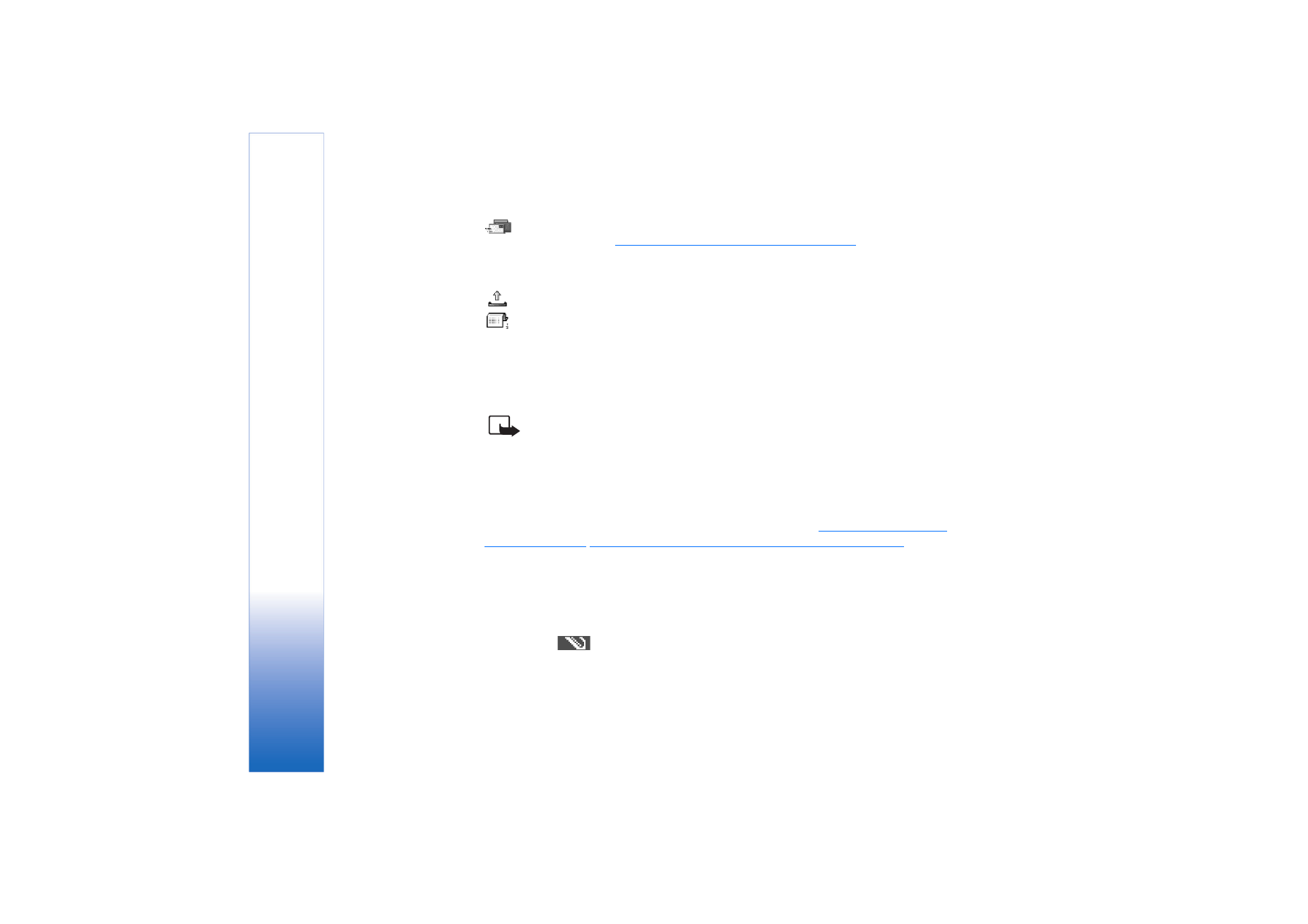
Copyright © 2004 Nokia. All rights reserved.
Messaging
46
Sent
- Stores the last 20 messages that have been sent. You can change the number
of messages to be saved.
See “Settings for the Other folder” on page 62.
Messages or data that have been sent via a Bluetooth connection are not saved in the Draft
or Sent folders.
Outbox
- Is a temporary storage place for messages waiting to be sent.
Reports
(Network Service) - You can request the network to send you a delivery
report of the text messages, smart messages, and multimedia messages you have sent. To
turn on delivery report reception, select
Options
→
Settings
→
Text message
or
Multimedia
message
, scroll to
Receive report
, and select
Yes
.
Receiving a delivery report of a multimedia message that has been sent to an e-mail
address might not be possible.
Note: When sending messages, your device may display the words "
Data Sent!
". This
is an indication that the message has been sent by your device to the message
centre number programmed into your device. This is not an indication that the
message has been received at the intended destination. For more details about
messaging services, check with your service provider.
Before you create a multimedia message, write an e-mail, or connect to your remote
mailbox, you must have the correct connection settings in place.
See “Settings needed for
e-mail” on page 51.
See “Settings needed for multimedia messaging” on page 51.
Writing text
Using traditional text input
The indicator
is shown on the top right of the display when you are writing text
using traditional text input.
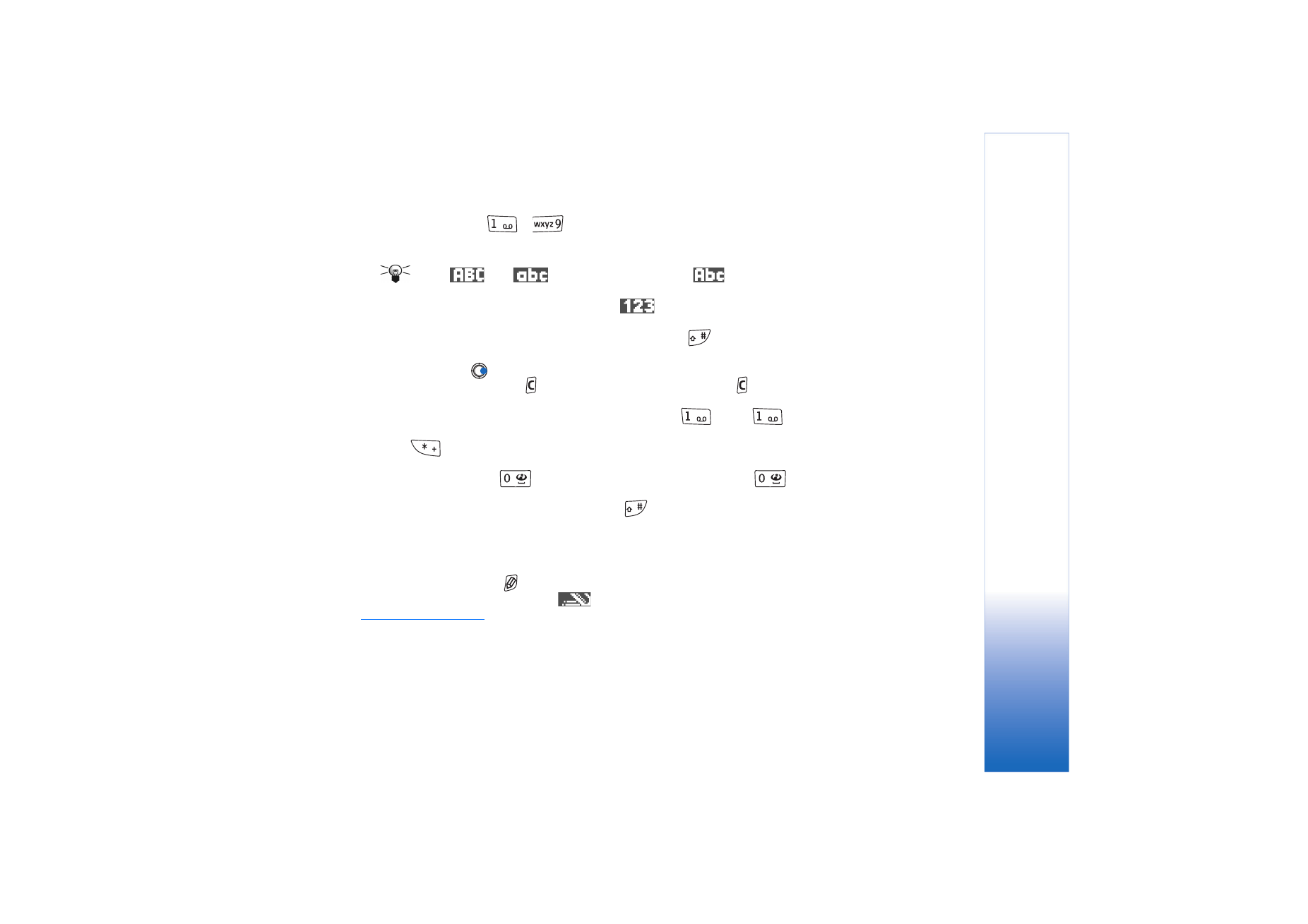
Copyright © 2004 Nokia. All rights reserved.
Messaging
47
• Press a number key (
-
), repeatedly until the desired character appears.
Note that there are more characters available for a number key than are printed on the
key.
Icons:
and
indicate the selected case.
means that the
first letter of the next word is written in upper case, and all other letters will
automatically be written in lower case.
indicates number mode.
• To insert a number, press and hold the number key.
To switch between letter and number mode, press and hold
.
• If the next letter is located on the same key as the present one, wait until the cursor
appears (or press
to end the time-out period), and then key in the letter.
• If you make a mistake, press
to remove a character. Press and hold
to clear more
than one character.
• The most common punctuation marks are available under
. Press
repeatedly to reach the desired punctuation mark.
Press
to open a list of special characters. Use the scroll key to move through the
list and press
Select
to select a character.
• To insert a space, press
. To move the cursor to the next line, press
three
times.
• To switch between upper and lower case, press
.
Using predictive text input
You can key in any letter with a single keypress using the predictive text input. To activate
predictive text input, press
and select
Dictionary on
. This will activate predictive text
input for all editors in the phone. The
indicator is shown at the top of the display.
See Fig. 10 on page 48.
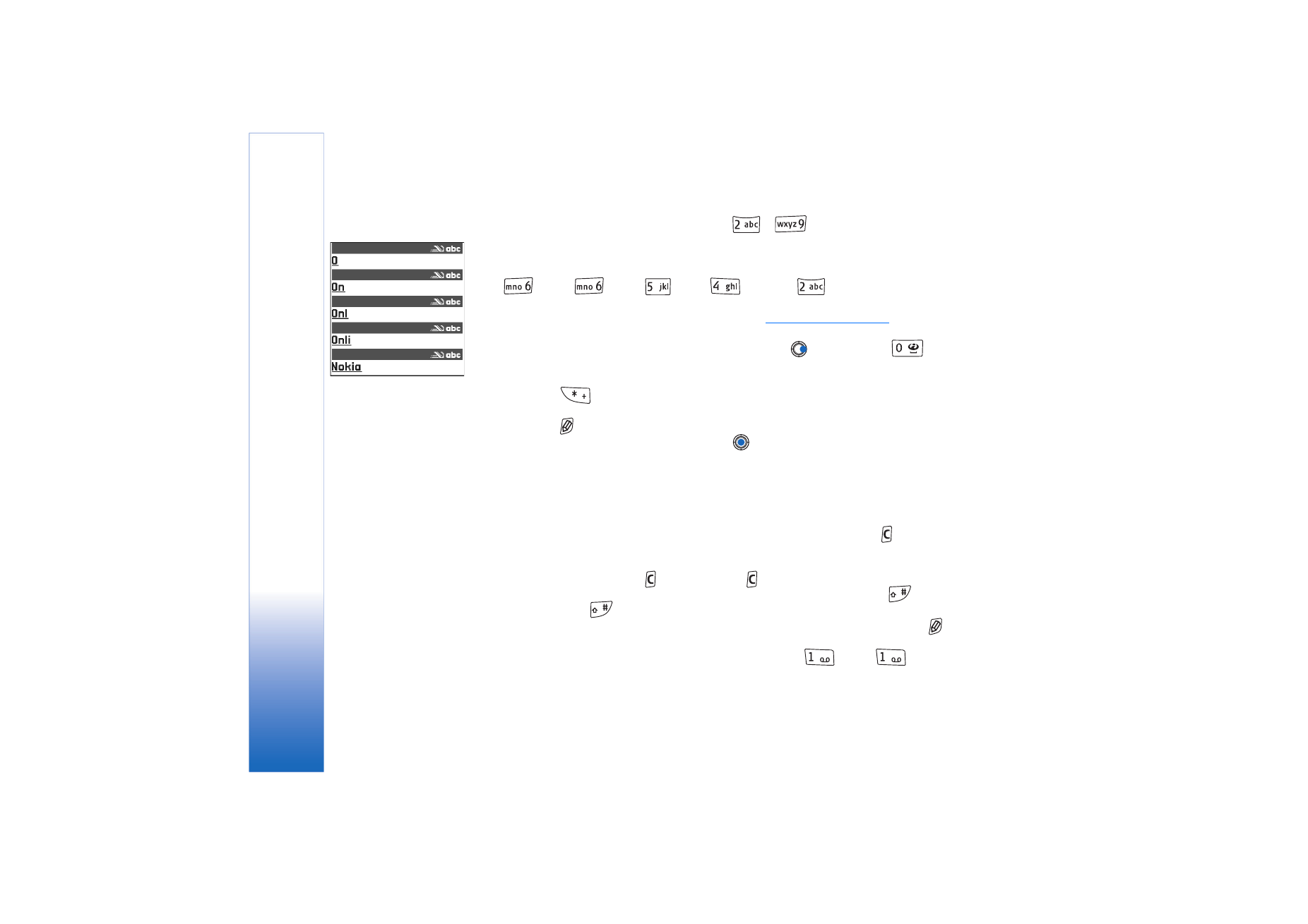
Copyright © 2004 Nokia. All rights reserved.
Messaging
48
1 Write the desired word by pressing the keys
-
. Press each key only once
for one letter. The word changes after every key press.
For example, to write ‘Nokia’ when the English dictionary is selected, press
for N,
for o,
for k,
for i, and
for a.
The word suggestion changes after each key press.
See Fig. 10 on page 48.
2 When you have finished the word, check that it is correct.
• If the word is correct, you can confirm it by pressing
or by pressing
to
insert a space. The underlining disappears and you can begin to write a new word.
• If the word is not correct, you have the following options:
• Press
repeatedly to view the matching words the dictionary has found one
by one.
• Press
and select
Dictionary
→
Matches
to view a list of matching words. Scroll
to the word you want to use and press
to select it.
• If the ? character is shown after the word, the word you intended to write is not in
the dictionary. To add a word to the dictionary, press
Spell
, key in the word (max. 32
letters) using traditional text input, and press
OK
. The word is added to the
dictionary. When the dictionary becomes full, a new word replaces the oldest added
word.
• To remove the ? and clear characters one by one from the word, press
.
Tips on using predictive text input
• To erase a character, press
. Press and hold
to clear more than one character.
• To change between the different character cases Abc, abc, and ABC, press
. Note
that if you press
twice quickly the predictive text input is turned off.
• To insert a number in letter mode, press and hold the desired number key, or press
and select number mode, key in the numbers you want, and press
OK
.
• The most common punctuation marks are available under
. Press
repeatedly to reach the desired punctuation mark.
Fig. 10 Predictive text
input.
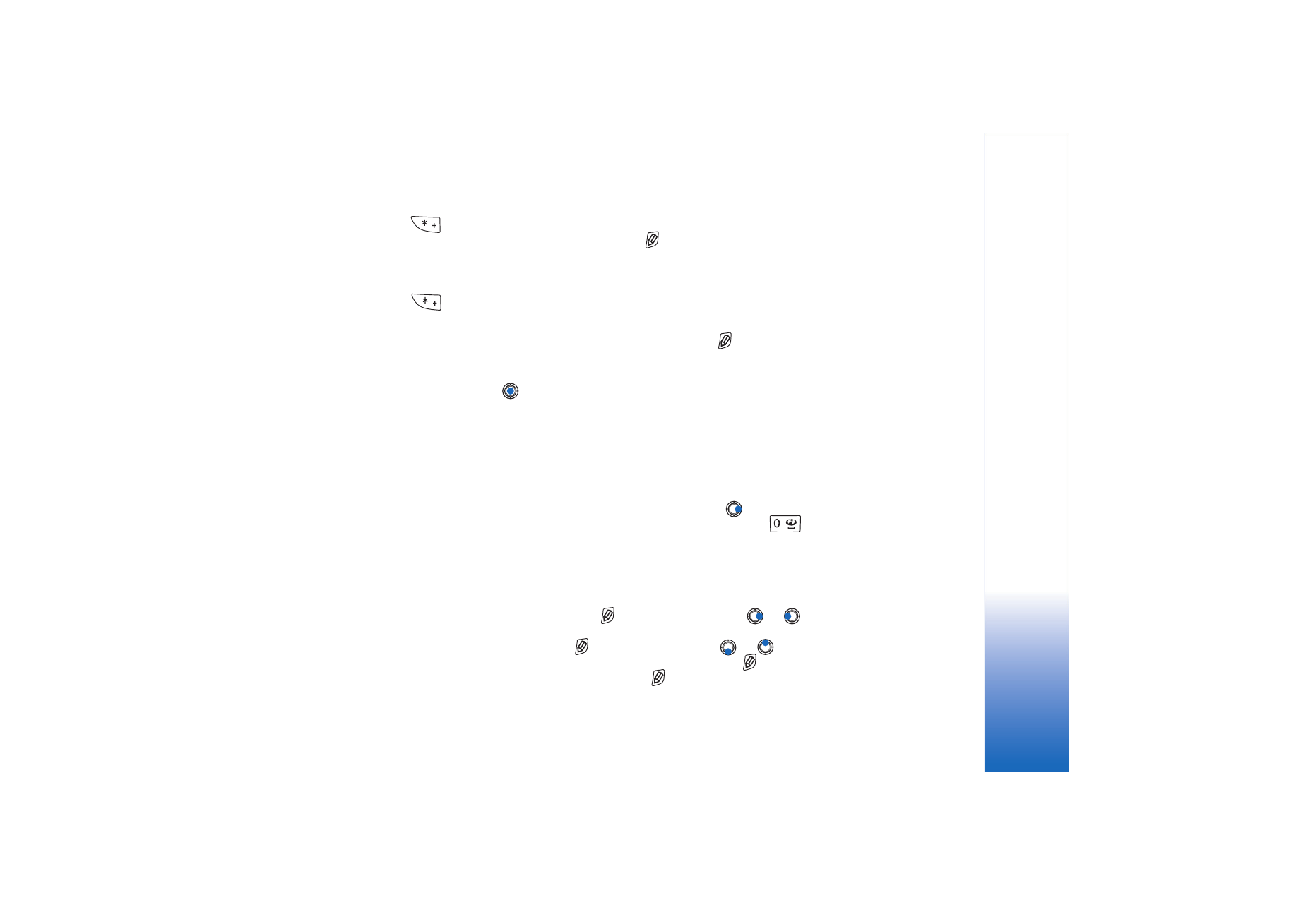
Copyright © 2004 Nokia. All rights reserved.
Messaging
49
Press
to open a list of special characters. Use the scroll key to scroll through the
list and press
Select
to select a character. Or press
and select
Insert symbol
.
The predictive text input will try to guess which commonly used punctuation mark
(.,?!‘) is needed. The order and availability of the punctuation marks depend on the
language of the dictionary.
• Press
repeatedly to view the matching words the dictionary has found one by
one.
When a word has been entered with predictive text on, you can press
, select
Dictionary
and select:
•
Matches
- To view a list of words that correspond to your key presses. Scroll to the
desired word and press
.
•
Insert word
- To add a word (max. 32 letters) to the dictionary by using traditional text
input. When the dictionary becomes full, a new word replaces the oldest added word.
•
Edit word
- To open a view where you can edit the word, available only if the word is
active (underlined).
•
Off
- To turn off predictive text input for all editors in the phone.
Writing compound words
• Write the first half of a compound word and confirm it by pressing
. Write the last
part of the compound word and complete the compound word by pressing
to
add a space.
Copying text to the clipboard
If you want to copy text to the clipboard, the following are the easiest methods:
1 To select letters and words, press and hold
. At the same time, press
or
. As
the selection moves, text is highlighted.
To select lines of text, press and hold
. At the same time press
or
.
2 To end the selection, release pressing the scroll key while still holding
.
3 To copy the text to the clipboard, while still holding
, press
Copy
.
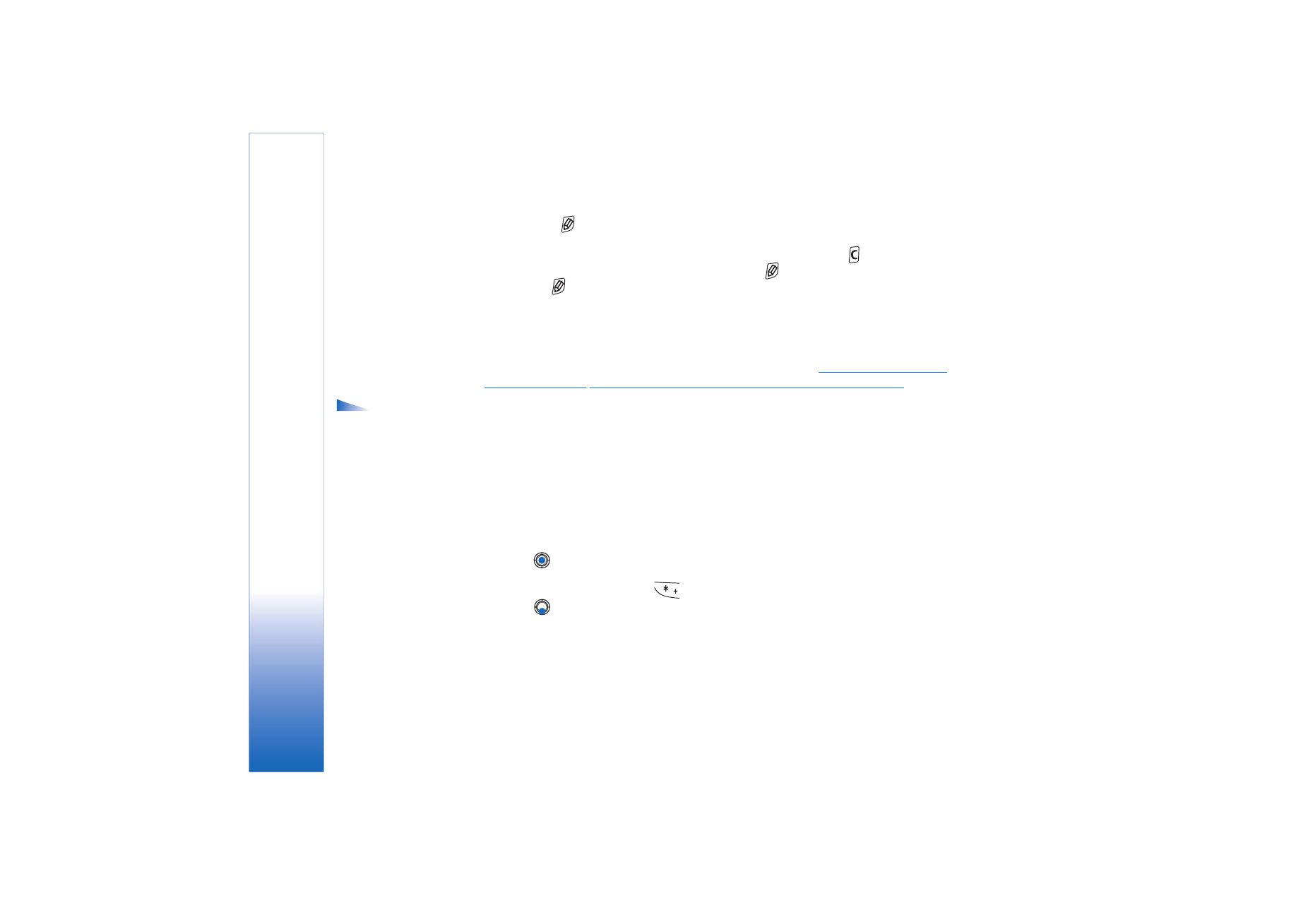
Copyright © 2004 Nokia. All rights reserved.
Messaging
50
Or, release
and then press it once to open a list of editing commands, for example,
Copy
or
Cut
.
If you want to remove the selected text from the document, press
.
4 To insert the text into a document, press and hold
and press
Paste
.
Or, press
once and select
Paste
.
Writing and sending messages
Before you can create a multimedia message, or write an e-mail, or connect to your remote
mailbox, you must have the correct connection settings in place.
See “Settings needed for
e-mail” on page 51.
See “Settings needed for multimedia messaging” on page 51.
Options in the text
message editor:
Send
,
Add
recipient
,
Insert
,
Delete
,
Check contacts
,
Message
details
,
Sending options
,
Help
, and
Exit
.
1 Select
New message
. A list of message options opens. Select:
•
Create:
→
Text message
if you want to create a text message
To send a picture message, select
Options
→
Insert
→
Picture
.
Each picture message is made up of several text messages. Therefore, sending one
picture message may cost more than sending one text message.
•
Create:
→
Multimedia message
if you wish to send a multimedia message (MMS).
Copyright protections may prevent some images, ringing tones, and other content
from being copied, modified, transferred or forwarded.
•
Create:
→
to send e-mail. If you have not set up your e-mail account, you will
be prompted to do so.
2 Press
to select the recipient(s) from the Contacts directory or write the phone
number or e-mail address of the recipient in the
To:
field if you are sending an MMS or
e-mail to the recipient. Press
to add a semicolon (;) to separate each recipient.
3 Press
to move to the message field.
4 Write the message.
Your device supports the sending of text messages beyond the normal 160-character
limit. If your message exceeds 160 characters, it will be sent as a series of two or more
messages.

Copyright © 2004 Nokia. All rights reserved.
Messaging
51
In the navigation bar, you can see the message length indicator counting backwards
from 160. For example, 10 (2) means that you can still add 10 characters for the text
to be sent as two messages.
Note that using special (Unicode) characters such as ë, â, á, ì take up more space.
• To add a media object to a multimedia message, select
Options
→
Insert new
→
Image
,
Sound clip
,
Video clip
or
Slide
. Select the item you wish to add.
Tip! Start to key in
a name in the
To:
field and
select
Options
→
Check
contacts
. The phone will
retrieve all matching
entries from the Contacts
directory. If only one entry
is found, it is added
automatically. If more
than one entry is found,
select a contact from the
list.
5 To send the message, select
Options
→
Send
or press
.
Settings needed for multimedia messaging
You may receive the settings as a smart message from your network operator or service
provider.
See “Receiving smart messages” on page 52.
For availability of and subscription to data services, please contact your network operator
or service provider.
• Go to
Messaging
→
Options
→
Settings
→
Multimedia message
. Open
Access point in use
and select the access point you created.
See “Settings for multimedia messages” on
page 59.
Settings needed for e-mail
Before you can send, receive, retrieve, reply to, and forward e-mail to a separate e-mail
account, you must:
• Configure an Internet Access Point (IAP) correctly.
See “Connection settings” on
page 68.
• Define your e-mail settings correctly.
See “Settings for e-mail” on page 60.
Follow the instructions given by your remote mailbox and Internet service provider.

Copyright © 2004 Nokia. All rights reserved.
Messaging
52
Inbox - receiving messages
When there are unread messages in Inbox, the icon changes to
.
Options in Inbox:
Open
,
Create message
,
Delete
,
Message details
,
Move to folder
,
Mark/
Unmark
,
Help
, and
Exit
.
In Inbox, the message icons tell you what kind of a message it is. Here are some of the icons
that you may see:
for an unread text message and
for an unread smart message
for an unread multimedia message
for an unread service message
for data received via Bluetooth
for an unknown message type.
Viewing multimedia objects
Options in the
Objects view:
Open
,
Save
,
Send
,
Help
, and
Exit
.
• To see what kinds of media objects have been included in the multimedia message,
open the message and select
Options
→
Objects
. In the Objects view you can view files
that have been included in the multimedia message. You can choose to save the file in
your phone or to send it, for example, via Bluetooth to another compatible device.
Important: Multimedia message objects may contain viruses or otherwise be
harmful to your device or PC. Do not open any attachment if you are not sure of
the trustworthiness of the sender.
See “Certif. management” on page 76.
Receiving smart messages
Your phone can receive many kinds of smart messages, text messages that contain data
(also called Over-The-Air (OTA) messages). To open a received smart message, open Inbox,
scroll to the smart message (
), and press
.

Copyright © 2004 Nokia. All rights reserved.
Messaging
53
•
Picture message
- To save the picture in the
Picture messages
folder in the Gallery for later
use, select
Options
→
Save picture
.
•
Business card
- To save the contact information, select
Options
→
Save business card
.
Tip: If certificates or sound files are attached to business cards, they will not be
saved.
•
Ringing tone
- To save the ringing tone to the Gallery, select
Options
→
Save
.
•
Operator logo
- To save the logo, select
Options
→
Save
. The operator logo can now be
seen in standby mode instead of the network operator’s own identification.
•
Calendar entry
- To save the invitation to Calendar, select
Options
→
Save to Calendar
.
•
Web message
- To save the bookmark, select
Options
→
Save to bookmarks
. The bookmark
is added to the Bookmarks list in browser services.
If the message contains both browser access point settings and bookmarks, to save the
data select
Options
→
Save all
. Or, select
Options
→
View details
to view the bookmark
and access point information separately. If you do not want to save all data, select a
setting or bookmark, open the details, and select
Options
→
Save to Settings
or
Save to
bookmarks
depending on what you are viewing.
•
E-mail notification
- Tells you how many new e-mails you have in your remote mailbox.
An extended notification may list more detailed information such as subject, sender,
attachments, and so on.
• In addition, you can receive a text message service number, voice mailbox number,
profile settings for remote synchronisation, access point settings for the browser,
multimedia messaging or e-mail, access point login script settings, or e-mail settings.
To save the settings, select
Options
→
Save to SMS sett.
,
Save to Voice mail
,
Save to
Settings
, or
Save to e-mail sett.
.
Receiving service messages (Network Service)
Service messages are notifications of, for example, news headlines and they may contain
a text message or address of a browser service. For availability and subscription, contact
your service provider.
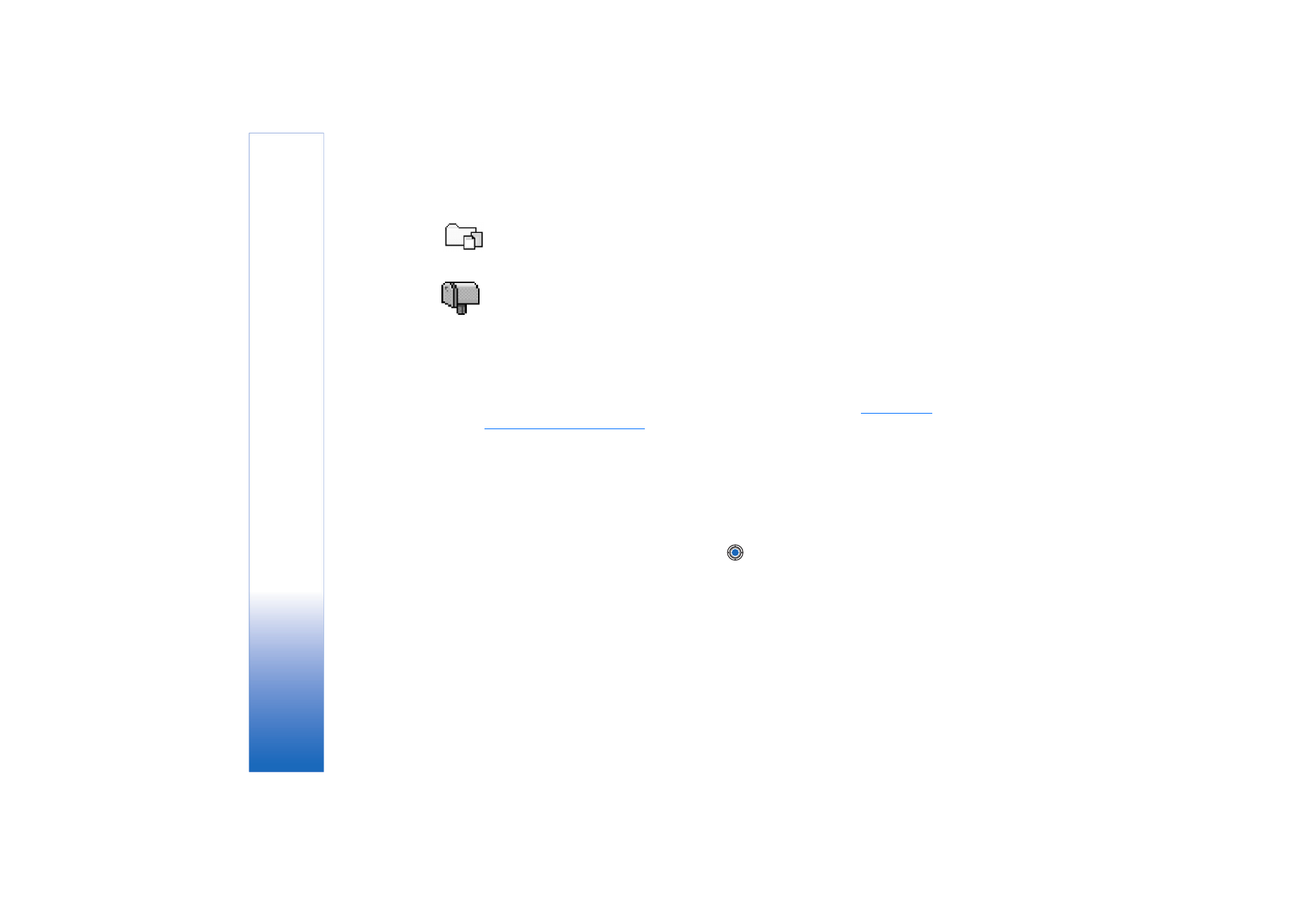
Copyright © 2004 Nokia. All rights reserved.
Messaging
54
My folders
In My folders you can organise your messages into folders, create new folders, and rename
and delete folders.
Remote mailbox (Network Service)
When you open this folder, you can either connect to your remote mailbox to:
• retrieve new e-mail headings or messages, or
• view your previously retrieved e-mail headings or messages offline.
If you select
New message
→
Create:
→
or
Mailbox
in the Messaging main view and
you have not set up your e-mail account, you will be prompted to do so.
See “Settings
needed for e-mail” on page 51.
When you create a new mailbox, the name you give to the mailbox automatically replaces
Mailbox
in the Messaging main view. You can have several mailboxes (max. six).
Opening the mailbox
When you open the mailbox, you can choose whether you want to view the previously
retrieved e-mail messages and e-mail headings offline or connect to the e-mail server.
• When you scroll to your mailbox and press
, the phone asks you if you want to
Connect to mailbox?
Select
Yes
to connect to your mailbox or
No
to view previously
retrieved e-mail messages offline.
• Another way to start a connection is to select
Options
→
Connect
.
Retrieving e-mail messages from the mailbox
• If you are offline, select
Options
→
Connect
to start a connection to a remote mailbox.

Copyright © 2004 Nokia. All rights reserved.
Messaging
55
1 When you have an open connection to a remote mailbox, select
Options
→
Retrieve e-
→:
•
New
- To retrieve all new e-mail messages to your phone.
•
Selected
- To retrieve only the e-mail messages that have been marked. Use the
Mark/
Unmark
→
Mark
/
Unmark
commands to select messages one by one.
See “Actions
common to all applications” on page 12.
•
All
- To retrieve all messages from the mailbox.
To cancel retrieving, press
Cancel
.
2 After you have retrieved the e-mail messages, you can continue viewing them online.
Select
Options
→
Disconnect
to close the connection and to view the e-mail messages
offline.
3 To open an e-mail message, scroll to the e-mail you want to view and press
. If the
e-mail message has not been retrieved (arrow in the icon is pointing outwards) and you
are offline and select
Open
, you will be asked if you want to retrieve this message from
the mailbox.
• To view e-mail attachments, open a message that has the attachment indicator
and select
Options
→
Attachments
. In the Attachments view, you can retrieve, open,
or save attachments, in supported formats. You can also send attachments via
Bluetooth.
If your mailbox uses the IMAP4 protocol, you can decide whether to retrieve e-mail
headings only, messages only, or messages and attachments. With the POP3
protocol, the options are e-mail headings only or messages and attachments.
See
“Settings for e-mail” on page 60.
Important: Multimedia message objects may contain viruses or otherwise be
harmful to your device or PC. Do not open any attachment if you are not sure of
the trustworthiness of the sender.
Deleting e-mail messages
• To delete an e-mail from the phone while still retaining it in the remote mailbox:

Copyright © 2004 Nokia. All rights reserved.
Messaging
56
Select
Options
→
Delete
→
Phone only
.
The phone mirrors the e-mail headings in the remote mailbox. So, although you delete the
message content, the e-mail heading stays in your phone. If you want to remove the
heading as well, you have to first delete the e-mail message from your remote mailbox and
then make a connection from your phone to the remote mailbox again to update the status.
• To delete an e-mail from both the phone and the remote mailbox:
Select
Options
→
Delete
→
Phone and server
.
If you are offline, the e-mail will be deleted first from your phone. During the next
connection to the remote mailbox, it will be automatically deleted from the remote
mailbox.
If you are using the POP3 protocol, messages marked to be deleted are removed only
after you have closed the connection to the remote mailbox.
Undeleting e-mail messages when offline
To cancel deleting an e-mail from both the phone and server, scroll to an e-mail that has
been marked to be deleted during the next connection (
), and select
Options
→
Undelete
.
Disconnecting from mailbox
When you are online, select
Options
→
Disconnect
to end the data call or GPRS connection
to the remote mailbox.
Outbox
Outbox is a temporary storage place for messages that are waiting to be sent.
Status of the messages in Outbox:
•
Sending
- A connection is being made and the message is being sent.

Copyright © 2004 Nokia. All rights reserved.
Messaging
57
•
Waiting
/
Queued
- For example, if there are two similar types of messages in Outbox,
one of them is waiting until the first one is sent.
•
Resend at
(time) - Sending has failed. The phone will try to send the message again after
a time-out period. Press
Send
if you want to restart the sending immediately.
•
Deferred
- You can set documents to be ‘on hold’ while they are in Outbox. Scroll to a
message that is being sent and select
Options
→
Defer sending
.
•
Failed
- The maximum number of sending attempts has been reached. If you were trying
to send a text message, open the message and check that the Sending settings are
correct.
Viewing messages on a SIM card
Before you can view SIM messages, you need to copy them to a folder in your phone.
See
“Actions common to all applications” on page 12.
Cell broadcast (Network Service)
In the Messaging
main view, select
Options
→
Cell broadcast
.
You may be able to receive messages on various topics, such as weather or traffic
conditions from your service provider. For available topics and relevant topic numbers,
contact your service provider. In the main view you can see:
• the status of the topic:
- for new, subscribed messages and
- for new,
unsubscribed messages.
Options in Cell
broadcast:
Open
,
Subscribe
/
Unsubscribe
,
Hotmark
/
Remove hotmark
,
Topic
,
Settings
,
Help
, and
Exit
.
• the topic number, topic name, and whether it has been flagged (
) for follow-up. You
will be notified when messages belonging to a flagged topic have arrived.
A packet data (GPRS) connection may prevent cell broadcast reception. Contact your
network operator for the correct GPRS settings.

Copyright © 2004 Nokia. All rights reserved.
Messaging
58
Service command editor
Select
Messaging
→
Options
→
Service command
. Key in and send service requests (also
known as USSD commands) such as activation commands, for network services, to your
service provider.
Messaging settings
Settings for text messages
Go to
Messaging
and select
Options
→
Settings
→
Text message
to open the following list
of settings:
•
Message centres
- Lists all the message centres that have been defined.
Options when
editing message centre
settings:
New msg. centre
,
Edit
,
Delete
,
Help
, and
Exit
.
•
Msg. centre in use
(Message centre in use) - Defines which message centre is used for
delivering text messages and smart messages such as picture messages.
•
Receive report
(delivery report) - When this network service is set to
Yes
, the status of
the sent message (
Pending
,
Failed
,
Delivered
) is shown in the Reports (Network Service).
Receiving a delivery report of a multimedia message that has been sent to an e-mail
address might not be possible.
•
Message validity
- If the recipient of a message cannot be reached within the validity
period, the message is removed from the message service centre. Note that the network
must support this feature.
Maximum time
is the maximum amount of time allowed by
the network.
•
Message sent as
- The options are
Text
,
Fax
,
Paging
, and
. For further information,
contact your network operator.
Tip: Change this option only if you are sure that your message centre is able to
convert text messages into these other formats.
•
Preferred connection
- You can send text messages via the normal GSM network or via
GPRS, if supported by the network.

Copyright © 2004 Nokia. All rights reserved.
Messaging
59
•
Reply via same ctr.
(network service) - By setting this option to
Yes
, if the recipient replies
to your message, the return message is sent using the same message service centre
number. Note that this may not work between all operators.
Settings for multimedia messages
Go to
Messaging
and select
Options
→
Settings
→
Multimedia message
to open the
following list of settings:
•
Access point in use
(
Must be defined
) - Select which access point is used as the preferred
connection for the multimedia message centre.
See “Settings needed for multimedia
messaging” on page 51.
If you receive multimedia message settings in a smart message and save them, the received
settings are automatically used for the Access point.
See “Receiving smart messages” on
page 52.
•
Multimedia reception
- Select:
•
Only in home net.
- If you want to receive multimedia messages only when you are in
your home network. When you are outside your home network, multimedia message
reception is turned off.
•
Always on
- If you always want to receive multimedia messages.
•
Off
- If you do not want to receive multimedia messages or advertisements at all.
Tip: If the settings
Only in home net.
or
Always on
have been selected, your phone can
make an active data call or GPRS connection without your knowledge
•
On receiving msg.
- Select:
•
Retr. immediately
- If you want the phone to try to retrieve multimedia messages
instantly. If there are messages with Deferred status, they will be retrieved as well.
•
Defer retrieval
- If you want the multimedia messaging centre to save the message to
be retrieved later. When you want to retrieve the message, set
On receiving msg.
to
Retr. immediately
.

Copyright © 2004 Nokia. All rights reserved.
Messaging
60
•
Reject message
- If you want to reject multimedia messages. The multimedia message
centre will delete the messages.
•
Allow anon. messages
- Select
No
, if you want to reject messages coming from an
anonymous sender.
•
Receive adverts
- Define whether you want to allow reception of multimedia message
advertisements or not.
•
Reports
- Set to
Yes
, if you want the status of the sent message (
Pending
,
Failed
,
Delivered
) to be shown in the Reports.
•
Deny report sending
- Choose
Yes
, if you do not want your phone to send delivery reports
of received multimedia messages.
•
Message validity
(Network Service) - If the recipient of a message cannot be reached
within the validity period, the message is removed from the multimedia message centre.
Maximum time
is the maximum amount of time allowed by the network.
•
Image size
- Define the size of the image in a multimedia message. The options are:
Small
(max. of 160*120 pixels) and
Large
(max. 640*480 pixels).
Settings for e-mail
Go to
Messaging
and select
Options
→
Settings
→
.
Open
Mailbox in use
to select which mailbox you want to use.
Settings for Mailboxes
Options when
editing e-mail settings:
Editing options
,
New
mailbox
,
Delete
,
Help
, and
Exit
.
Select
Mailboxes
to open a list of mailboxes that have been defined. If no mailboxes have
been defined, you will be prompted to do so. The following list of settings is shown (this
information is available from your e-mail service provider):
•
Mailbox name
- Write a descriptive name for the mailbox.
•
Access point in use
(
Must be defined
) - The Internet Access Point (IAP) used for the
mailbox. Choose an IAP from the list.
See “Connection settings” on page 68.

Copyright © 2004 Nokia. All rights reserved.
Messaging
61
•
My e-mail address
(
Must be defined
) - Write the e-mail address given to you by your
service provider. The address must contain the @ character. Replies to your messages
are sent to this address.
•
Outgoing mail server:
(
Must be defined
) - Write the IP address or host name of the
computer that sends your e-mail.
•
Send message
(Network Service) - Define how e-mail is sent from your phone.
Immediately
- A connection to the mailbox is started immediately after you have
selected
Send
.
During next conn.
- E-mail is sent when you connect to your remote
mailbox the next time.
•
Send copy to self
- Select
Yes
to save a copy of the e-mail to your remote mailbox and to
the address defined in
My e-mail address
.
•
Include signature
- Select
Yes
if you want to attach a signature to your e-mail messages
and to start to write or edit a signature text.
•
User name:
- Write your user name, given to you by your service provider.
•
Password:
- Write your password. If you leave this field blank, you will be prompted for
the password when you try to connect to your remote mailbox.
•
Incoming mail server:
(
Must be defined
) - The IP address or host name of the computer
that receives your e-mail.
•
Mailbox type:
- Defines the e-mail protocol your remote mailbox service provider
recommends. The options are
POP3
and
IMAP4
.
This setting can be selected only once and cannot be changed if you have saved or
exited from the mailbox settings.
•
Security
- Used with the POP3, IMAP4, and SMTP protocols to secure the connection to
the remote mailbox.
•
APOP secure login
- Used with the POP3 protocol to encrypt the sending of passwords to
the remote e-mail server. Not shown if IMAP4 is selected for
Mailbox type:
.
•
Retrieve attachment
(not shown if the e-mail protocol is set to POP3) - To retrieve e-mail
with or without attachments.
•
Retrieve headers
- To limit the number of e-mail headers you want to retrieve to your
phone. The options are
All
and
User defined
. Used with the IMAP4 protocol only.

Copyright © 2004 Nokia. All rights reserved.
Messaging
62
Settings for service messages
When you go to
Messaging
and select
Options
→
Settings
→
Service message
, the following
list of settings opens:
•
Service messages
- Choose whether or not you want to allow reception of service
messages.
•
Authentic. needed
- Choose if you want to receive service messages only from authorised
sources.
Settings for Cell broadcast (Network Service)
Check with your service provider whether Cell broadcast is available and what the available
topics and related topic numbers are. Go to
Messaging
→
Options
→
Settings
→
Cell
broadcast
to change the settings:
•
Reception
-
On
or
Off
.
•
Language
-
All
allows you to receive cell broadcast messages in every possible language.
Selected
allows you to choose in which languages you wish to receive cell broadcast
messages. If the language you prefer could not be found in the list, select
Other
.
•
Topic detection
- If you receive a message that does not belong to any of the existing
topics,
Topic detection
→
On
allows you to save the topic number automatically. The
topic number is saved to the topic list and shown without a name. Choose
Off
if you do
not want to save new topic numbers automatically.
Settings for the Other folder
Go to
Messaging
and select
Options
→
Settings
→
Other
to open the following list of
settings:
•
Save sent messages
- Choose if you want to save a copy of every text message,
multimedia message, or e-mail that you have sent to the Sent items folder.

Copyright © 2004 Nokia. All rights reserved.
Messaging
63
•
No. of saved msgs.
- Define how many sent messages will be saved to the Sent items
folder at a time. The default limit is 20 messages. When the limit is reached, the oldest
message is deleted.
•
Memory in use
- Define the memory store. Choices are phone’s memory or memory card,
if one is used.

Copyright © 2004 Nokia. All rights reserved.
Tools
64
Tools
Using the Setting Wizard
Go to
Menu
→
Setting Wizard
.
Use the Setting Wizard to configure your phone’s settings to enable you to use the
browsers and to send and receive Multimedia Messages and e-mails. Because the Setting
Wizard configures GPRS and other settings for WAP, MMS and Internet access, the
application should be run before manually configuring any other browser or messaging
settings.
Ensure that all other applications are closed.
Select
Options
→
Open
. When you run the application for the first time, you will be asked
to accept the Disclaimer in the End User Licence Agreement.
After accepting the Disclaimer, the Setting Wizard displays the instruction screen. Press
OK
to continue or
Exit
to return to the application menu.
The Setting Wizard automatically detects your network operator by reading the details
from your SIM card. If the Setting Wizard does not recognise your SIM card, you will be
asked to select your country and network operator from a list.
Select
Options
→
Change
to access the country list. Once the country is selected, you may
then choose the network operator.
Scroll down to highlight the Operator. Select
Options
→
Change
to access the network
operator list.
Once the country and operator have been chosen, select
Options
→
OK
.
The Setting Wizard will then confirm that you want to create the settings for your chosen
network operator. Select
OK
to proceed or
Cancel
to return to the country and network
operator lists.

Copyright © 2004 Nokia. All rights reserved.
Tools
65
The Setting Wizard will then program your phone. Progress bars will be visible for
approximately 5-10 seconds. Your phone is now configured for MMS, WAP and Internet
access. Select
OK
to close the Setting Wizard.
Please note that to use these services, you may have to contact your network operator or
service provider to activate GPRS. Where possible, the Setting Wizard will display the
telephone number to call.
Please note that not all network operators support all services.
E-mail configuration settings can be sent directly to your phone via Nokia’s Phone Settings
web site at http://www.nokia.com/phonesettings.
Should you experience any problems with the Setting Wizard, please visit Nokia’s Phone
Settings web site at http://www.nokia.com/phonesettings to have your network operator’s
latest settings sent directly to your phone via a text message.
Settings
Changing general settings
Go to
Menu
→
Settings
.
1 Scroll to a setting group and press
to open it.
2 Scroll to a setting you want to change and press
to:
• switch between options if there are only two (On/Off),
• open a list of options or an editor,
• open a slider view and press
or
to increase or decrease the value
respectively.
See Fig. 11 on page 67.
You may be able to receive some settings from your service
provider in a short message.
See “Receiving smart messages” on page 52.

Copyright © 2004 Nokia. All rights reserved.
Tools
66
Phone settings
General
•
Phone language
- You can change the language for the display texts in your phone. This
change may also affect the format used for date and time and the separators used, for
example, in calculations. If you select
Automatic
, the phone selects the language
according to the information on your SIM card. After you have changed the display text
language, you must restart the phone.
Changing the settings for
Phone language
or
Writing language
affects every application in
your phone and the change remains effective until you change these settings again.
•
Writing language
- You can change the writing language of your phone. Changing the
language affects:
• the characters available when you press any key (
-
)
• the predictive text dictionary used
• the special characters that are available when you press the
and
keys.
•
Dictionary
- To set predictive text input
On
or
Off
for all editors in the phone. Select a
language for entering predictive text from the list available. You can also change this
setting when you are in an editor. Press
and select
Dictionary
→
Dictionary on
or
Off
.
•
Welcome note or logo
- The welcome note or logo is displayed briefly each time you
switch on the phone. Select
Default
if you want to use the default image or animation.
Select
Text
to write a welcome note (max. 50 letters). Select
Image
to select a photo or
picture from the Gallery.
•
Orig. phone settings
- You can reset some of the settings to their original values. To do
this, you need the lock code.
See “Security” on page 74.
After resetting the settings, the
phone may take a longer time to power on. All documents and files that you have
created are left as they are.
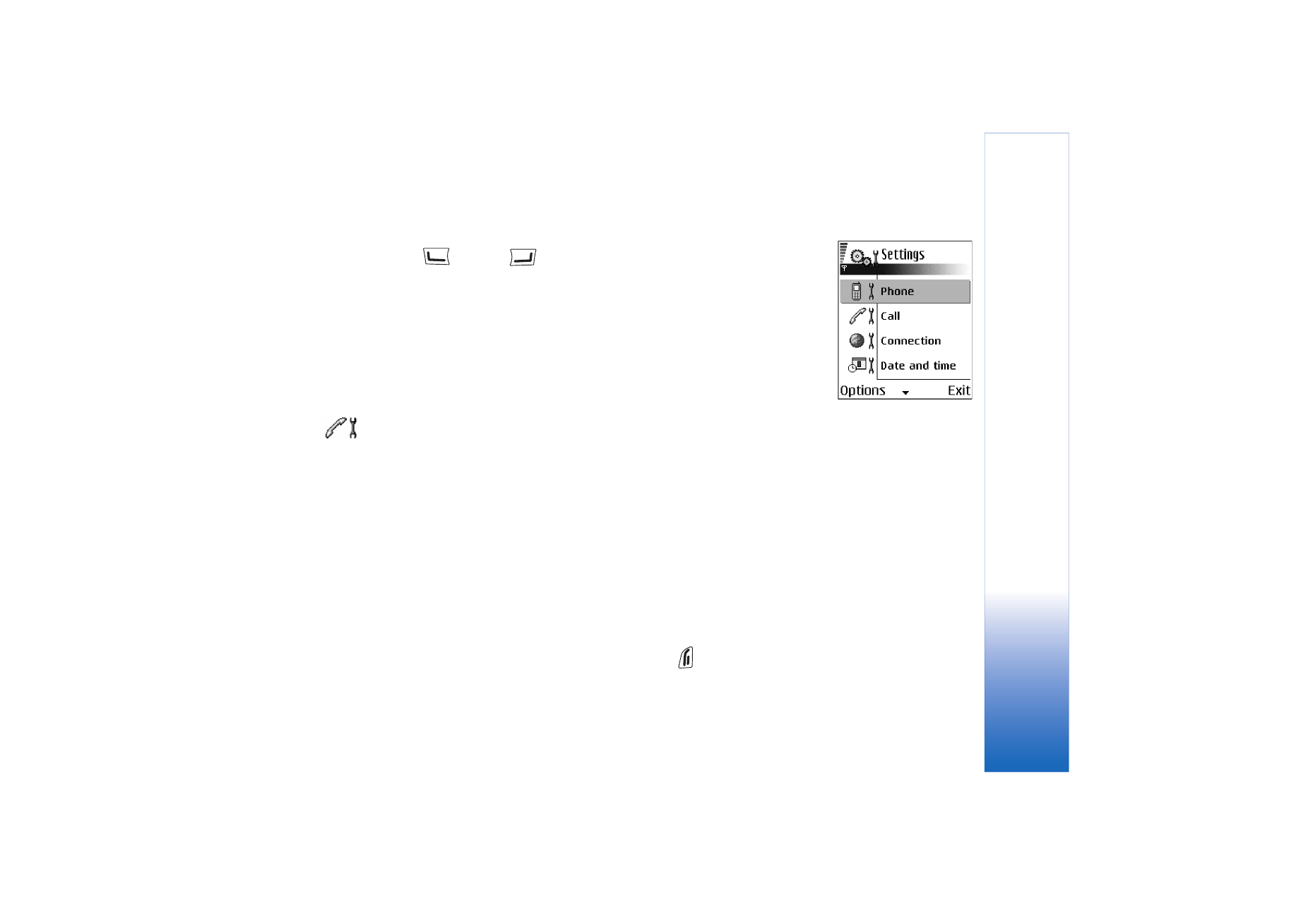
Copyright © 2004 Nokia. All rights reserved.
Tools
67
Standby mode
•
Left selection key
and
Right selection key
- You can change the shortcuts that appear over
the left
and right
selection keys in standby mode. In addition to the
applications, you can have the shortcut point to a function, for example,
New message
.
•
Navigation key right
,
Navigation key left
,
Navigation key down
,
Navigation key up
, and
Selection key
- To have shortcuts available in standby mode when you press the scroll
key in any direction, scroll to the desired application or function and press the scroll key.
Display
•
Screen saver timeout
- The screen saver is activated when the screen saver time-out
period is over. When the screen saver is active, the display is cleared and you can see
the screen saver bar.
• To deactivate the screen saver press any key.
Call settings
Send my caller ID
(Network Service)
• This allows you to set your phone number to be displayed (
Yes
) or hidden (
No
) from the
person to whom you are calling. Or, the value may be set by your network operator or
service provider when you make a subscription.
Call waiting
(Network Service)
• The network will notify you of a new incoming call while you have a call in progress.
Select
Activate
to request the network to activate call waiting,
Cancel
to request the
network to deactivate call waiting, or
Check status
to check if the function is active or
not.
Automatic redial
• When this setting is activated, your phone will make a maximum of ten attempts to
connect the call after an unsuccessful call attempt. Press
to stop automatic
redialling.
Fig. 11 The Settings main
view.

Copyright © 2004 Nokia. All rights reserved.
Tools
68
Summary after call
• Activate this setting if you want the phone to briefly display the approximate duration
of the last call.
Speed dialling
• Select
On
and the numbers assigned to the speed dialling keys (
-
) can
be dialled by pressing and holding the key.
See “Assigning speed dialling keys” on
page 25.
Anykey answer
• Select
On
, and you can answer an incoming call by briefly pressing any key, except
, ,
and
.
Line in use
(Network Service)
• This setting is shown only if the SIM card supports two subscriber numbers, that is, two
phone lines. Select which phone line (
Line 1
or
Line 2
) you want to use for making calls
and sending short messages. Calls on both lines can be answered irrespective of the
selected line.
You will not be able to make calls if you select
Line 2
and have not subscribed to this
network service.
To prevent line selection, select
Line change
→
Disable
if supported by your SIM card. To
change this setting, you need the PIN2 code.
Connection settings
Access points
Here you can see a short explanation for every setting that may be needed for different
data connections and access points. If you have not yet used your phone to make a WAP
connection, you may need to contact your service provider for assistance with the first-
time connection or visit www.nokia.com/phonesettings.

Copyright © 2004 Nokia. All rights reserved.
Tools
69
Many service providers will require you to use an IAP for your default access point. Other
service providers allow you to use a WAP access point. Contact your service provider for
more information.
Start to fill in the settings from the top because depending on what data connection you
select (
Data bearer
) only certain setting fields are available.
•
Connection name
- Give a descriptive name for the connection.
•
Data bearer
- The options are
GPRS
or
Data call
. Depending on what data connection you
select, only certain setting fields are available. Fill in all fields marked with
Must be
defined
, or with an asterisk. Other fields can be left empty, unless you have been
instructed otherwise by your service provider.
To be able to use a data connection, the network operator or service provider must support
this feature, and if necessary, activate it for your SIM card.
•
Access point name
(for packet data only) - The access point name is needed to establish
a connection to the GPRS network. You obtain the access point name from your
network operator or service provider.
•
Dial-up number
(for Data call only) - The modem telephone number of the access point.
•
User name
- Write a user name if required by the service provider. The user name may
be needed to make a data connection, and is usually provided by the service provider.
The user name is often case-sensitive.
•
Prompt password
- If you must key in a new password every time you log onto a server,
or if you do not want to save your password to the phone, choose
Yes
.
•
Password
- A password may be needed to make a data connection, and is usually
provided by the service provider. The password is often case-sensitive. When you are
writing the password, the characters you enter are shown briefly and then changed to
asterisks (*). The easiest way to enter numbers is to press and hold the digit you want
to enter, and then continue entering letters.
•
Authentication
-
Normal
/
Secure
.
•
Homepage
- Depending on what you are setting up, write either:
• the service address, or

Copyright © 2004 Nokia. All rights reserved.
Tools
70
• the address of the multimedia messaging centre.
•
Data call type
(for Data call only) -
Analogue
,
ISDN v.110
, or
ISDN v.120
defines whether
the phone uses an analogue or digital connection. This setting depends on both your
GSM network operator and Internet Service Provider (ISP), because some GSM networks
do not support certain types of ISDN connections. For details, contact your ISP. If ISDN
connections are available, they establish connections more quickly than analogue
methods.
•
Maximum data speed
(for Data call only) - The options are 9600 or 14400, depending on
what you have chosen in
Data call type
. This option allows you to limit the maximum
connection speed when GSM data is used. Higher data rates may cost more, depending
on the service provider.
The speeds above represent the maximum speed at which your connection will operate.
During the connection, the operating speed may be less, depending on network conditions.
Options
→ Advanced settings
•
Phone IP address
- The IP address of your phone.
•
Primary name server
- The IP address of the primary DNS server.
•
Second. name server
- The IP address of the secondary DNS server.
•
Proxy serv. address
- The IP address of the proxy server.
•
Proxy port number
- The port number of the proxy server.
If you need to enter these settings, contact your Internet service provider.
The following settings are shown if you have selected data call as the connection type:
•
Use callback
- This option allows a server to call you back once you have made the initial
call. Contact your service provider to subscribe to this service.
The phone expects the callback call to use the same data call settings that were used
in the callback-requesting call. The network must support that type of call in both
directions, to and from the phone.
•
Callback type
- The options are
Use server no.
/
Use other no.
. Ask your service provider for
the correct setting to use; it will depend on the service provider’s configuration.

Copyright © 2004 Nokia. All rights reserved.
Tools
71
•
Callback number
- Key in your phone’s data phone number which the dial back server
uses. Usually, this number is the data call phone number of your phone.
•
Use PPP compression
- When set to
Yes
, this option speeds up the data transfer, if
supported by the remote PPP server. If you have problems with establishing a
connection, try setting this to
No
. Contact your service provider for guidance.
•
Use login script
- The options are
Yes
/
No
.
•
Login script
- Insert the login script.
•
Modem initialisation
(Modem initialisation string) - Controls your phone using modem
AT commands. If required, enter characters specified by your service provider or Internet
service provider.
GPRS
Go to
Settings
→
Connection
→
GPRS
.
The GPRS settings affect all access points using a packet data connection.
GPRS connection
- If you select
When available
and you are in a network that supports
packet data, the phone registers to the GPRS network and sending short messages will be
done via GPRS. Also, starting an active packet data connection, for example, to send and
receive e-mail, is quicker. If you select
When needed
, the phone will use a packet data
connection only if you start an application or action that needs it. The GPRS connection
can be closed after it is not used by any application.
If there is no GPRS coverage and you have chosen
When available
, the phone will
periodically try to establish a packet data connection.
Access point - The access point name is needed when you want to use your phone as a
packet data modem to your computer.
Data call
Go to
Settings
→
Connection
→
Data call
.
The
Data call
settings affect all access points using a GSM data call.
Online time
- If there are no actions the data call is dropped automatically after a time-out
period. The options are
User defined
, in which case you enter a time, or
Unlimited
.

Copyright © 2004 Nokia. All rights reserved.
Tools
72
Date and time
The
Date and time
settings allow you to define the date and time used in your phone, as well
as change the date and time format and separators.
•
Clock type
→
Analogue
or
Digital
- To change the clock shown in standby mode.
See
“Clock” on page 93.
•
Auto time update
- To allow the network to update time, date, and time zone information
to your phone (Network Service). For the
Auto time update
setting to take effect, the
phone needs to be restarted. Check any alarms as these may be affected by
Auto time
update
.
•
Clock alarm tone
- To change the tone played when the clock alarm time is reached.
•
GMT offset
- To change the time zone for the clock time.
•
Daylight-saving
- To set daylight saving time on or off.
Call barring
(Network Service)
Call barring allows you to restrict the making and receiving of calls with your phone. For
this function, you need the barring password, which you can obtain from your service
provider.
1 Scroll to one of the barring options.
2 Select
Options
→
Activate
to request the network to set call restriction on,
Cancel
to set
the selected call restriction off, or
Check status
to check if the calls are barred or not.
• Select
Options
→
Edit barrings passw.
to change the barring password.
• Select
Options
→
Cancel all barrings
to cancel all active call barrings.
When calls are barred, calls still may be possible to certain official emergency numbers.

Copyright © 2004 Nokia. All rights reserved.
Tools
73
Network
Operator selection
• Choose
Automatic
to set the phone to automatically search for and select one of the
cellular networks available in your area.
• Choose
Manual
, if you want to select the desired network manually from a list of
networks. If the connection to the manually selected network is lost, the phone will
sound an error tone and ask you to select a network again. The selected network must
have a roaming agreement with your home network, that is, the operator whose SIM
card is in your phone.
Cell info display
• Select
On
to set the phone to indicate when it is used in a cellular network based on
Micro Cellular Network (MCN) technology and to activate cell info reception (Network
Service).
Enhancement settings
Scroll to an enhancement folder and open the settings:
• Select
Default profile
to select the profile you want to activate each time you connect a
certain enhancement to your phone.
See “Changing the profile” on page 84.
• Select
Automatic answer
to set the phone to answer an incoming call automatically after
five seconds time when you connect a certain enhancement to your phone. If the
Incoming call alert
is set to
Beep once
or
Silent
, automatic answer cannot be used, and
you must answer the phone manually.

Copyright © 2004 Nokia. All rights reserved.
Tools
74
Security
Phone and SIM
Explanations for the different security codes that may be needed:
• PIN code (4 to 8 digits) - The PIN (Personal Identification Number) code protects your
SIM card against unauthorised use. The PIN code is usually supplied with the SIM card.
After three consecutive incorrect PIN code entries, the PIN code is blocked. If the PIN
code is blocked, you need to unblock the PIN code before you can use the SIM card
again. See the information about the PUK code.
• PIN2 code (4 to 8 digits) - The PIN2 code, supplied with some SIM cards, is required
to access some functions.
• Lock code (5 digits) - The lock code can be used to lock the phone and keypad to avoid
unauthorised use.
The factory setting for the lock code is 12345. To avoid unauthorised use of your phone,
change the lock code. Keep the new code secret and in a safe place separate from your
phone.
• PUK and PUK2 codes (8 digits) - The PUK (Personal Unblocking Key) code is required
to change a blocked PIN code. The PUK2 code is required to change a blocked PIN2 code.
If the codes are not supplied with the SIM card, contact the operator whose SIM card
is in your phone for the codes.
You can change the following codes: lock code, PIN code, and PIN2 code. These codes can
only include the numbers from 0 to 9.
Avoid using access codes similar to emergency numbers, such as 112, to prevent accidental
dialling of the emergency number.
PIN code request
- When the PIN code request is active, the code is requested each time the
phone is switched on. Note that deactivating the PIN code request may not be allowed by
some SIM cards.

Copyright © 2004 Nokia. All rights reserved.
Tools
75
PIN code
/
PIN2 code
/
Lock code
- Open this setting if you want to change the code.
Autolock period
- You can set an autolock period, a time-out after which the phone is
automatically locked and can be used only if the correct lock code is entered. Key in a
number for the time-out in minutes or select
None
to turn off the autolock period.
• To unlock the phone, key in the lock code.
When the device is locked, calls still may be possible to the official emergency number
programmed into your device.
Lock if SIM changed
- Select
Yes
if you want the phone to prompt for the lock code when an
unknown, new SIM card is inserted into your phone. The phone maintains a list of SIM
cards that are recognised as the owner’s cards.
Options in the
Fixed dialling view:
Open
,
Call
,
Activ. fixed dialling
/
Deact. fixed dialling
,
New
contact
,
Edit
,
Delete
,
Add to
Contacts
,
Add from
Contacts
,
Find
,
Mark/
Unmark
,
Help
, and
Exit
.
Fixed dialling
- You can restrict your outgoing calls to selected phone numbers, if supported
by your SIM card. You need the PIN2 code for this function. When this function is active,
you can only call those phone numbers that are included in the fixed dialling list or which
begin with the same digit(s) as a phone number on the list.
• Press
to set
Fixed dialling
on.
When fixed dialling is activated, calls still may be possible to the official emergency
number programmed into your device.
• To add new numbers to the Fixed dialling list, select
Options
→
New contact
or
Add from
Contacts
.
Closed user group
(Network Service) - You can specify a group of people to whom you can
call and who can call you. For more information, contact your network operator or service
provider. Select:
Default
to activate the default group agreed on with the network operator,
On
if you want to use another group (you need to know the group index number), or
Off
.
When calls are limited to closed user groups, calls still may be possible to the official
emergency number programmed into your device.

Copyright © 2004 Nokia. All rights reserved.
Tools
76
Confirm SIM services
(Network Service) - To set the phone to display confirmation messages
when you are using a SIM card service.
Certif. management
Options in the
certificate management
main view:
Certificate
details
,
Delete
,
Trust
settings
,
Mark/Unmark
,
Help
, and
Exit
.
In the Certificate management main view, you can see a list of authority certificates that
have been stored in your phone. Press
to see a list of personal certificates, if available.
Authority certificates are used by some browser services, such as banking services, for
checking signatures or server certificates or other authority certificates.
Server certificates are used to improve security in the connection between the phone and
the gateway. The phone receives the server certificate from the service provider before the
connection is established and its validity is checked using the authority certificates saved
in the phone. Server certificates are not saved.
Server certificates may be needed when you, for example:
• want to connect to an online bank or another site or remote server for actions that
involve transferring confidential information, or
• want to decrease the risk of viruses or other malicious software and be sure of the
authenticity of software when downloading and installing software.
Important: Note that even if the use of certificates makes the risks involved in
remote connections and software installation considerably smaller, they must be
used correctly in order to benefit from increased security. The existence of a
certificate does not offer any protection by itself; the certificate manager must contain
correct, authentic, or trusted certificates for increased security to be available. Certificates
have a restricted lifetime. If
Expired certificate
or
Certificate not valid yet
is shown even if the
certificate should be valid, check that the current date and time in your device are correct.
Before changing any certificate settings, you must make sure that you really trust the
owner of the certificate and that the certificate really belongs to the listed owner.

Copyright © 2004 Nokia. All rights reserved.
Tools
77
Changing the trust settings of an authority certificate
• Scroll to an authority certificate and select
Options
→
Trust settings
. Depending on the
certificate, a list of the applications that can use the selected certificate is shown. For
example:
Application manager
/
Yes
- The certificate is able to certify the origin of new software.
Internet
/
Yes
- The certificate is able to certify e-mail and imaging servers.
Device manager
Go to
Menu
→
Tools
→
Device manager
Device manager allows a third party, such as your service provider, to assist you directly
with phone settings. To allow device management, your phone must establish a connection
and synchronise with the third party’s server. You can start the synchronisation session
from your phone, and you can accept or reject server-initiated synchronisation attempts.
Options in the
Device manager main
view:
Start configuration
,
New server profile
,
Edit
profile
,
Delete
,
Enable
config.
/
Disable config.
,
View log
,
Help
, and
Exit
.
This feature is operator dependent and may not be available on all phones. Contact your
service provider for information and availability.
A device manager profile must be defined before you can connect to a server. The third
party who is assisting you can help define the profile settings:
Server name
— Display name of the server.
Server ID
— Remote device manager server ID.
Server password
— Password used in server alerts. Enter the password that must be provided
by the device manager server when synchronising with your phone.
Access point
— Internet access point your phone uses to establish the server connection.
Choose from the list of access points defined in your phone.
Host address
— Device management server URL.
Port
— Device management server port.
User name
— Your user name for this profile.
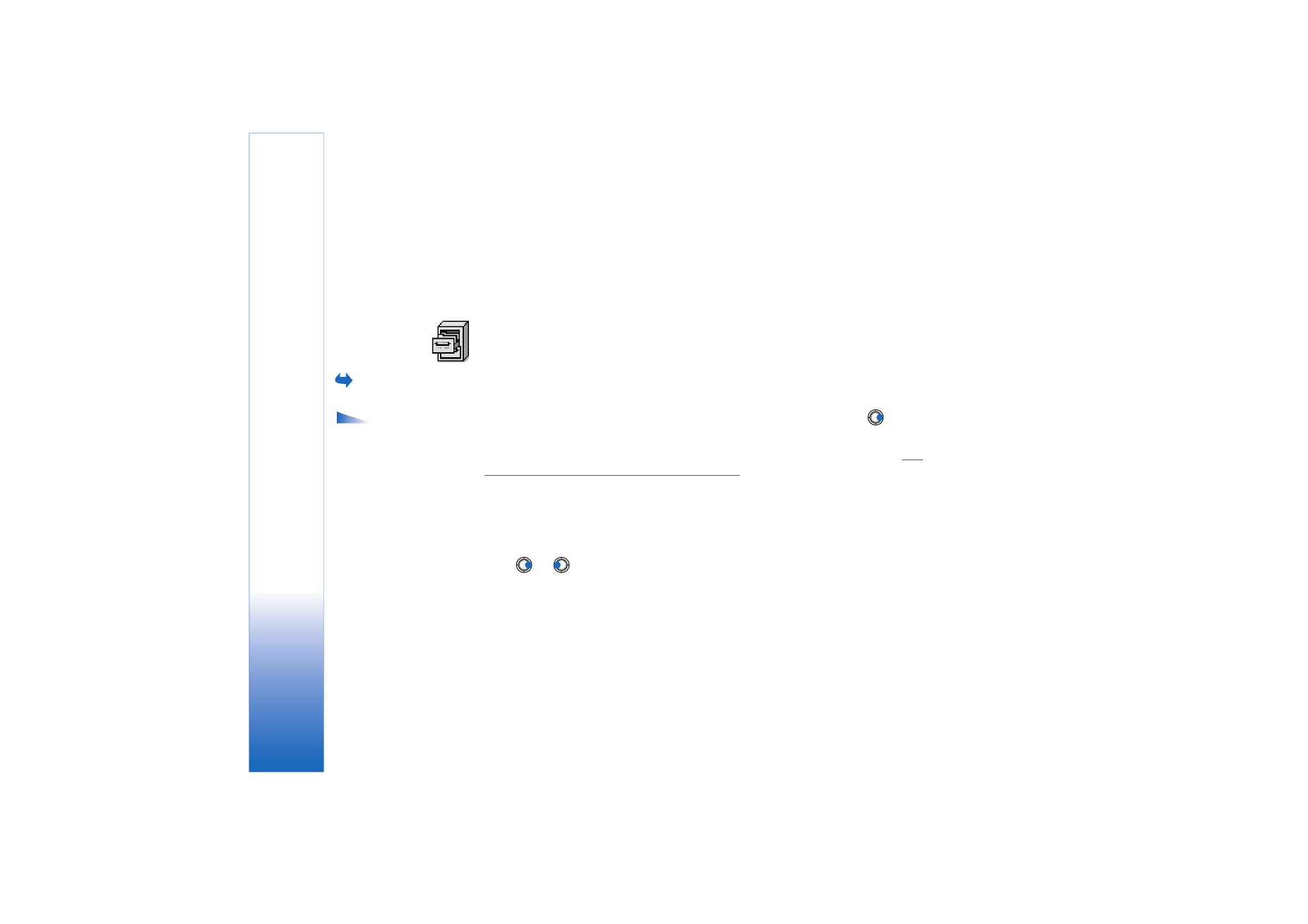
Copyright © 2004 Nokia. All rights reserved.
Tools
78
Password
— Your password for this profile.
Server will start configuration. Continue?
— Device management allowed on this server. Select
Yes
or
No
.
Auto-accept all reqs.
— Automatic or approved device management on this server. Select
Yes
to allow synchronisation without your verification, or select
No
to verify each
synchronisation attempt.
File manager
Go to
Menu
→
Tools
→
File manager
In File manager you can browse, open, and manage files and folders in the phone memory
or on the memory card, if you use one.
Options in the File
manager main view:
Open
,
Send
,
Delete
,
Move
to folder
,
Copy to folder
,
New folder
,
Mark/Unmark
,
Rename
,
Find
,
View details
,
Memory details
,
Help
, and
Exit
.
Open File manager to see a list of the folders in the phone memory. Press
to see the
folders on the memory card, if you use one.
You can browse, open, and create folders, mark, copy and move items to folders.
See
“Actions common to all applications” on page 12.
Viewing memory consumption
If you have a memory card installed on your phone, you will have a choice of two memory
views, one for the phone memory and one for the memory card.
Press
or
to move from one memory tab to another.
• To check memory consumption of the current memory select
Options
→
Memory details
.
The phone calculates the approximate amount of free memory for storing data and
installing new applications.
In the memory views, you can view the memory consumption of the different data groups:
Calendar
,
Contacts
,
Documents
,
Messages
,
Images
,
Sound files
,
Video clips
,
Applications
,
Mem.
in use
, and
Free memory
.

Copyright © 2004 Nokia. All rights reserved.
Tools
79
If the phone memory is getting low, remove some files, or move them to the memory card.
See “Troubleshooting” on page 120.
Voice commands
Go to
Menu
→
Tools
→
Voice
commands
.
You can use Voice commands to start applications and profiles, and to dial numbers from
Contacts, without having to look at your phone’s display. You record a word, or words,
(voice command) and then pronounce this voice command to open an application, activate
a profile, or dial a number.
You can have only one voice command per item.
Options in the
Voice commands main
view:
Add voice command
,
Open
,
New application
,
Playback
,
Change
,
Delete
,
Delete all
,
Help
, and
Exit
.
Any spoken word(s) can be a voice command.
• When recording, hold the phone at a short distance away from your mouth. After the
starting tone, clearly pronounce the word, or words, you want to record as a voice
command.
Before using voice tags, note that:
• Voice tags are not language-dependent. They are dependent on the speaker's voice.
• You must say the name exactly as you said it when you recorded it.
• Voice tags are sensitive to background noise. Record voice tags and use them in a quiet
environment.
• Very short names are not accepted. Use long names and avoid similar names for
different numbers.
Note: Using voice tags may be difficult in a noisy environment or during an
emergency, so you should not rely solely upon voice dialling in all circumstances.
Adding a voice command to an application
1 In the Voice commands main view, scroll to the application that you want to add a voice
command to, and select
Options
→
Add voice command
.

Copyright © 2004 Nokia. All rights reserved.
Tools
80
To add a voice command to a profile, the Profiles folder must be opened and a specific
profile selected.
2 The text
Press ’Start’, then speak after tone
is displayed.
• Press
Start
to record a voice command. The phone sounds a starting tone and the
note
Speak now
is displayed.
3 Pronounce the voice command. The phone will stop recording after approximately 5
seconds.
4 After recording, the phone plays the recorded command and the note
Playing voice
command
is displayed. If you do not want to save the recording, press
Quit
.
5 When the voice command has been successfully saved, the note
Voice command saved
is displayed and a beep sounds. A symbol
can be seen next to the application.
Adding an application to the list
Assign voice commands to other applications that are not listed in the Voice commands
main view.
1 In the Voice commands main view, select
Options
→
New application
.
2 Available applications are displayed. Scroll to the application that you want to add and
press
Select
.
3 Add a voice command to the new application.
See “Adding a voice command to an
application” on page 79.
Starting an application using a voice command
1 In standby mode, press and hold
. A short tone is played and the note
Speak now
is displayed.
2 When you are starting an application by saying a voice command, hold the phone at a
short distance away from your mouth and pronounce the voice command clearly.
3 The phone plays the original voice command and starts the application. If the phone
plays the wrong voice command, press
Retry
.

Copyright © 2004 Nokia. All rights reserved.
Tools
81
Replaying, erasing, or changing a voice command
To replay, erase, or change a voice command, scroll to the item that has a voice command
(indicated by
), select
Options
, and then either:
•
Playback
- To listen to the voice command again.
•
Delete
- To erase the voice command.
•
Change
- To record a new voice command. Press
Start
to record.
Memory card
For details on inserting a memory card into the phone, see the Getting Started guide. You
can use it to store your multimedia files such as video clips and sound files, photos,
messaging data, and to backup information from your phone’s memory.
Go to
Menu
→
Tools
→
Memory card
..
Included with your Nokia 6670 phone is a Reduced Size MultiMediaCard (RS-MMC) that
may contain add-on applications from independent developers. These applications are
designed by the devlopers to be compatible with your phone.
Details of how you can use the memory card with other features and applications of your
phone are given in the sections describing these features and applications.
Options in the
memory card:
Backup
phone mem.
,
Restore from
card
,
Format mem. card
,
Memory card name
,
Set
password
,
Change
password
,
Remove
password
,
Unlock memory
card
,
Memory details
,
Help
,
and
Exit
.
Keep all memory cards out of the reach of small children.
Use only compatible MultiMediaCards (MMC) with this device. Other memory cards, such
as Secure Digital (SD) cards, do not fit in the MMC card slot and are not compatible with
this device. Using an incompatible memory card may damage the memory card as well as
the device, and data stored on the incompatible card may be corrupted.
Format memory card
When a memory card is formatted, all data on the card is permanently lost.

Copyright © 2004 Nokia. All rights reserved.
Tools
82
Some memory cards are supplied pre-formatted and others require formatting. When
formatting, the memory card should always be formatted in your Nokia 6670 phone to
ensure correct operation. The memory access and performance cannot be guaranteed when
formatting with another operating system.
• Select
Options
→
Format mem. card
.
Select
Yes
to confirm. When formatting is complete, key a name for the memory card (max.
11 letters or numbers).
Backing up and restoring information
To back up information from your phone’s memory to the memory card, select
Options
→
Backup phone mem.
. To restore information from the memory card to the phone’s memory,
select
Options
→
Restore from card
.
You can only back up the phone memory and restore it to the same phone.
Locking the memory card
To set a password to lock your memory card against unauthorised use, select
Options
→
Set password
.
You will be asked to enter and confirm your password. The password can be up to eight
characters long.
The password is stored in your phone and you don’t have to enter it again while you are
using the memory card on the same phone. If you want to use the memory card on another
phone, you will be asked for the password.
Unlocking a memory card
If you insert another password-protected memory card in your phone, you will be prompted
to enter the password of the card. To unlock the card:
• Select
Options
→
Unlock memory card
.

Copyright © 2004 Nokia. All rights reserved.
Tools
83
Once the password is removed, the memory card is unlocked and can be used on another
phone without a password.
Checking memory consumption
You can check the memory consumption of different data groups and the available memory
for installing new applications or software on your memory card:
• Select
Options
→
Memory details
.
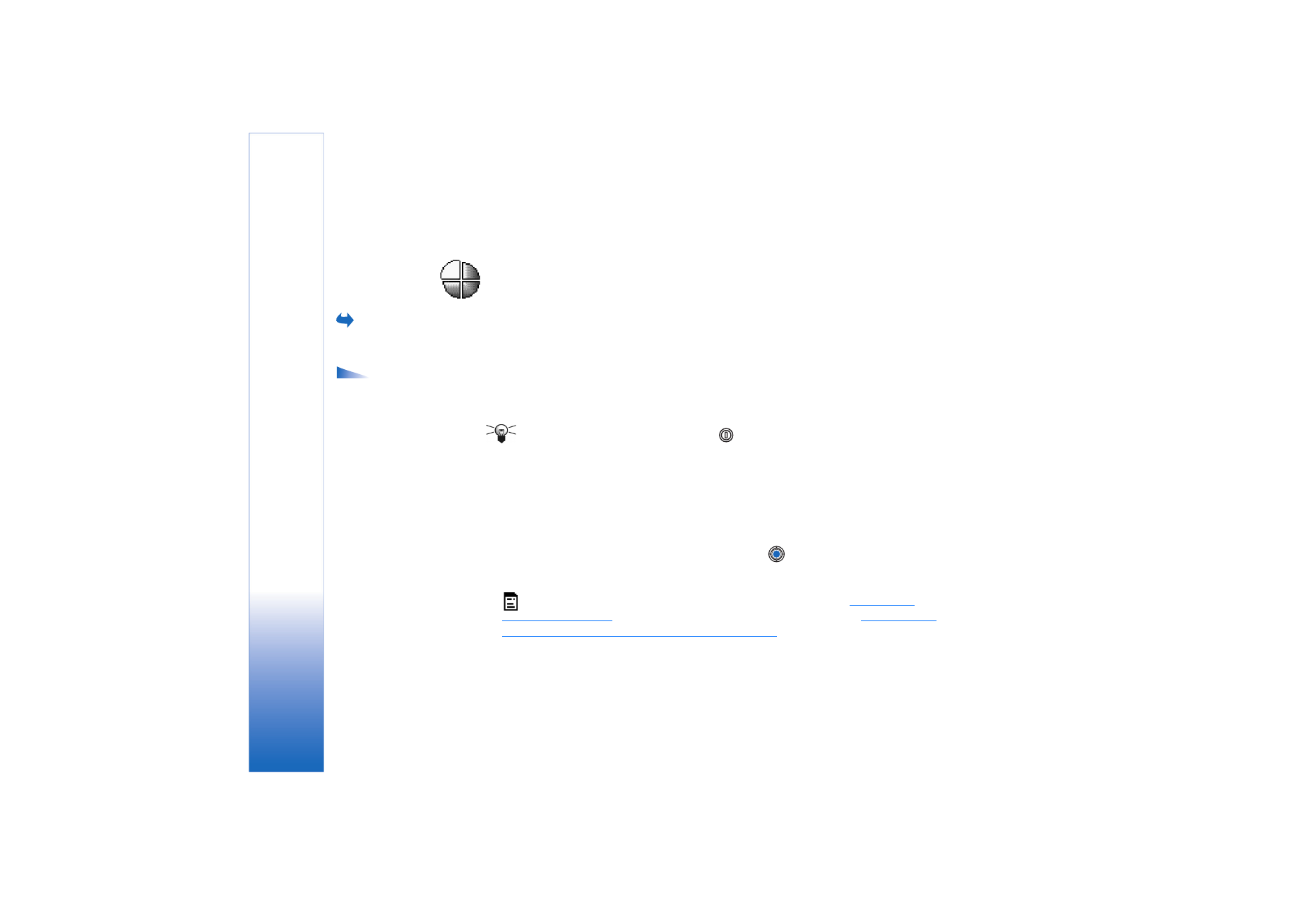
Copyright © 2004 Nokia. All rights reserved.
Personalising your phone
84
Personalising your phone
Profiles
Go to
Menu
→
Profiles
.
In Profiles, you can adjust and customise the phone tones for different events,
environments, or caller groups. You can see the currently selected profile at the top of the
display in standby mode. If the General profile is in use, only the current date is shown.
Options in the
Profiles main view:
Activate
,
Personalise
,
Create new
,
Delete
profile
,
Tone downloads
,
Help
, and
Exit
.
Changing the profile
1 Go to
Menu
→
Profiles
. A list of profiles opens.
2 In the Profiles list, scroll to a profile and select
Options
→
Activate
.
Shortcut! To change the profile, press
in standby mode, scroll to the profile you
want to activate and press
OK
.
Customising profiles
1 To modify a profile, scroll to the profile in the Profiles list and select
Options
→
Personalise
. To create a new profile, select
Options
→
Create new
. A list of profile
settings opens.
2 Scroll to the setting you want to change and press
to open the choices:
•
Ringing tone
- To set the ringing tone for voice calls, choose a ringing tone from the list.
Press any key to stop the sound. If a memory card is used, tones stored on it have the
icon next to the tone name. Ringing tones use shared memory.
See “Shared
memory” on page 14.
You can also change ringing tones in Contacts.
See “Adding a
ringing tone for a contact card or group” on page 23.

Copyright © 2004 Nokia. All rights reserved.
Personalising your phone
85
Tip! When you
scroll through the list, you
can stop on a tone to
listen to it before you
make your selection.
•
Ringing type
- When
Ascending
is selected, the ringing volume starts from level one and
increases level by level to the set volume level.
•
Ringing volume
- To set the volume level for the ringing and message alert tones.
•
Message alert tone
- To set the tone for messages.
•
Chat alert tone
- To set the tone for instant messages.
•
Vibrating alert
- To set the phone to vibrate at incoming voice calls and messages.
•
Keypad tones
- To set the volume level for keypad tones.
•
Warning tones
- The phone sounds a warning tone, for example, when the battery is
running low of power.
•
Alert for
- To set the phone to ring only upon calls from phone numbers that belong to
a selected contact group. Phone calls coming from people outside the selected group
will have a silent alert. The choices are
All calls
/ (list of contact groups, if you have
created them).
See “Creating contact groups” on page 26.
•
Availability
- Select
Available
,
Busy
, or
Not available
.
See “Presence settings” on page 30.
•
User availab. alerts
- Key in a message to display your current presence status.
See
“Presence settings” on page 30.
•
Profile name
- You can rename a profile and give it any name you want. The General
profile cannot be renamed.
Themes
Go to
Menu
→
Themes
.
You can change the look of your phone’s display by activating a theme. A theme can
include the idle screen wallpaper, colour palette, screen saver, and background image in
’Go to’. Edit a theme for more detailed personalisation.
Options in the
Themes main view:
Preview
,
Apply
,
Edit
,
Theme downloads
,
Help
,
and
Exit
.
When you open
Themes
you will see a list of the available themes. The currently active
theme is indicated by a check mark. Press
to see the themes on the memory card, if
you use one.
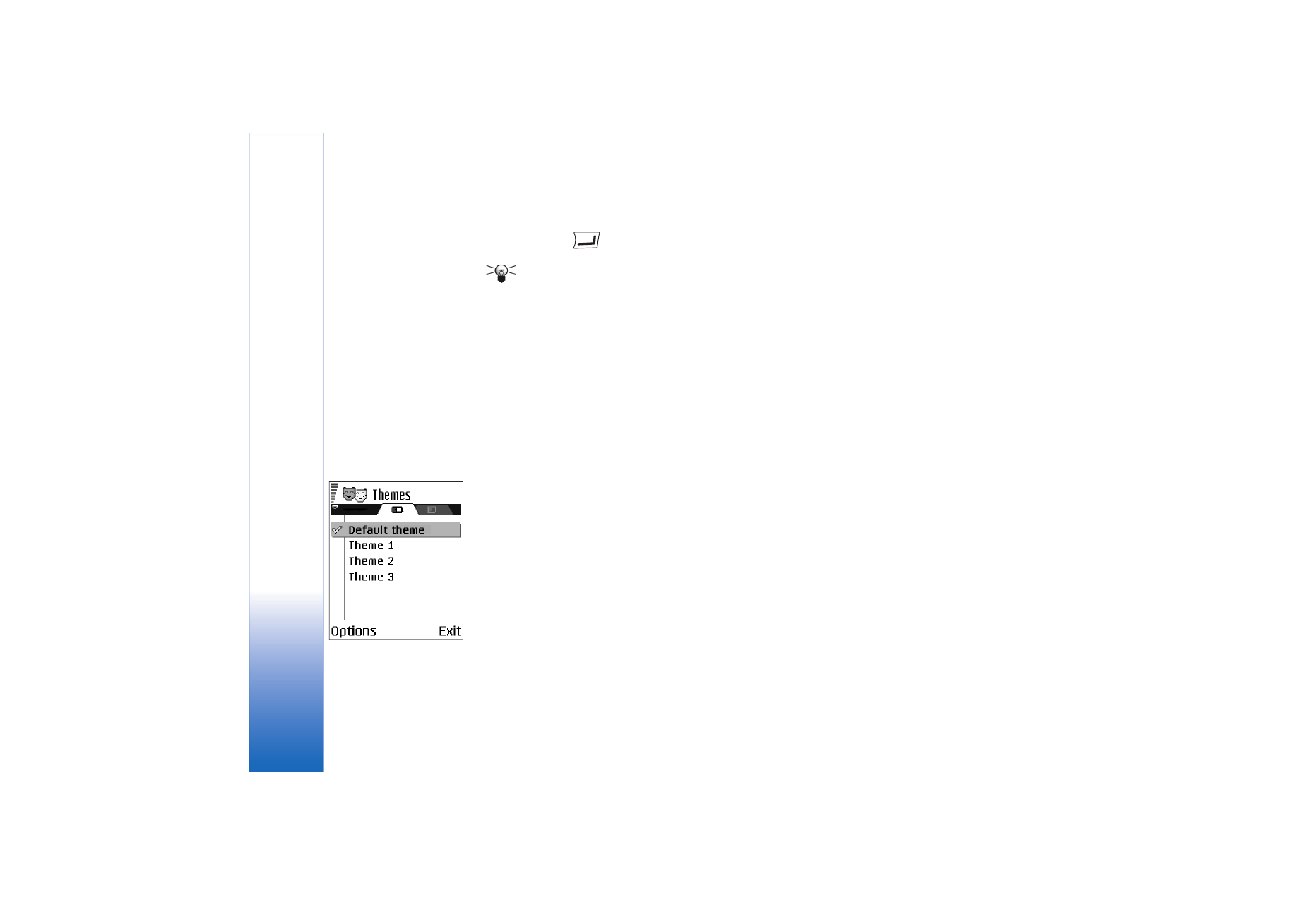
Copyright © 2004 Nokia. All rights reserved.
Personalising your phone
86
• To preview a theme, scroll to the theme and select
Options
→
Preview
to view the
theme. Press
to activate the theme. You can activate the theme without
previewing it by selecting
Options
→
Apply
from the main view.
Tip! You can copy themes that you have downloaded. To copy a theme from your
memory card to the phone memory, scroll to the theme and select
Options
→
Copy
to phone mem.
. To copy a theme from your phone memory to the memory card, scroll
to the theme and select
Options
→
Copy to mem. card
.
Editing themes
Group together elements from other themes, or images from the Gallery to personalise
themes further.
1 Scroll to a theme, select
Options
→
Edit
, and select:
•
Wallpaper
- To select an image from one of the available themes, or select your own
image from the Gallery, to use as a background image in standby mode.
•
Colour palette
- To change the colour palette used on the display.
•
Screen saver
- To select what is shown on the screen saver bar: the time and date or
a text you have written yourself. The location and background colour of the screen
saver bar changes in one minute intervals. Also, the screen saver changes to indicate
the number of new messages or missed calls. You can set the time that elapses before
the screen saver is activated.
See “Phone settings” on page 66.
•
Image in ’Go to’
- To select an image from one of the available themes, or select your
own image from the Gallery, to use as a background image in Go to.
2 Scroll to the element to be edited and select
Options
→
Change
.
3 Select
Options
→
Set
to select the current setting. You can also preview the selected
element by selecting
Options
→
Preview
. Note that you cannot preview all elements.
Restoring themes
To restore the currently selected theme back to its original settings, select
Options
→
Restore orig. theme
when editing a theme.
Fig. 12 The Themes main
view.
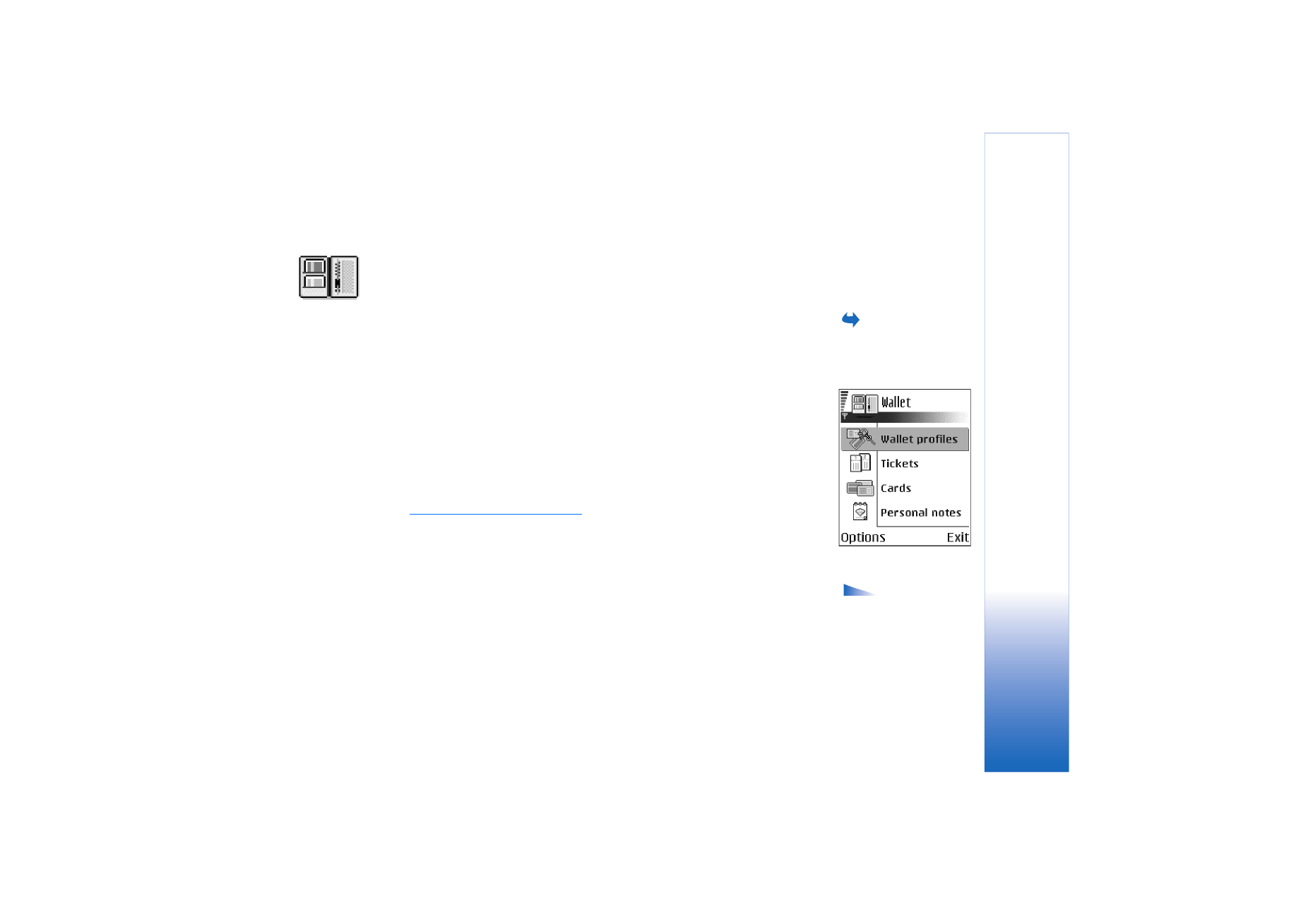
Copyright © 2004 Nokia. All rights reserved.
Extras
87
Extras
Wallet
Go to
Menu
→
Extras
→
Wallet
.
Wallet provides you with a storage area for your personal information, such as credit and
debit card numbers, addresses and other useful data, for example, user names and
passwords.
The information stored in the wallet can be easily retrieved while browsing to
automatically fill in online forms on browser pages, for example, when the service asks for
credit card details. Data in the wallet is encrypted and protected with a wallet code that
you define.
You can group wallet data into profiles that can be accessed, for example, for making
purchases online.
Due to the nature of the wallet, it will automatically close after 5 minutes. Enter the wallet
code to regain access to the contents. You can change this automatic time-out period, if
required.
See “Wallet settings” on page 90.
Options in the
wallet main view:
Open
,
Settings
,
Help
, and
Exit
.
Entering the wallet code
Each time you open the wallet you will be prompted for a wallet code.
When you open the wallet for the first time, you must create your own access code:
1 Enter a code of your choice (4 - 10 alphanumeric characters), and press
OK
.
Fig. 13 The wallet main
view.

Copyright © 2004 Nokia. All rights reserved.
Extras
88
2 You will be prompted to verify the code. Enter the same code and press
OK
. Do not give
your wallet code to anyone else.
Enter the code that you have created and press
OK
.
If you enter the wallet code incorrectly on three consecutive occasions, the wallet
application is blocked for five minutes. The block time increases if further incorrect wallet
codes are entered.
If you forget your wallet code, you will have to reset the code, and you will lose all
information stored in the wallet.
See “Resetting the wallet and wallet code” on page 91.
Storing personal card details
1 Select the
Cards
category from the main wallet menu and press
.
2 Select a type of card from the list and press
.
•
Payment cards
- Credit and debit cards.
•
Loyalty cards
- Membership and store cards.
•
Online acc. cards
- Personal user names and passwords to online services.
•
Address cards
- Basic contact details for home/office.
•
User info cards
- Customised personal preferences for online services.
3 Select
Options
→
Create new
. An empty form opens.
4 Fill in the fields and press
Done
.
You can also receive card information directly to the phone from a card issuer or service
provider (if they offer this service). You will be notified which category the card belongs to.
Either save or discard the card. You can view and rename a saved card, but you cannot edit
it.
You can open, edit or delete the fields in the card. Any changes will be saved upon exiting.

Copyright © 2004 Nokia. All rights reserved.
Extras
89
Options when
viewing or editing card
details:
Delete
,
Help
, and
Exit
.
Creating personal notes
Personal notes are a means of storing sensitive information, for example, a bank account
number. You can access the data in a personal note from the browser. You can also send a
note as a message.
• Select the
Personal notes
category from the main wallet menu and press
.
• Select
Options
→
Create new
. An empty note opens.
• Press
-
to start writing. Press
to clear characters. Press
Done
to
save.
Creating a wallet profile
Once you have stored your personal details, you can combine them together into a wallet
profile. Use a wallet profile to retrieve wallet data from different cards and categories to
the browser.
1 Select the
Wallet profiles
category from the main wallet menu and press
.
2 Select
Options
→
Create new
. A new wallet profile form opens.
3 Fill in the fields as indicated below and press
Done
.
Some of the fields must contain data selected from the wallet. You must save the data
under the relevant category before creating a wallet profile, or the profile cannot be
created.
•
Profile name
- Choose and enter a name for the profile.
•
Payment card
- Select a card from the Payment card category.
•
Loyalty card
- Select a card from the Loyalty card category.
•
Online access card
- Select a card from the Online acc. card category.
•
Shipping address
- Select an address from the Address card category.
•
Billing address
- By default this is the same as the Shipping address. If you require a
different address, select one from the Address card category.
•
User info card
- Select a card from the User info card category.
•
Receive e-receipt
- Select a destination from the Address card category.

Copyright © 2004 Nokia. All rights reserved.
Extras
90
•
Deliver e-receipt
- Select
To phone
,
To e-mail
, or
To pho. & e-mail
.
•
RFID sending
- Set to
On
or
Off
. Defines whether, or not, your unique phone
identification is sent with the wallet profile (for future development dependent on
RFID-based ticketing).
Retrieving information from the wallet to your browser
When using online mobile services supporting the wallet functionality, you can upload the
data stored in your wallet to automatically enter your details into an online form. For
example, by uploading your payment card details you do not need to key in the card
number and expiry date each time you need them (depending on the content being
browsed). Also, you can retrieve your user name and password stored as an access card
when connecting to a mobile service that requires authentication.
See “Purchasing an
item” on page 106.
Viewing ticket details
Options in the
Tickets main view:
View
,
Delete
,
Rename
,
Mark/
Unmark
,
Help
, and
Exit
.
You can receive notifications of tickets purchased online via the browser. Received
notifications are stored in the wallet. To view the notifications:
1 Select the
Tickets
category from the main wallet menu and press
.
2 Select
Options
→
View
.
Wallet settings
Select
Options
→
Settings
from the main wallet menu:
•
Wallet code
- Change your wallet code. You will be prompted to enter the current code,
create a new code, and verify the new code.
•
RFID
- Set the phone ID code, type, and sending options (for future development
dependent on RFID-based ticketing).

Copyright © 2004 Nokia. All rights reserved.
Extras
91
•
Automatic close
- Change the automatic time-out period (1 - 60 minutes). After the
time-out period has elapsed, the wallet code must be re-entered to gain access to the
contents.
Resetting the wallet and wallet code
To reset both the contents of the wallet and the wallet code:
1 Key in *#7370925538# in standby mode.
2 Enter the phone’s lock code, and press
OK
.
See “Security” on page 74.
3 You will be asked to confirm the erasing of data. Press
OK
.
When opening the wallet again, you must enter a new wallet code.
See “Entering the wallet
code” on page 87.
Calculator
Go to
Menu
→
Extras
→
Calculator
.
1 Enter the first number of your calculation. If you make a mistake, press
to erase it.
2 Scroll to an arithmetic function and press
to select it.
3 Enter the second number.
4 To execute the calculation, scroll to
and press
.
Options in
Calculator:
Last result
,
Memory
,
Clear screen
,
Help
,
and
Exit
.
Note: This calculator has limited accuracy and is designed for simple calculations.
• To add a decimal, press
.
• Press and hold
to clear the result of the previous calculation.
• Use
and
to view previous calculations and move in the sheet.
Converter
Go to
Menu
→
Extras
→
Converter
.
In Converter, you can convert measures such as
Length
from one unit to another, for
example,
Yards
to
Metres
.

Copyright © 2004 Nokia. All rights reserved.
Extras
92
The Converter has limited accuracy and rounding errors may occur.
Converting units
Options in
Converter:
Conversion
type
,
Currency rates
(not
applicable to other units),
Help
, and
Exit
.
To make currency conversion you must first set the exchange rate.
See “Setting a base
currency and exchange rates” on page 92.
1 Scroll to the
Type
field and press
to open a list of measures. Scroll to the measure
you want to use and press
OK
.
2 Scroll to the first
Unit
field and press
to open a list of available units. Select the
unit from which you want to convert and press
OK
.
3 Scroll to the next
Unit
field and select the unit to which you want to convert.
4 Scroll to the first
Amount
field and key in the value you want to convert. The other
Amount
field changes automatically to show the converted value.
Press
to add a decimal and press
for the +, - (for temperature), and E
(exponent) symbols.
The conversion order changes if you write a value in the second
Amount
field. The result is
shown in the first
Amount
field.
Setting a base currency and exchange rates
Before you can make currency conversions, you need to choose a base currency (usually
your domestic currency) and add exchange rates.
The rate of the base currency is always 1. The base currency determines the conversion
rates of the other currencies.
1 Select
Currency
as the measure type and select
Options
→
Currency rates
. A list of
currencies opens and you can see the current base currency at the top.
2 To change the base currency, scroll to the currency (usually your domestic currency),
and select
Options
→
Set as base curr.
.

Copyright © 2004 Nokia. All rights reserved.
Extras
93
Tip: When you change the base currency, all previously set exchange rates are
set to 0 and you need to key in new rates.
3 Add exchange rates, scroll to the currency, and key in a new rate, that is, how many
units of the currency equal one unit of the base currency you have selected.
4 After you have inserted all the required exchange rates, you can make currency
conversions.
See “Converting units” on page 92.
Notes
Go to
Menu
→
Extras
→
Notes
.
You can link notes to Go to and send them to other devices. Plain text files (TXT format)
you receive can be saved to Notes.
• Press
-
to start to write. Press
to clear letters. Press
Done
to save.
Clock
Go to
Menu
→
Extras
→
Clock
.
Changing clock settings
Options in Clock:
Set alarm
,
Reset alarm
,
Remove alarm
,
Settings
,
Help
, and
Exit
.
• To change the time or date, select
Options
→
Settings
in Clock.
Setting an alarm
1 To set a new alarm, select
Options
→
Set alarm
.
2 Enter the alarm time and press
OK
. When the alarm is active, the
indicator is shown.
• To cancel an alarm, go to clock and select
Options
→
Remove alarm
.
Turning off the alarm
• Press
Stop
to turn off the alarm.
• Press
Snooze
to stop the alarm for five minutes, after which it will resume. You can do
this a maximum of five times.
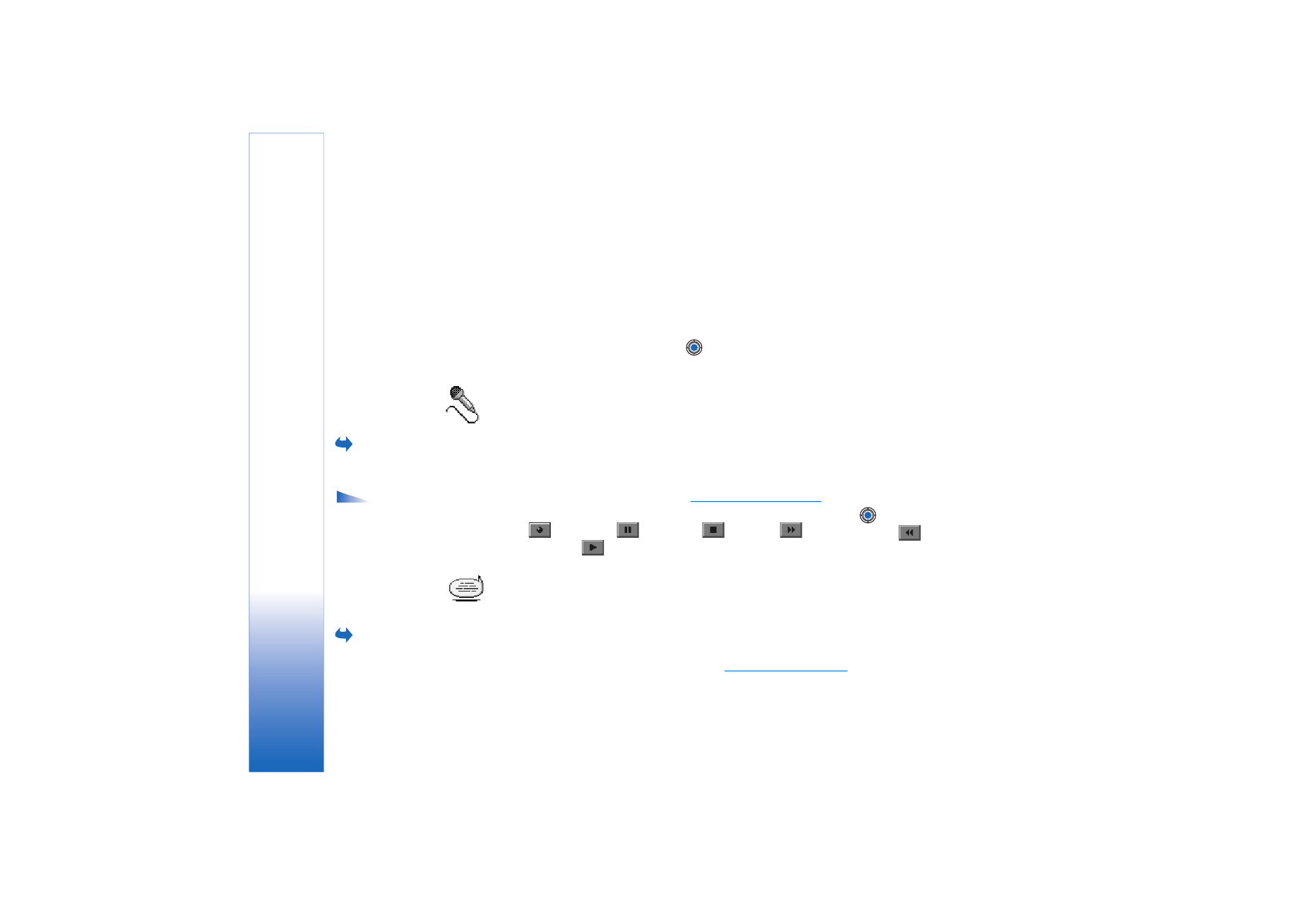
Copyright © 2004 Nokia. All rights reserved.
Extras
94
If the alarm time is reached while the phone is switched off, the phone switches itself on
and starts sounding the alarm tone. If you press
Stop
, the phone asks whether you want
to activate the phone for calls. Press
No
to switch off the phone or
Yes
to make and receive
calls. Do not press
Yes
when wireless phone use is prohibited or when it may cause
interference or danger
Personalising the alarm tone
1 To personalise the alarm tone, select
Options
→
Settings
.
2 Scroll to
Clock alarm tone
and press
.
3 When you scroll through the list of tones, you can stop on a tone to listen to it before
you make your selection. Press
Select
to select the current tone.
Recorder
Go to
Menu
→
Extras
→
Recorder
.
The voice recorder allows you to record telephone conversations and voice memos. If you
are recording a telephone conversation, both parties will hear a tone every five seconds
during recording.
Options in
Recorder:
Record sound
clip
,
Delete
,
Rename sound
clip
,
Send
,
Go to Gallery
,
Settings
,
Add to ’Go to’
,
Help
, and
Exit
.
Recorded files are stored in the Gallery.
See “Gallery” on page 41.
• Select
Options
→
Record sound clip
and scroll to a function and press
to select it.
Use:
- to record,
- to pause,
- to stop,
- to fast forward,
- to
fast rewind, or
- to play an opened sound file.
Recorder cannot be used when a data call or a GPRS connection is active.
Chat (Network Service)
Go to
Menu
→
Extras
→
Chat
.
Chat allows you to converse with other people using instant messages, and join discussion
forums (chat groups) with specific topics. Once you have registered with a chat service, you
can log into the service provider’s chat server.
See Fig. 14 on page 95.
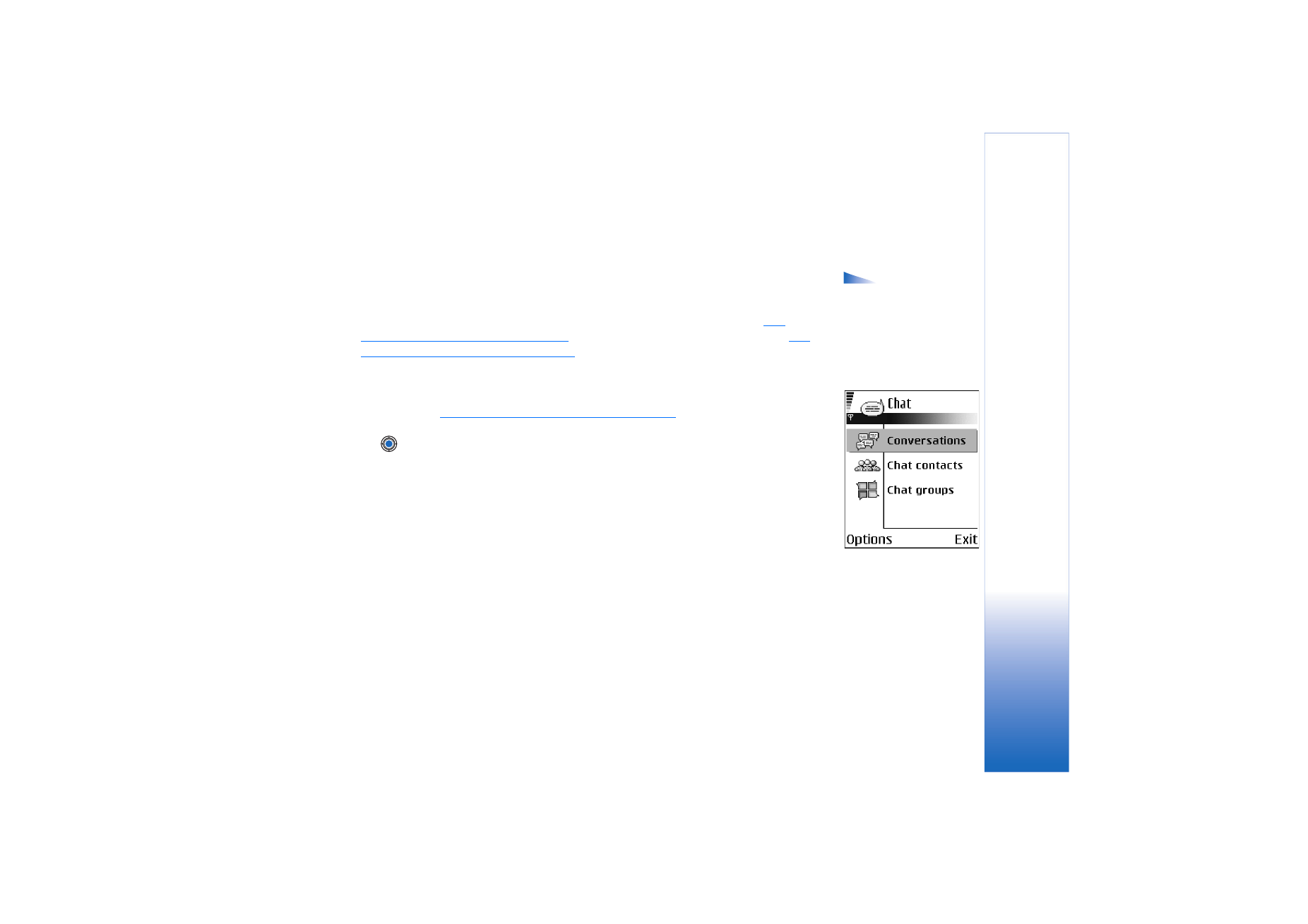
Copyright © 2004 Nokia. All rights reserved.
Extras
95
Check the availability of chat services, pricing, and tariffs with your network operator and/
or service provider. Service providers will also give you instructions on how to use their
services.
Options in the
Chat main view:
Open
,
Login
,
Logout
,
Settings
,
Help
, and
Exit
.
Before using Chat
To access a chat service you need to save the settings for that service. You may receive the
settings from the network operator or service provider that offers the service.
See
“Receiving smart messages” on page 52.
You can also key in the settings manually.
See
“Chat and Presence servers” on page 100.
Connecting to a chat server
1 Go to
Menu
→
Chat
to connect to a chat server. You can change the chat server to
connect to.
See “Chat and Presence servers” on page 100.
2 Once the connection has been established, key in your user ID and password and press
, or press
Cancel
to stay offline. When you are offline, your phone is not connected
to the chat server and you cannot send or receive messages. To log in later, select
Options
→
Login
.
You obtain the user ID and password from your service provider.
To log out, select
Options
→
Logout
.
Modifying your chat settings
Select
Options
→
Settings
→
Chat settings
.
•
Use screen name
- Select
Yes
to key in a nickname (max. 10 characters).
•
Chat presence
- To prevent others from seeing if you are online, select
Not active
.
•
Allow messages from
- Select
All
,
From chat contacts
or
None
.
•
Allow invitations from
- Select
All
,
From chat contacts
or
None
.
•
Message speed
- Select the speed at which new messages are displayed.
Fig. 14 The Chat main
view.
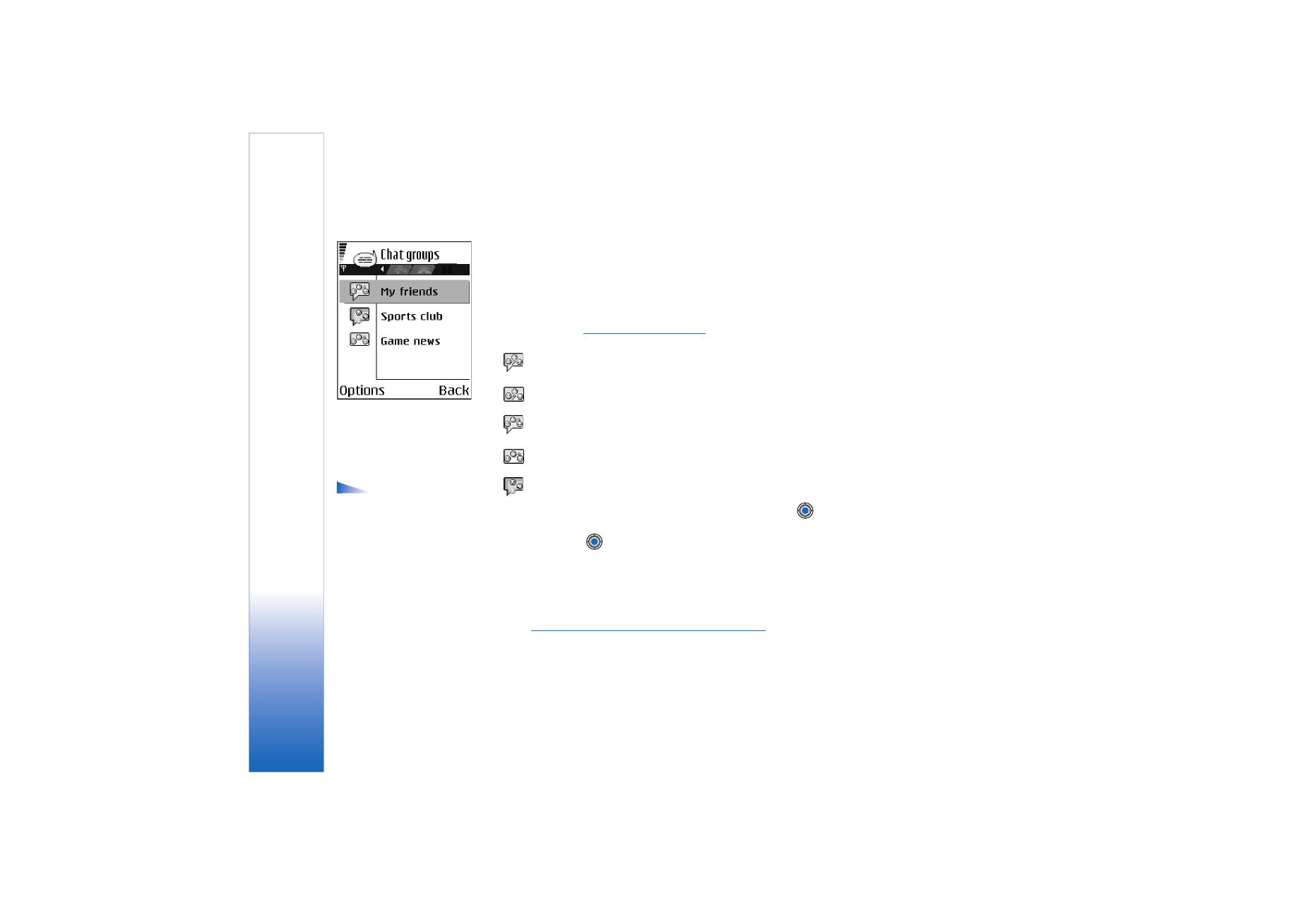
Copyright © 2004 Nokia. All rights reserved.
Extras
96
•
Auto-reload availab.
- To choose how to update information about whether your chat
contacts are online or offline. Select
Automatically
or
Manually
.
•
Reload user availab.
- Select
For all contacts
or
For sel. contacts
.
Joining and leaving a chat group
Go to the
Chat groups
view. A list of chat groups that you have saved or are currently
joined to is shown.
See Fig. 15 on page 96.
The icon next to a group indicates what type it
is:
•
- A group that you have created and are currently joined to.
•
- A group that you have created but are not currently joined to.
•
- A group that you have saved and are currently joined to.
•
- A group that you have saved but are not currently joined to.
Options in the
Chat groups view:
Open
,
Join group
,
Create new
group
,
Leave chat group
,
Chat group
,
Search
,
Settings
,
Help
, and
Exit
.
•
- A group that you are currently joined to but have not saved.
To join a chat group: Scroll to a group on the list and press
. To join a chat group not
on the list but for which you know the group ID, select
Options
→
Join group
. Key in the
group ID and press
.
You can scroll to a group, press
Options
→
Chat group
and then select:
Save group
,
Delete
,
View members
to see who are currently joined to the group,
Chat group details
to see the
group ID, topic, members, editing rights in the group, and whether sending private
messages is allowed in the group, and
Chat group settings
to view and edit the chat group’s
settings.
See “Editing chat group settings” on page 99.
To leave the chat group: Select
Options
→
Leave chat group
.
Fig. 15 The Chat groups
view.

Copyright © 2004 Nokia. All rights reserved.
Extras
97
Searching for chat groups and users
Go to the
Chat groups
view and select
Options
→
Search
→
Groups
or
Users
.
• You can search for
Groups
by
Group name
,
Topic
, and
Members
(user ID). For groups that
you have found you can select
New search
,
Join
and
Save group
.
• You can search for
Users
by
User's name
,
User ID
,
Phone number
, and
E-mail address
. For
users that you have found you can select
New search
,
Open conversation
,
Add to Chat
contact
to save the contact,
Send invitation
, and
Add to blocked list
to block (or unblock)
messages from the contact.
When the search result is displayed, you can select
Options
→
New search
,
More results
from
the same search, and
Previous results
to see your previous search result.
Chatting in a chat group
Once you have joined a chat group, you can view the messages that are exchanged in the
group, and send your own messages.
Options while
chatting:
Send
,
Send
private msg.
,
Reply
,
Send
invitation
,
Leave chat group
,
Save group
,
Record
convers.
/
Stop recording
,
Help
, and
Exit
.
• To send a message, write the message and press
.
• To send a private message to a member (if allowed in the group), select
Options
→
Send
private msg.
, select the recipient, write the message, and press
.
To reply to a private message sent to you, select
Options
→
Reply
.
To invite chat contacts who are online to join the chat group (if allowed in the group),
select
Options
→
Send invitation
, select the contacts you want to invite, write the invitation
message, and press
Done
.
Recording messages
To record the messages that are exchanged in a chat group or during an individual
conversation, select
Options
→
Record convers.
. Key in the name for the message file and
press
. To stop recording, select
Options
→
Stop recording
.
The recorded message files are saved to Notes.
See “Notes” on page 93.
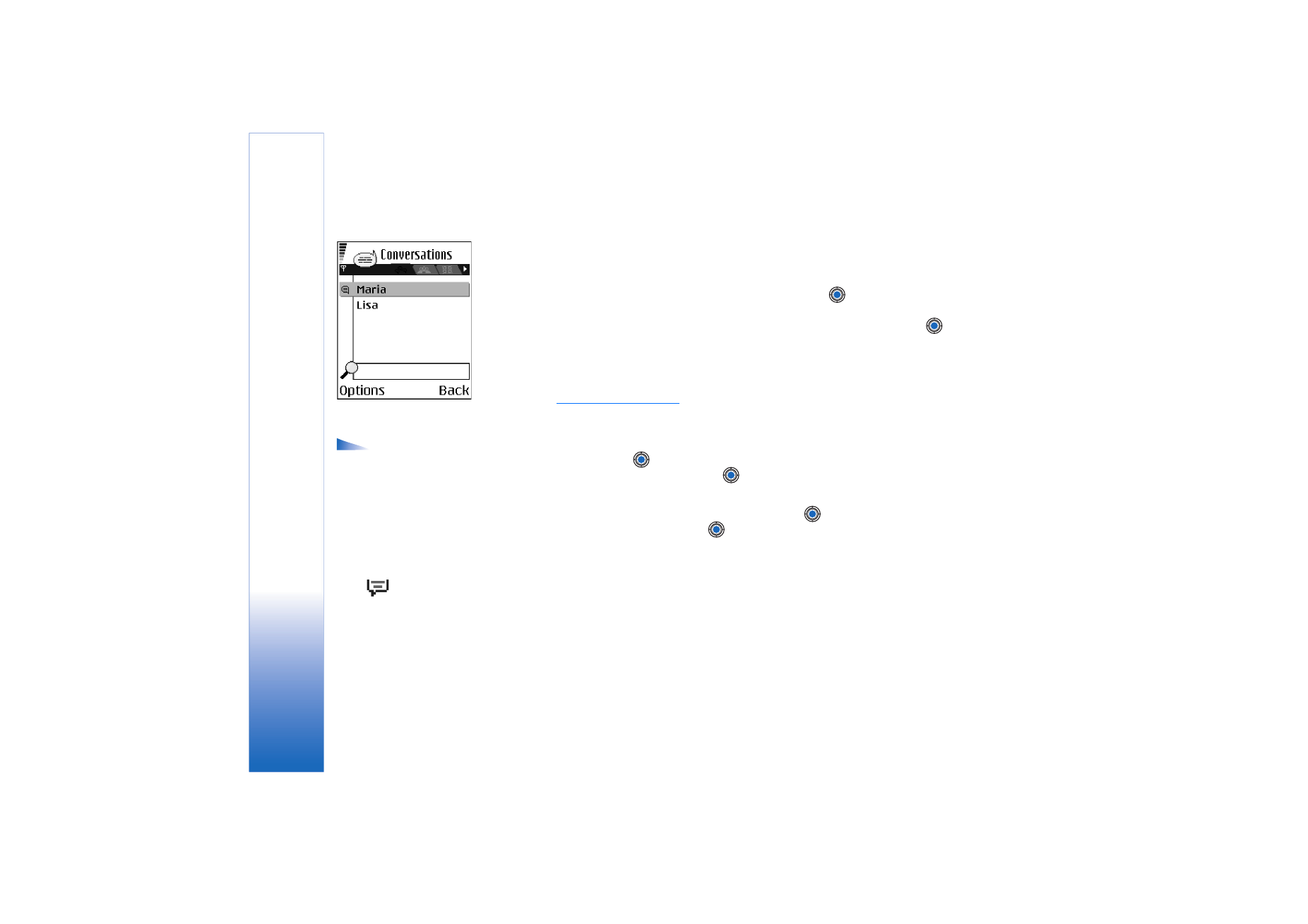
Copyright © 2004 Nokia. All rights reserved.
Extras
98
Blocking messages
To prevent receiving messages from certain chat users, select
Options
→
Blocking options
and then select:
•
Add to blocked list
- To block messages from the currently selected user.
•
Add ID to list manually
- Key in the user ID of the user and press
.
•
View blocked list
- To see the users whose messages are blocked.
•
Unblock
- Select the user that you want to remove from the blocked list and press
.
Starting and viewing individual conversations
Go to the
Conversations
view for a list of the chat users with whom you have an ongoing
conversation.
See Fig. 16 on page 98.
To start a new conversation, select
Options
→
New conversation
and then select:
Options in the
Conversations view:
Send
,
Add to chat contact
,
Forward
,
Record convers.
/
Stop recording
,
Blocking
options
,
End conversation
,
Help
, and
Exit
.
•
Select recipient
- To see a list of your saved chat contacts that are currently online. Scroll
to the contact and press
.
•
Enter user ID
- Key in the user ID and press
. The user ID is provided by the service
provider to those who register to the service.
To view an ongoing conversation, scroll to the user and press
. To continue the
conversation, write your message and press
. To return to the conversations list without
closing the conversation, press
Back
.
To close the conversation, select
Options
→
End conversation
.
Icon:
next to a user
indicates that you have
received a new message
from that user.
Ongoing conversations are automatically closed when you exit Chat.
To save a user to your chat contacts, scroll to the user and select
Options
→
Add to Chat
contact
.
To send automatic replies to incoming messages, select
Options
→
Set auto reply on
. Key in
the text and press
Done
.
Fig. 16 The Conversations
view.

Copyright © 2004 Nokia. All rights reserved.
Extras
99
Chat contacts
Go to the
Chat contacts
view to see a list of your saved chat contacts.
is shown next
to contacts that are currently online, and
for contacts that are offline.
To create a new contact, select
Options
→
New chat contact
. Fill in the
Name
and
User ID
fields and press
Done
.
You can scroll to a contact and press
to view contact details. Press
Options
and select:
•
Edit
- To edit the contact’s details.
•
Open conversation
- To start a new conversation or continue an ongoing conversation
with the contact.
•
Switch tracking on
- To be notified every time the chat contact goes online or offline.
•
Belongs to groups
- To see which groups the chat contact has joined.
•
Reload user availab.
- To update information about whether contacts are online or
offline. This option is not available if you have set the
Auto-reload availab.
to
Automatically
in
Chat settings
.
Editing chat group settings
You can edit the settings for a chat group if you have created the group or if the creator
of the group has given you editing rights. Go to the
Chat groups
view, scroll to the desired
group and select
Options
→
Chat group
→
Chat group settings
.
See “Creating a new chat
group” on page 99.
Creating a new chat group
Go to the
Chat groups
view and select
Options
→
Create new group
. Key in the settings for
the group:
•
Group name
,
Group topic
, and a
Welcome note
that the participants see when they join
the group.
•
Group size
- Maximum number of members allowed to join the group.
•
Allow search
- To define if others can find the chat group by searching.

Copyright © 2004 Nokia. All rights reserved.
Extras
100
Options in the
Chat contacts view:
Open
,
Open conversation
,
Switch
tracking on
,
Belongs to
groups
,
New chat contact
,
Edit
,
Delete
,
Reload user
availab.
,
Blocking options
,
Search
,
Settings
,
Help
, and
Exit
.
•
Editing rights
- Scroll to the chat group members to whom you want to give editing
rights and permission to invite contacts to join the group.
•
Group members
-
See “Restricting access to a chat group” on page 100.
•
Banned
- Displays a list of banned users.
•
Allow private msgs.
- To allow or prevent private messaging between members.
•
Group ID
- Is created automatically and cannot be changed.
Restricting access to a chat group
You can make a chat group closed by creating a
Group members
list. Only the users on the
list are allowed to join the group. Go to the
Chat groups
view, scroll to the group and select
Options
→
Chat group
→
Chat group settings
→
Group members
→
Selected only
.
• To add a user to the list, select
Add
and
Chat contact
or
Enter user ID
.
• To remove a user from the list, scroll to the user and select
Remove
.
• To clear the list and allow all chat users to join the group again select
Remove all
.
Chat and Presence servers
Select
Options
→
Settings
→
Server settings
. You may receive the settings as a smart
message from the service provider that offers the chat service.
• To change the chat or presence server you wish to connect to, select
Server in use
.
• To change the Presence login type, select
Login type
and select
Automatic
,
Aut. in home
net.
, or
Manual
.
• To change the Chat login type, select
Login type
and select
Automatic
or
Manual
.
• To add a new server, select
Options
→
New server
. Key in or select the settings:
Server
name
and
Access point in use
to connect to the server,
Web address
of the chat server,
your
User ID
and login
Password
.
See “Connection settings” on page 68.
You obtain the user ID and password from your service provider when you register to
the service. If you do not know your user ID or password, contact your service provider.

Copyright © 2004 Nokia. All rights reserved.
Extras
101
Go to
Use Go to for storing shortcuts, links to your favourite photos, video clips, notes, Recorder
sound files, browser bookmarks, and saved browser pages.
Press
Go to
in
standby mode or go to
Menu
→
Extras
→
Go to
.
The default shortcuts:
- opens the Notes editor,
- opens the Calendar to the current
date, and
- opens the Messaging Inbox.
Options in the Go
to main view:
Open
,
Edit
shortcut name
,
Move
,
List
view
/
Grid view
,
Help
, and
Exit
.
Adding shortcuts
Shortcuts can be added only from pre-installed applications and functions. Not all
applications have this functionality.
1 Open the application and scroll to the item that you want to add as a shortcut.
2 Select
Options
→
Add to ’Go to’
and press
OK
.
Shortcut! A shortcut in Go to is automatically updated if you move the item it is
pointing to, for example, from one folder to another.
Using shortcuts:
• To open a shortcut, scroll to the icon and press
. The file is opened in the
corresponding application.
• To delete a shortcut, scroll to the shortcut you want to remove and select
Options
→
Delete shortcut
. Removing a shortcut does not affect the file it is referring to. The default
shortcuts can not be deleted.
• To change the shortcut name, select
Options
→
Edit shortcut name
. Write the new
name. This change affects only the shortcut, not the file or item the shortcut refers to.

Copyright © 2004 Nokia. All rights reserved.
Services and Applications
102
Services and Applications
Web (Mobile browser)
Go to
Menu
→
Web
or press and hold
in standby mode.
Various service providers maintain pages specifically designed for mobile phones, offering
services that can be, for example, news, weather reports, banking, travel information,
entertainment, and games. With the mobile browser you can view these services as WAP
pages written in WML, XHTML pages written in XHTML, or a mixture of both. If you have
not yet used your phone to make a WAP connection, you may need to contact your service
provider for assistance with the first-time connection or visit www.nokia.com/
phonesettings.
A cache is a memory location that is used to store data temporarily. If you have tried to
access or have accessed confidential information requiring passwords, empty the cache
after each use. The information or services you have accessed is stored in the cache. To
empty the cache, select
Options
→
Navigation options
→
Clear cache
.
Check the availability of services, pricing, and tariffs with your network operator and/or
service provider. Service providers will also give you instructions on how to use their
services.
Basic steps for accessing
• Save the settings that are needed to access the browser service that you want to use.
See “Setting up the phone for the browser service” on page 103.
• Make a connection to the service.
See “Making a connection” on page 103.
• Start browsing the web pages.
See “Browsing” on page 104.
• End the connection to the service.
See “Ending a connection” on page 107.

Copyright © 2004 Nokia. All rights reserved.
Services and Applications
103
Setting up the phone for the browser service
Receiving settings in a smart message
You may receive service settings in a special text message, a so-called smart message, from
the network operator or service provider that offers the service.
See “Receiving smart
messages” on page 52.
For more information, contact your network operator or service
provider.
Keying in the settings manually
Follow the instructions given to you by your service provider.
1 Go to
Settings
→
Connection
→
Access points
and define the settings for an access point.
See “Connection settings” on page 68.
2 Go to
Web
→
Options
→
Bookmark manager
→
Add bookmark
. Write a name for the
bookmark and the address of the browser page defined for the current access point.
Making a connection
Once you have stored all the required connection settings, you can access browser pages.
There are three different ways to access browser pages:
• Select the homepage (
) of your service provider.
• Select a bookmark from the Bookmarks view.
• Press the keys
-
to start to write the address of a browser service. The Go
to field at the bottom of the display is immediately activated and you can continue
writing the address there.
After you have selected a page or written the address, press
to start to download the
page.

Copyright © 2004 Nokia. All rights reserved.
Services and Applications
104
Viewing bookmarks
Your device may have some bookmarks loaded for sites not affiliated with Nokia. Nokia
does not warrant or endorse these sites. If you choose to access them, you should take the
same precautions, for security or content, as you would with any Internet site.
Options in the
Bookmarks view (when a
bookmark or folder is
selected):
Open
,
Download
,
Back to page
,
Bookmark manager
,
Mark/
Unmark
,
Navigation
options
,
Advanced options
,
Send
,
Find bookmark
,
Details
,
Settings
,
Help
, and
Exit
.
In the Bookmarks view, you can see bookmarks pointing to different kinds of browser
pages. Bookmarks are indicated by the following icons:
- The starting page defined for the browser access point. If you use another browser
access point for browsing, the starting page is changed accordingly.
- The last visited page. When the phone is disconnected from the service, the address
of the last visited page is kept in memory until a new page is visited during the next
connection.
When you scroll through bookmarks, you can see the address of the highlighted bookmark
in the Go to field at the bottom of the display.
- A bookmark showing the title.
Adding bookmarks manually
1 In the Bookmarks view, select
Options
→
Bookmark manager
→
Add bookmark
.
2 Start to fill in the fields. Only the address must be defined. The default access point is
assigned to the bookmark if no other one is selected. Press
to enter special
characters such as /, ., :, and @. Press
to clear characters.
3 Select
Options
→
Save
to save the bookmark.
Browsing
On a browser page, new links appear underlined in blue and previously visited links in
purple. Images that act as links have a blue border around them.

Copyright © 2004 Nokia. All rights reserved.
Services and Applications
105
Options when
browsing:
Open
,
Service
options
,
Bookmarks
,
Save as
bookmark
,
View image
,
Navigation options
,
Advanced options
,
Send
bookmark
,
Find
,
Details
,
Settings
,
Help
, and
Exit
.
Keys and commands used in browsing
• To open a link, press
.
• To scroll the view, use the scroll key.
• To enter letters and numbers in a field, press the keys
-
. Press
to enter special characters such as /, ., :, and @. Press
to clear characters.
• To go to the previous page while browsing, press
Back
. If
Back
is not available, select
Options
→
Navigation options
→
History
to view a chronological list of the pages you
have visited during a browsing session. The history list is cleared each time a session is
closed.
• To check boxes and make selections, press
.
• To retrieve the latest content from the server, select
Options
→
Navigation options
→
Reload
.
• To open a sublist of commands or actions for the currently open browser page, select
Options
→
Service options
.
• Press and hold
to disconnect from a browser service and to quit browsing.
Saving bookmarks
• To save a bookmark while browsing, select
Options
→
Save as bookmark
.
• To save a bookmark received in a smart message, open the message in the Inbox in
Messaging and select
Options
→
Save to bookmarks
.
See “Receiving smart messages” on
page 52.
Viewing saved pages
Options in the
Saved pages view:
Open
,
Back to page
,
Reload
,
Saved
pages mngr.
,
Mark/Unmark
,
Navigation options
,
Advanced options
,
Details
,
Settings
,
Help
, and
Exit
.
If you regularly browse pages containing information which doesn’t change very often, you
can save and then browse them when offline.
• To save a page, while browsing select
Options
→
Advanced options
→
Save page
.
Saved pages are indicated by the following icon:
- The saved browser page.
In the saved pages view you can also create folders to store your saved browser pages.
See Fig. 17 on page 106.
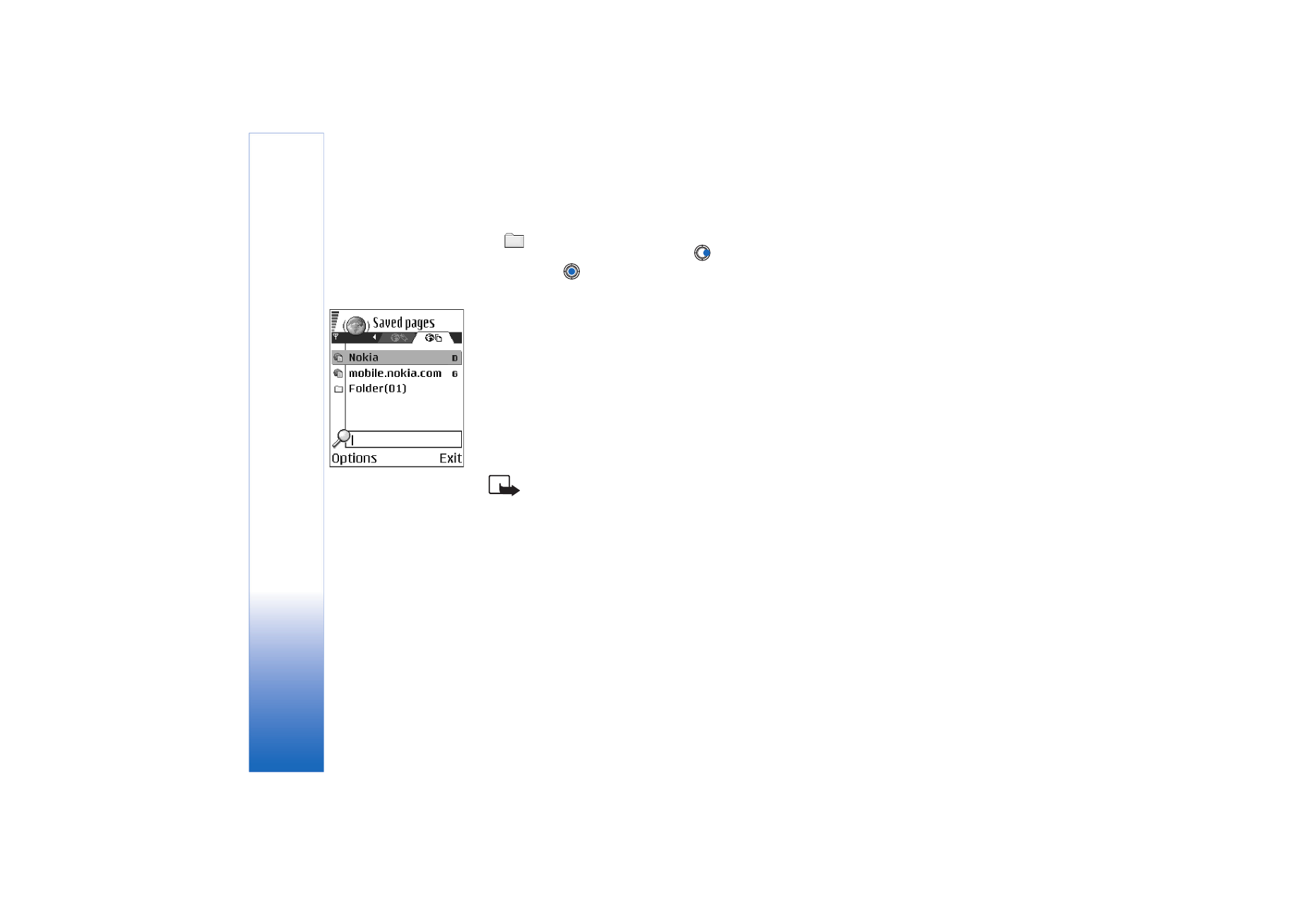
Copyright © 2004 Nokia. All rights reserved.
Services and Applications
106
Folders are indicated by the following icon:
- Folder containing saved browser pages.
• To open the Saved pages view, press
in the Bookmarks view. In the Saved pages
view, press
to open a saved page.
To start a connection to the browser service and to retrieve the page again, select
Options
→
Navigation options
→
Reload
.
The phone stays online after you reload the page.
Downloading
You can download items such as ringing tones, images, operator logos, software, and video
clips through the mobile browser. These items can be provided free or you can purchase
them.
Once downloaded, items are handled by the respective applications on your phone, for
example, a downloaded photo will be saved in the Gallery.
Important: Only install applications from sources that offer adequate protection
against harmful software.
A cache is a memory location that is used to store data temporarily. If you have tried to
access or have accessed confidential information requiring passwords, empty the cache
after each use. The information or services you have accessed is stored in the cache. To
empty the cache, select
Options
→
Navigation options
→
Clear cache
.
Purchasing an item
To download the item:
1 Scroll to the link and select
Options
→
Open
.
2 Choose the appropriate option to purchase the item, for example, Buy.
Carefully read all the information provided.
Fig. 17 The Saved pages
view.
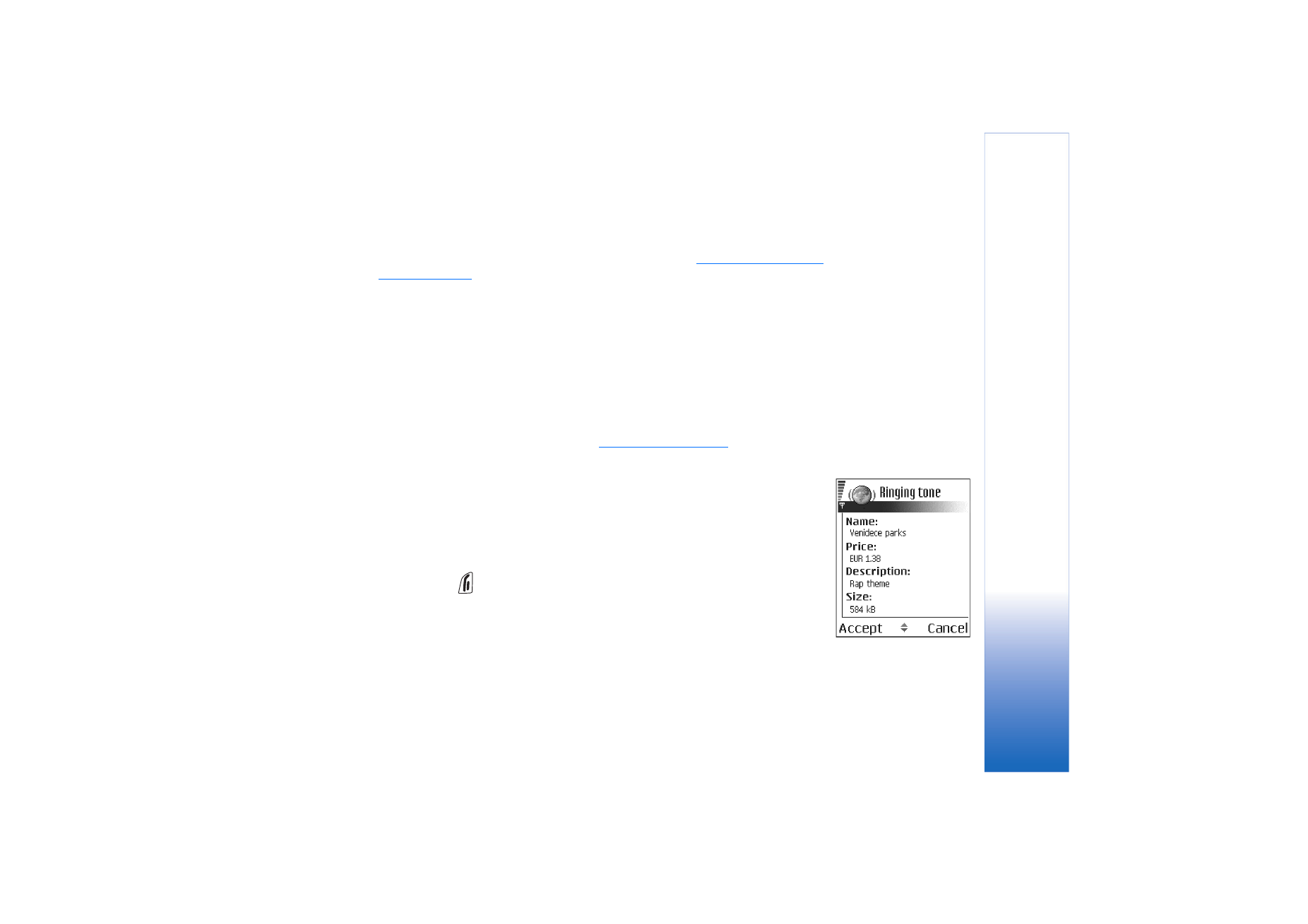
Copyright © 2004 Nokia. All rights reserved.
Services and Applications
107
If the online content is compatible, you can use your wallet information to make the
purchase:
1 Select
Open wallet
. You will be prompted for your wallet code.
See “Entering the wallet
code” on page 87.
2 Select the appropriate card category from your wallet.
3 Select
Fill in
. This will upload the selected wallet information.
If the wallet does not contain all information necessary for the purchase, you will be
requested to enter the remaining details manually.
Copyright protections may prevent some images, ringing tones, and other content from
being copied, modified, transferred or forwarded.
Checking an item before downloading
You can see details about an item before you download it. Details about an item may
include the price, a brief description and size.
See Fig. 18 on page 107.
• Scroll to the link and select
Options
→
Open
.
Details about the item are displayed on your phone.
• If you want to continue with the downloading, press
Accept
, or if you want to cancel
the download, press
Cancel
.
Ending a connection
• Select
Options
→
Advanced options
→
Disconnect
, or
• Press and hold
to quit browsing and to return to standby mode.
Browser settings
Select
Options
→
Settings
:
Fig. 18 Example of details
in a content file.

Copyright © 2004 Nokia. All rights reserved.
Services and Applications
108
•
Default access point
- If you want to change the default access point, press
to open
a list of available access points. The current default access point is highlighted.
See
“Connection settings” on page 68.
•
Show images
- Choose if you want to view pictures when you are browsing. If you
choose
No
, you can later load images during browsing by selecting
Options
→
Show
images
.
•
Font size
- You can choose five text sizes in the browser:
Smallest
,
Small
,
Normal
,
Large
,
and
Largest
.
•
Default encoding
- To make sure your browser pages display text characters correctly,
select the appropriate language type.
•
Automatic bookmarks
- To turn the automatic completion of addresses in
Bookmarks
On
or
Off
. To hide the
Auto. bookmarks
folder in
Bookmarks
, select
Hide folder
.
•
Screen size
- To use the whole display area for viewing Web pages, select
Full screen
.
•
Rendering
- Select
By quality
to have good image quality while browsing but at a slower
page download speed, or
By speed
to download pages faster but have lower image
quality.
•
Cookies
-
Allow
/
Reject
. You can enable or disable the receiving and sending of cookies
(a means of content providers to identify users and their preferences for frequently used
content).
•
Security warnings
- Choose to hide or show security notifications.
•
Conf. DTMF sending
-
Always
/
First time only
. Choose whether you want to confirm before
the phone sends DTMF tones during a voice call.
See “Options during a call” on page 17.
For example, you can make a voice call while you are viewing a browser page, send
DTMF tones while a voice call is in progress, and save in Contacts a name and phone
number from a browser page.
•
Wallet
- Choose
On
if you want the wallet to open automatically when a compatible
browser page is opened.

Copyright © 2004 Nokia. All rights reserved.
Services and Applications
109
Application manager
Go to
Menu
→
Tools
→ App. manager
In Application manager you can install new compatible Symbian operating system
applications (SIS files) and Java™ applications (Java MIDlets and MIDlet suites). You can
also update and uninstall applications from the phone, and monitor the installation history.
See Fig. 19 on page 110.
Options in the
Application manager
main view:
Install
,
View
details
,
View certificate
,
Update
,
Go to web address
,
Remove
,
View log
,
Send log
,
Settings
,
App. downloads
,
Help
, and
Exit
.
Applications in Application manager use shared memory.
See “Shared memory” on page 14.
When you open Application manager, you can see a list of:
• Applications saved in Application manager.
• Partially installed applications (indicated by
).
• Fully installed applications that you can remove (indicated by
).
You can only use Symbian operating system applications with a .SIS extension.
Your phone supports J2ME™Java applications. Do not download PersonalJava™
applications to your phone as they cannot be installed.
Installing applications - general information
You can install applications that are specifically intended for this phone and suitable for
the Symbian operating system.
If you install an application that is not intended specifically for this phone, it may function
and look different from what was originally intended.
Applications may be downloaded to your phone during browsing, received as attachments
in multimedia messages or e-mails, or received via Bluetooth from another device, for
example, a phone or a compatible PC.
Important: Only install applications from sources that offer adequate protection
against harmful software.
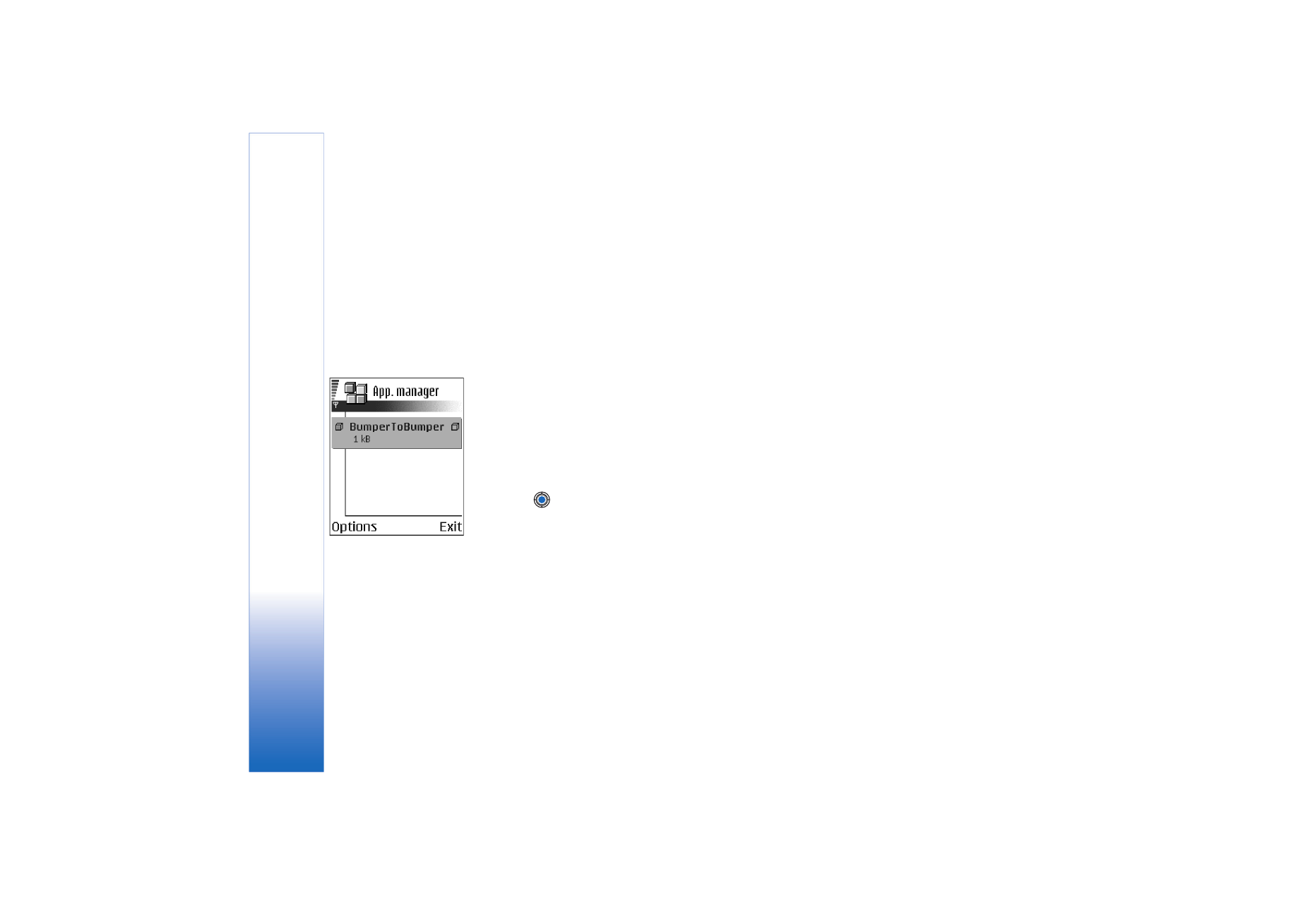
Copyright © 2004 Nokia. All rights reserved.
Services and Applications
110
To increase protection, the application installation system uses digital signatures and
certificates for applications. Do not install the application if Application manager gives a
security warning during installation.
If you install an application that contains an update or repair to an existing application,
you can only restore the original application if you have the original application or a full
backup copy of the removed application. To restore the original application, first remove
the updated or repaired application and then install again from the original application or
the backup copy.
During installation, the phone checks the integrity of the application to be installed. The
phone shows information about the checks being carried out and you are given options
whether to continue or cancel the installation. Once the phone has checked the integrity
of the application, it is installed on your phone.
Installing applications
• Open Application manager, scroll to the application, and select
Options
→
Install
to
start the installation.
• Alternatively, search the phone memory or the memory card, select the application, and
press
to start the installation.
Some applications may give the option of partial installation allowing you to select the
particular components of an application that you want to install. If you are installing an
application without a digital signature or a certificate, the phone warns you of the risks.
Continue installation only if you are absolutely sure of the origin and contents of the
application
Installing Java™
The .JAR file is required for installation. If it is missing, the phone may ask you to download
it. If there is no access point defined for Application manager, you will be asked to select
one. When you are downloading the .JAR file, you may need to enter a user name and
Fig. 19 The Application
manager main view.

Copyright © 2004 Nokia. All rights reserved.
Services and Applications
111
password to access the server. You obtain these from the supplier or manufacturer of the
application.
• To start a data connection and to view extra information about the application, scroll
to it and select
Options
→
Go to web address
.
• To start a data connection and to check if there is an update available for the
application, scroll to it and select
Options
→
Update
.
Java settings
• To change the default access point that a Java application uses for downloading extra
data, select
Options
→
Settings
→
Access point
.
See “Access points” on page 68.
• To change the security settings that determine the actions that a Java application is
permitted to do, select
Options
→
Settings
.
Not all Java applications permit you to change the security settings.
Removing an application
1 To remove an application, scroll to it and select
Options
→
Remove
.
2 Press
Yes
to confirm the removal.
If you remove an application, you can only re-install it if you have the original application
or a full backup of the removed application. If you remove an application, you may no
longer be able to open documents created with that application. If another application
depends on the application that you removed, the other application may stop working.
Refer to the documentation of the installed application for details.

Copyright © 2004 Nokia. All rights reserved.
Connectivity
112
Connectivity
Bluetooth connection
Go to
Menu
→
Connectivity
→
Bluetooth
This device is compliant with Bluetooth Specification 1.1 supporting the following profiles:
Dial-up networking profile (DUN) as a gateway, object push profile (OPP) as a client and
server, File transfer profile (FTP) as a server, Hands-free profile (HFP) as an audio gateway,
Generic object exchange profile (GOEP), Generic access profile (GAP), and serial port profile
(SPP) with the PC connectivity software. To ensure interoperability between other devices
supporting Bluetooth technology, use Nokia approved enhancements for this model. Check
with the manufacturers of other devices to determine their compatibility with this device.
There may be restrictions on using Bluetooth technology in some locations. Check with
your local authorities or service provider.
Features using Bluetooth technology, or allowing such features to run in the background
while using other features, increase the demand on battery power and reduces the battery
life.
Bluetooth technology enables wireless connections between electronic devices within a
maximum range of 10 metres. A Bluetooth connection can be used to send images, videos,
texts, business cards, calendar notes, or to connect wirelessly to compatible devices using
Bluetooth technology, such as computers.
Since devices using Bluetooth technology communicate using radio waves, your phone and
the other devices do not need to be in direct line-of-sight. The two devices only need to be
within a maximum of 10 metres of each other, although the connection can be subject to
interference from obstructions such as walls or from other electronic devices.
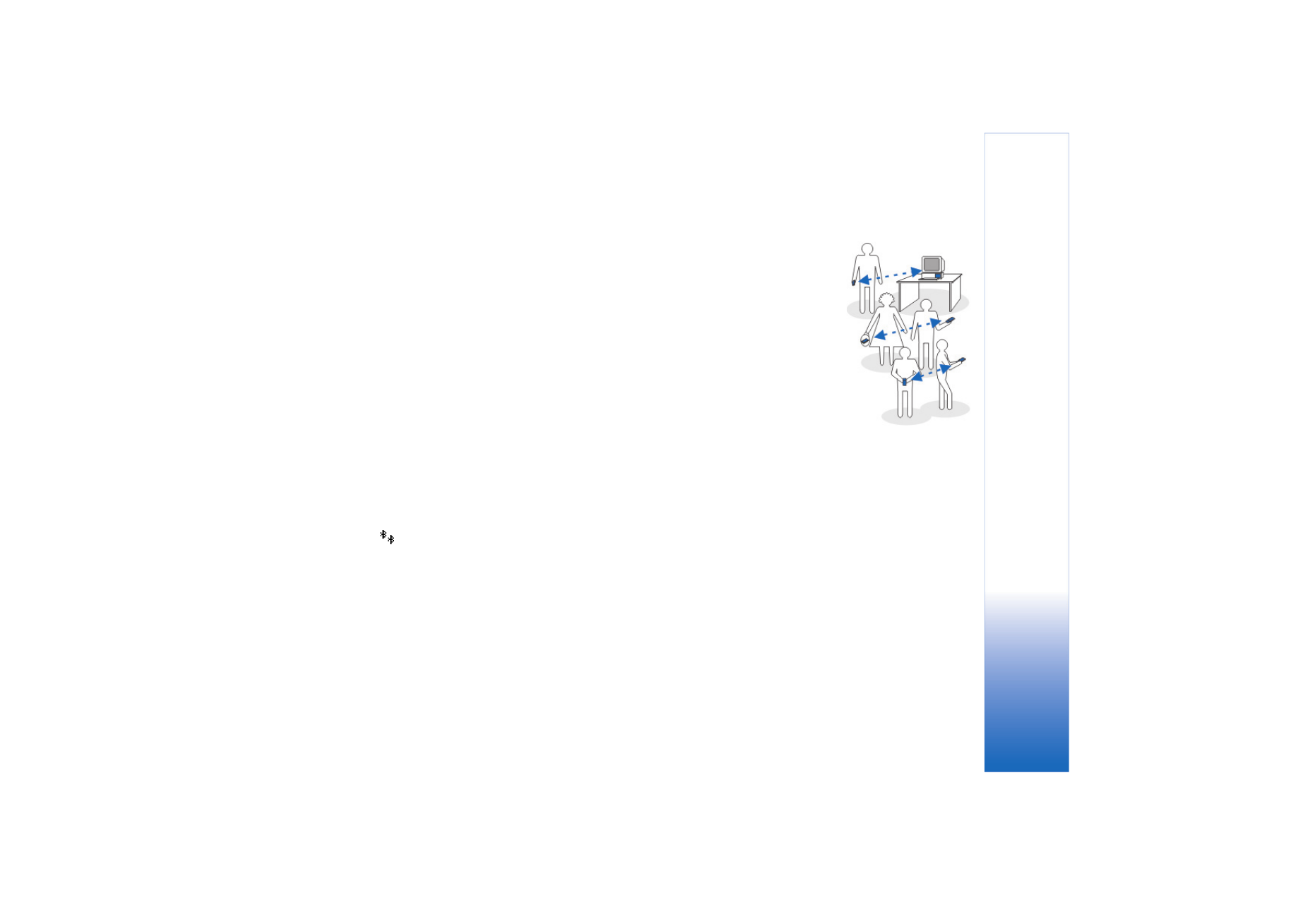
Copyright © 2004 Nokia. All rights reserved.
Connectivity
113
When you activate Bluetooth for the first time, you are asked to give a name to your phone.
Bluetooth settings
•
Bluetooth
-
On
/
Off
.
•
My phone's visibility
-
Shown to all
- Your phone can be found by other Bluetooth devices
or
Hidden
- Your phone cannot be found by other devices.
•
My phone’s name
- Define a name for your phone.
After you have set Bluetooth as active and changed
My phone's visibility
to
All
, your phone
and this name can be seen by other Bluetooth device users.
Sending data via Bluetooth
There can be only one active Bluetooth connection at a time.
1 Open an application where the item you wish to send is stored. For example, to send a
photo to another device, open the Gallery application.
2 Scroll to the item you want to send and select
Options
→
Send
→
Via Bluetooth
.
3 The phone starts to search for devices within range. Devices using Bluetooth technology
that are within range start to appear on the display one by one. You can see a device
icon, the device’s name, the device type, or a short name. Paired devices are shown with
. A paired device is one where a Bluetooth connection already exists between your
phone and the other device.
• To interrupt the search, press
Stop
. The device list freezes and you can start to form
a connection to one of the devices already found.
When searching for devices, some devices may show only the unique device addresses.
To find out the unique address of your phone, enter the code *#2820# in standby mode.
If you have searched for devices earlier, a list of the devices that were found previously
is shown first. To start a new search, select
More devices
. If you switch off the phone,
the list of devices is cleared and the device search needs to be started again before
sending data.
Fig. 20 Using Bluetooth.
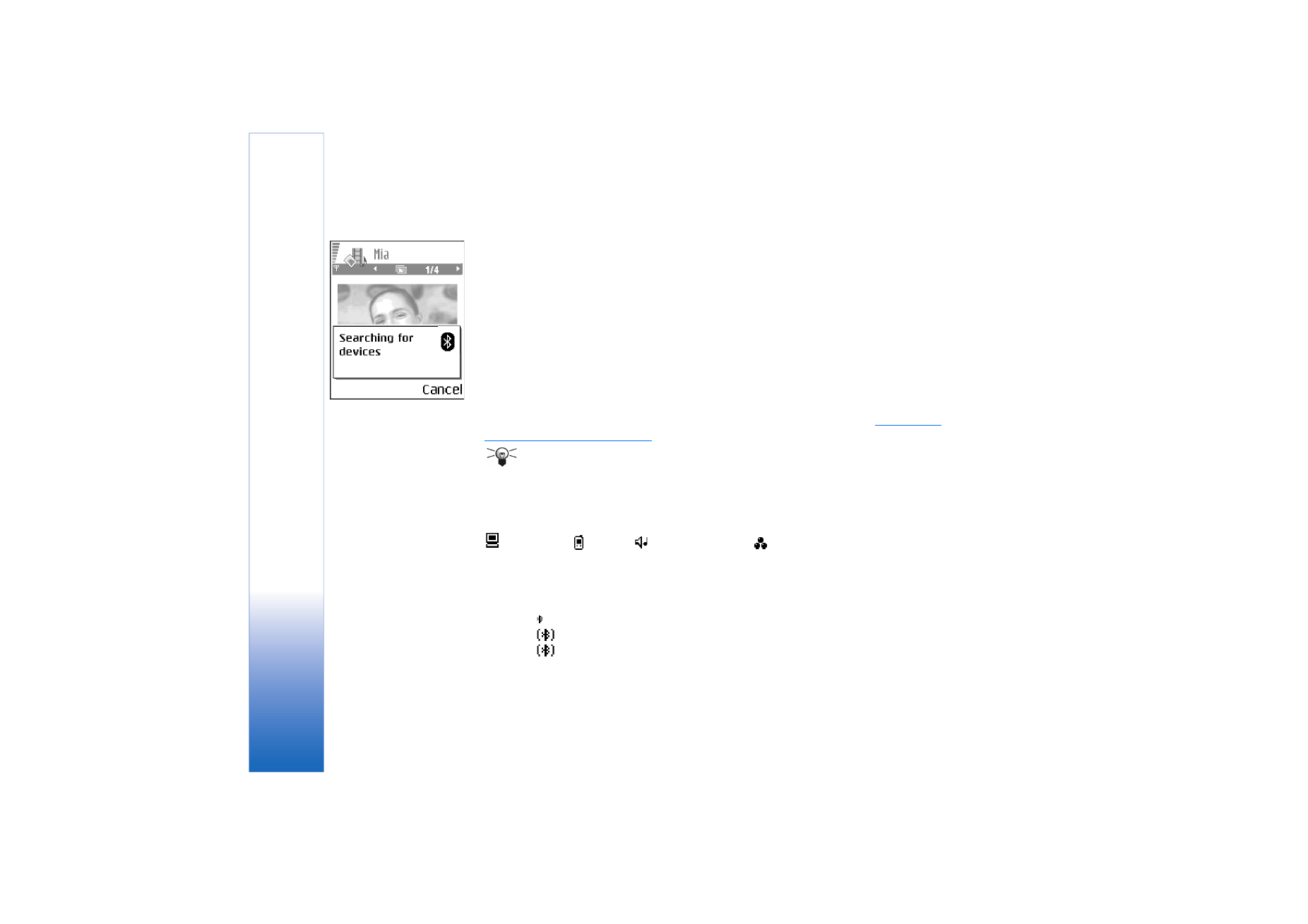
Copyright © 2004 Nokia. All rights reserved.
Connectivity
114
4 Scroll to the device you want to connect with and press
Select
. The item you are
sending is copied to Outbox and the note
Connecting
is shown.
5 Pairing (if not required by the other device, go to step 6.)
• If the other device requires pairing before data can be transmitted, a tone sounds and
you are asked to enter a passcode.
• Create your own passcode (1-16 characters long, numeric) and agree with the owner
of the other device to use the same code. This passcode is used only once and you do
not have to memorise it.
• After pairing, the device is saved to the Paired devices view.
6 When the connection has been successfully established, the note
Sending data
is shown.
Copyright protections may prevent some images, ringing tones, and other content from
being copied, modified, transferred or forwarded.
Data received via Bluetooth can be found in the Inbox folder in Messaging.
See “Inbox -
receiving messages” on page 52.
Tip: Pairing means authentication. The users of the devices using Bluetooth
technology should agree together what the passcode is, and use the same passcode
for both devices in order to pair them. Devices that do not have a user interface have
a preset passcode.
Icons for different devices:
-
Computer
,
-
Phone
,
-
Audio/video
, and
-
Bluetooth device
.
If sending fails, the message or data will be deleted. The Drafts folder in Messaging does
not store messages sent via Bluetooth.
Checking the status of the Bluetooth connection
• When is shown in standby mode, Bluetooth is active.
• When
is blinking, your phone is trying to connect to the other device.
• When
is shown continuously, the Bluetooth connection is active.
Fig. 21 Sending an image
via Bluetooth, the phone
starts to search for
devices.

Copyright © 2004 Nokia. All rights reserved.
Connectivity
115
Paired devices view
Paired devices are easier to recognise, they are indicated by
in the search result list. In
the Bluetooth main view, press
to open a list of paired devices (
).
• To pair with a device: Select
Options
→
New paired device
. The phone starts a device
search. Scroll to the device you want to pair with and press
Select
. Exchange passcodes.
The device is added to the Paired devices list.
• To cancel pairing: Scroll to the device whose pairing you want to cancel and press
or select
Options
→
Delete
. If you want to cancel all pairings, select
Options
→
Delete all
.
If you are currently connected to a device, and delete the pairing with that device, the
pairing is removed and the device connection is terminated, but Bluetooth remains
active on the handset.
• To set a device to be authorised or unauthorised: Scroll to the device and select
Options
→
Set as authorised
- Connections between your phone and this device can be
made without your knowledge. No separate acceptance or authorisation is needed. Use
this status for your own devices, for example, your PC, or devices that belong to
someone you trust. The icon
is added next to authorised devices in the Paired devices
view.
Set as unauthorised
- Connection requests from this device need to be accepted
separately every time.
• To assign a short name to a device: Select
Options
→
Assign short name
. Enter a name
for the device.
Receiving data via Bluetooth
When you receive data via Bluetooth, a tone sound is played and you are asked if you want
to accept the message. If you accept, the item is placed in the Inbox folder in Messaging.
Messages received via Bluetooth are indicated by
.
See “Inbox - receiving messages” on
page 52.
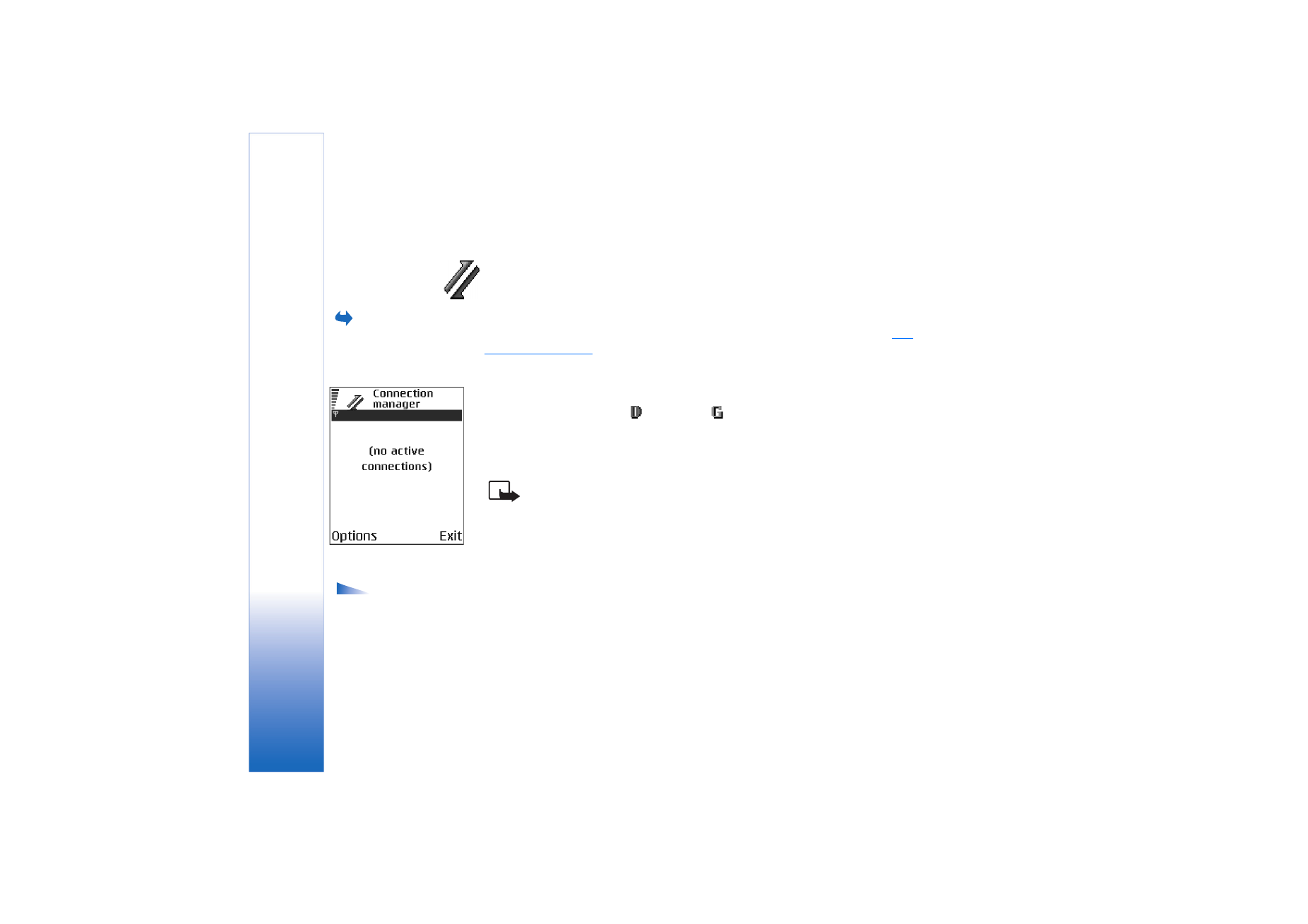
Copyright © 2004 Nokia. All rights reserved.
Connectivity
116
Disconnecting Bluetooth
A Bluetooth connection is disconnected automatically after sending or receiving data.
Connection manager
Go to
Menu
→
Connectivity
→
Connection manager
In Connection manager you can identify the status of multiple data connections, view
details on the amount of data sent and received, and end unused connections.
See
Fig. 22 on page 116.
You can view details of data connections only. Voice calls are not listed.
When you open Connection manager, you can see a list of:
• Open data connections,
-
Data call
,
-
GPRS
• The status of each connection.
• Amount of data uploaded and downloaded for each connection (GPRS connections
only).
• The duration of each connection (Data call connections only).
Note: The actual time invoiced for calls by your service provider may vary,
depending on network features, rounding off for billing, and so forth.
Options in the
Connection manager
main view when there are
one or more connections:
Details
,
Disconnect
,
Disconnect all
,
Help
and
Exit
.
Viewing connection details
To view the details of a connection, scroll to a connection and select
Options
→
Details
The
following is displayed:
•
Name
- The name of the Internet Access Point (IAP) in use.
•
Bearer
- The type of data connection:
Data call
or
GPRS
.
•
Status
- The current status of the connection.
Fig. 22 The Connection
manager main view.

Copyright © 2004 Nokia. All rights reserved.
Connectivity
117
•
Received
- The amount of data, in bytes, received to the phone.
•
Sent
- The amount of data, in bytes, sent from the phone.
•
Duration
- The length of time that the connection has been open.
•
Speed
- The current speed of both sending and receiving data in kB/s (kilobytes per
second).
•
Dial-up
(GSM) - The dial-up number used, or
Name
(GPRS) - access point name used.
•
Shared
(not displayed if the connection is not shared) - The number of applications
using the same connection.
Ending connections
• Scroll to a connection and select
Options
→
Disconnect
to end that connection only.
• Select
Options
→
Disconnect all
to close all currently open connections.
Connecting your phone to a compatible
computer
For further information on how to make a connection to a compatible computer via USB
or Bluetooth, and how to install Nokia PC Suite 6.3, see the User’s Guide for Nokia PC Suite
on the CD-ROM. For further information on how to use Nokia PC Suite, see the help
function on PC Suite or visit the support pages at www.nokia.com.
Sync - remote synchronisation
Go to
Menu
→
Connectivity
→
Sync
The Sync application enables you to synchronise your calendar or contacts with various
calendar and address book applications on a compatible computer or on the Internet.
Synchronisation takes place over a GSM data call or packet data connection.

Copyright © 2004 Nokia. All rights reserved.
Connectivity
118
The synchronisation application uses SyncML technology for synchronisation. For
information on SyncML compatibility, please contact the supplier of the calendar or
address book application you want to synchronise your phone data with.
Creating a new synchronisation profile
Options in the
Remote sync main view:
Synchronise
,
New sync
profile
,
Edit sync profile
,
Delete
,
View log
,
Help
, and
Exit
.
1 If no profiles have been defined, the phone asks you if you want to create a new profile.
Select
Yes
.
To create a new profile in addition to existing ones, select
Options
→
New sync profile
.
Choose whether you want to use the default setting values or copy the values from an
existing profile to be used as the basis for the new profile.
2 Define the following:
Sync profile name
- Write a descriptive name for the profile.
Access point
- Select an access point you want to use for the data connection.
Host address
- Contact your service provider or system administrator for the correct
values.
Port
- Contact your service provider or system administrator for the correct values.
User name
- Your user ID for the synchronisation server. Contact your service provider
or system administrator for your correct ID.
Password
- Write your password. Contact your service provider or system administrator
for the correct value.
Press
to select:
Calendar
- Select
Yes
if you want to synchronise your calendar.
Remote calendar
- Enter a correct path to the remote calendar on the server. Must be
defined if the previous setting
Calendar
has been set to
Yes
.
Contacts
- Select
Yes
if you want to synchronise your contacts.
Remote contacts
- Enter a correct path to the remote address book on the server. It must
be defined if the previous setting
Contacts
has been set to
Yes
.
3 Press
Done
to save the settings.

Copyright © 2004 Nokia. All rights reserved.
Connectivity
119
Synchronising data
In the Sync main view, you can see the different profiles, and what kind of data will be
synchronised: Calendar, Contacts, or both.
1 In the main view, scroll to a profile and select
Options
→
Synchronise
. The status of the
synchronisation is shown at the bottom of the screen.
To cancel synchronisation before it is finished, press
Cancel
.
2 You are notified when the synchronisation has been completed.
• After synchronisation is complete, press
View log
or select
Options
→
View log
to open
a log file showing the synchronisation status (
Complete
or
Incomplete
) and how many
calendar or contact entries have been added, updated, deleted, or discarded (not
synchronised) in the phone or on the server.

Copyright © 2004 Nokia. All rights reserved.
Troubleshooting
120
Troubleshooting
Memory low
When the following notes are shown, the phone memory is
low and you must start to delete some data:
Not enough
memory to perform operation. Delete some data first.
or
Memory
low. Delete some data.
To view what kind of data you have and
how much memory the different data groups consume, go to
File manager
and select
Options
→
Memory details
.
You may want to delete the following items regularly to
avoid memory getting low:
•
Messages from the Inbox, Drafts, and Sent folders in
Messaging.
•
Retrieved e-mail messages from the phone memory.
•
Saved browser pages.
•
Images and photos in Images.
If you want to delete contact information, calendar notes, call
timers, call cost timers, game scores, or any other data, go to
the respective application to remove the data.
If you are deleting multiple items and another of the
following notes are shown:
Not enough memory to perform
operation. Delete some data first.
or
Memory low. Delete some
data.,
try deleting items one by one (starting from the smallest
item).
Clearing calendar memory - To remove more than one event
at a time, go to the Month view and select
Options
→
Delete
entry
→ and either:
•
Before date
- to delete all calendar notes which take place
before a certain date. Enter the date before which all
calendar notes will be deleted.
•
All entries
- to delete all calendar notes.
Erasing log information - To erase all the log contents,
Recent calls register, and Messaging delivery reports
permanently, go to Logs and select
Options
→
Clear log
or go
to
Settings
→
Log duration
→
No log
.
Different ways to store data:
•
Use Nokia PC Suite 6.3 to make a backup copy of all data
to a compatible computer.
•
Send images to your e-mail address and then save the
images to your computer.
•
Send data via Bluetooth to a compatible device.
•
Store data on a compatible memory card.

Copyright © 2004 Nokia. All rights reserved.
Troubleshooting
121
Q&A
Phone display
•
Q. Why do missing, discoloured or bright dots appear on
the screen every time I turn on my phone?
A. This is a characteristic of this type of display. Some
displays may contain pixels or dots that remain on or off.
This is normal, not a fault.
Camera
•
Q: Why do images look smudgy?
A: Check that the camera lens protection window is clean.
Bluetooth
•
Q: Why can’t I end a Bluetooth connection?
A: If another device is connected to your phone, you can
either end the connection using the other device or by
deactivating Bluetooth. Go to Bluetooth and select the
setting
Bluetooth
→
Off
.
•
Q: Why can’t I find my friend’s Bluetooth-enabled device.
A: Check that both have activated Bluetooth.
Check that the distance between the two devices is not
over 10 metres or that there are no walls or other
obstructions between the devices.
Check that the other device is not in ‘Hidden’ mode.
Check that both devices are compatible.
Multimedia messaging
•
Q: What should I do when the phone tells me that it cannot
receive a multimedia message because memory is full?
A: The amount of memory needed is indicated in the error
message:
Not enough memory to retrieve message. Delete
some data first.
To view what kind of data you have and
how much memory the different data groups consume, go
to
File manager
and select
Options
→
Memory details
.
•
Q: How can I end the data connection when the phone
starts a data connection again and again? The notes:
Retrieving message
or
Trying to retrieve message again
are
shown briefly. What is happening?
A: The phone is trying to retrieve a multimedia message
from the multimedia messaging centre.
Check that the settings for multimedia messaging have
been defined correctly and that there are no mistakes in
phone numbers or addresses. Go to
Messaging
and select
Options
→
Settings
→
Multimedia message
.
To stop the phone from making a data connection, you
have the following options. Go to
Messaging
and select
Options
→
Settings
→
Multimedia message
, and then:
• Select
On receiving msg.
→
Defer retrieval
if you want the
multimedia messaging centre to save the message to be
retrieved later, for example, after you have checked the
settings. After this change, the phone still needs to send
information notes to the network. To retrieve the
message later, select
Retr. immediately
.
• Select
On receiving msg.
→
Reject message
- if you want
to reject all incoming multimedia messages. After this
change, the phone needs to send information notes to
the network and the multimedia messaging centre will

Copyright © 2004 Nokia. All rights reserved.
Troubleshooting
122
delete all multimedia messages that are waiting to be
sent to you.
• Select
Multimedia reception
→
Off
- if you want to
ignore all incoming multimedia messages. After this
change the phone will not make any network
connections related to multimedia messaging.
Messaging
•
Q: Why can’t I select a contact?
A: If you cannot select a contact in the Contacts directory,
the contact card does not have a phone number or an e-
mail address. Add the missing information to the contact
card in the Contacts application.
Calendar
•
Q: Why are the week numbers missing?
A: If you have changed the Calendar settings so that the
week starts on a day other than Monday, then the week
numbers will not be shown.
Browser Services
•
Q:
No valid access point defined. Define one in Services settings.
A: Insert proper browser settings. Contact your service
provider for instructions.
Log
•
Q: Why does the log appear empty?
A: You may have activated a filter, and no communication
events fitting that filter have been logged. To see all
events, select
Options
→
Filter
→
All communication
.
PC connectivity
•
Q: Why do I have problems in connecting the phone to my
PC?
A: Make sure that Nokia PC Suite 6.3 is installed and
running on your PC. See the User’s
Guide for
Nokia
PC
Suite on the CD-ROM. For further information on how
to use
Nokia
PC Suite, see the help function on PC Suite
or visit the support pages at www.nokia.com
.
Access codes
•
Q: What is my password for the lock, PIN, or PUK codes?
A: The default lock code is 12345. If you forget or lose the
lock code, contact your phone dealer.
If you forget or lose a PIN or PUK code, or if you have not
received such a code, contact your network service
provider.
For information about passwords, contact your access
point provider, for example, a commercial Internet Service
Provider (ISP), service provider, or network operator.
Application not responding
•
Q: How do I close an application that is not responding?
A: Open the application switching window by pressing and
holding
. Then scroll to the application, and press
to close the application.

Copyright © 2004 Nokia. All rights reserved.
Battery information
123
Battery information
Charging and Discharging
Your device is powered by a rechargeable battery. The full
performance of a new battery is achieved only after two or
three complete charge and discharge cycles. The battery can
be charged and discharged hundreds of times but it will
eventually wear out. When the talk and standby times are
noticeably shorter than normal, buy a new battery. Use only
Nokia approved batteries, and recharge your battery only with
Nokia approved chargers designated for this device.
Unplug the charger from the electrical plug and the device
when not in use. Do not leave the battery connected to a
charger. Overcharging may shorten its lifetime. If left unused,
a fully charged battery will lose its charge over time.
Temperature extremes can affect the ability of your battery to
charge.
Use the battery only for its intended purpose. Never use any
charger or battery that is damaged.
Do not short-circuit the battery. Accidental short-circuiting
can occur when a metallic object such as a coin, clip, or pen
causes direct connection of the positive (+) and negative (-)
terminals of the battery. (These look like metal strips on the
battery.) This might happen, for example, when you carry a
spare battery in your pocket or purse. Short-circuiting the
terminals may damage the battery or the connecting object.
Leaving the battery in hot or cold places, such as in a closed
car in summer or winter conditions, will reduce the capacity
and lifetime of the battery. Always try to keep the battery
between 15°C and 25°C (59°F and 77°F). A device with a hot
or cold battery may not work temporarily, even when the
battery is fully charged. Battery performance is particularly
limited in temperatures well below freezing.
Do not dispose of batteries in a fire! Dispose of batteries
according to local regulations. Please recycle when possible.
Do not dispose as household waste.

Copyright © 2004 Nokia. All rights reserved.
Care and Maintenance
124
Care and Maintenance
Your device is a product of superior design and craftsmanship
and should be treated with care. The suggestions below will
help you protect your warranty coverage.
•
Keep the device dry. Precipitation, humidity and all types
of liquids or moisture can contain minerals that will
corrode electronic circuits. If your device does get wet,
remove the battery and allow the device to dry completely
before replacing it.
•
Do not use or store the device in dusty, dirty areas. Its
moving parts and electronic components can be damaged.
•
Do not store the device in hot areas. High temperatures
can shorten the life of electronic devices, damage
batteries, and warp or melt certain plastics.
•
Do not store the device in cold areas. When the device
returns to its normal temperature, moisture can form
inside the device and damage electronic circuit boards.
•
Do not attempt to open the device other than as
instructed in this guide.
•
Do not drop, knock, or shake the device. Rough handling
can break internal circuit boards and fine mechanics.
•
Do not use harsh chemicals, cleaning solvents, or strong
detergents to clean the device.
•
Do not paint the device. Paint can clog the moving parts
and prevent proper operation.
•
Use a soft, clean, dry cloth to clean any lenses (such as
camera, proximity sensor, and light sensor lenses).
•
Use only the supplied or an approved replacement
antenna. Unauthorised antennas, modifications, or
attachments could damage the device and may violate
regulations governing radio devices.
All of the above suggestions apply equally to your device,
battery, charger, or any enhancement. If any device is not
working properly, take it to the nearest authorized service
facility for service.

Copyright © 2004 Nokia. All rights reserved.
Additional safety information
125
Additional safety information
A few practical rules about accessories and
enhancements
•
Keep all accessories and enhancements out of the reach of
small children.
•
When you disconnect the power cord of any accessory or
enhancement, grasp and pull the plug, not the cord.
•
Check regularly that enhancements installed in a vehicle
are mounted and are operating properly.
•
Installation of any complex car enhancements must be
made by qualified personnel only.
Operating environment
Remember to follow any special regulations in force in any
area and always switch off your device when its use is
prohibited or when it may cause interference or danger. Use
the device only in its normal operating positions. To maintain
compliance with radio frequency exposure guidelines only use
enhancements approved by Nokia for use with this device.
When the device is on and being worn on the body, always use
an approved holder or carrying case.
Parts of the device are magnetic. Metallic materials may be
attracted to the device, and persons with a hearing aid should
not hold the device to the ear with the hearing aid. Always
secure the device in its holder, because metallic materials may
be attracted by the earpiece. Do not place credit cards or other
magnetic storage media near the device, because information
stored on them may be erased.
Medical devices
Operation of any radio transmitting equipment, including
wireless phones, may interfere with the functionality of
inadequately protected medical devices. Consult a physician
or the manufacturer of the medical device to determine if
they are adequately shielded from external RF energy or if you
have any questions. Switch off your device in health care
facilities when any regulations posted in these areas instruct
you to do so. Hospitals or health care facilities may be using
equipment that could be sensitive to external RF energy.
Pacemakers
Pacemaker manufacturers recommend that a
minimum separation of 6 in. (15.3 cm) be maintained between
a wireless phone and a pacemaker to avoid potential
interference with the pacemaker. These recommendations are
consistent with the independent research by and
recommendations of Wireless Technology Research. Persons
with pacemakers should:
•
always keep the device more than 6 in. (15.3 cm) from
their pacemaker when the device is switched on;
•
not carry the device in a breast pocket; and
•
hold the device to the ear opposite the pacemaker to
minimise the potential for interference.
If you have any reason to suspect that interference is taking
place, switch off your device immediately.

Copyright © 2004 Nokia. All rights reserved.
Additional safety information
126
Hearing aids
Some digital wireless devices may interfere
with some hearing aids. If interference occurs, consult your
service provider.
Vehicles
RF signals may affect improperly installed or inadequately
shielded electronic systems in motor vehicles such as
electronic fuel injection systems, electronic antiskid (antilock)
braking systems, electronic speed control systems, air bag
systems. For more information, check with the manufacturer
or its representative of your vehicle or any equipment that has
been added.
Only qualified personnel should service the device, or install
the device in a vehicle. Faulty installation or service may be
dangerous and may invalidate any warranty that may apply to
the device. Check regularly that all wireless device equipment
in your vehicle is mounted and operating properly. Do not
store or carry flammable liquids, gases, or explosive materials
in the same compartment as the device, its parts, or
enhancements. For vehicles equipped with an air bag,
remember that air bags inflate with great force. Do not place
objects, including installed or portable wireless equipment in
the area over the air bag or in the air bag deployment area. If
in-vehicle wireless equipment is improperly installed and the
air bag inflates, serious injury could result.
Using your device while flying in aircraft is prohibited. Switch
off your device before boarding an aircraft. The use of wireless
teledevices in an aircraft may be dangerous to the operation
of the aircraft, disrupt the wireless telephone network, and
may be illegal.
Potentially explosive environments
Switch off your device when in any area with a potentially
explosive atmosphere and obey all signs and instructions.
Potentially explosive atmospheres include areas where you
would normally be advised to turn off your vehicle engine.
Sparks in such areas could cause an explosion or fire resulting
in bodily injury or even death. Switch off the device at
refuelling points such as near gas pumps at service stations.
Observe restrictions on the use of radio equipment in fuel
depots, storage, and distribution areas, chemical plants or
where blasting operations are in progress. Areas with a
potentially explosive atmosphere are often but not always
clearly marked. They include below deck on boats, chemical
transfer or storage facilities, vehicles using liquefied
petroleum gas (such as propane or butane), and areas where
the air contains chemicals or particles such as grain, dust or
metal powders.
Emergency calls
Important: Wireless phones, including this device,
operate using radio signals, wireless networks, landline
networks, and user-programmed functions. Because of this,
connections in all conditions cannot be guaranteed. You
should never rely solely on any wireless device for essential
communications like medical emergencies.
To make an emergency call:
1
If the device is not on, switch it on. Check for adequate
signal strength.
Some networks may require that a valid SIM card is
properly inserted in the device.

Copyright © 2004 Nokia. All rights reserved.
Additional safety information
127
2
Press
as many times as needed to clear the display and
ready the device for calls.
3
Key in the official emergency number for your present
location. Emergency numbers vary by location.
4
Press the
key.
If certain features are in use, you may first need to turn those
features off before you can make an emergency call. Consult
this guide or your service provider for more information.
When making an emergency call, give all the necessary
information as accurately as possible. Your wireless device
may be the only means of communication at the scene of an
accident. Do not end the call until given permission to do so.
Certification information (SAR)
THIS DEVICE MEETS INTERNATIONAL GUIDELINES FOR
EXPOSURE TO RADIO WAVES
Your mobile device is a radio transmitter and receiver. It is
designed and manufactured not to exceed the limits for
exposure to radio frequency (RF) recommended by
international guidelines (ICNIRP). These limits are part of
comprehensive guidelines and establish permitted levels of RF
energy for the general population. The guidelines were
developed by independent scientific organisations through
periodic and thorough evaluation of scientific studies. The
guidelines include a substantial safety margin designed to
assure the safety of all persons, regardless of age and health.
The exposure standard for mobile devices employs a unit of
measurement known as the Specific Absorption Rate, or SAR.
The SAR limit stated in the international guidelines is 2.0 W/
kg*. Tests for SAR are conducted using standard operating
positions with the device transmitting at its highest certified
power level in all tested frequency bands. Although the SAR
is determined at the highest certified power level, the actual
SAR of the device while operating can be well below the
maximum value. This is because the device is designed to
operate at multiple power levels so as to use only the power
required to reach the network. In general, the closer you are
to a base station, the lower the power output of the device.
The highest SAR value for this device when tested for use at
the ear is 0.67 W/kg.
This device meets RF exposure guidelines when used either in
the normal use position against the ear or when positioned at
least 2.2 cm away from the body. When a carry case, belt clip
or holder is used for body-worn operation, it should not
contain metal and should position the product at least 2.2 cm
away from your body.
In order to transmit data files or messages, this device
requires a quality connection to the network. In some cases,
transmission of data files or messages may be delayed until
such a connection is available. Ensure the above separation
distance instructions are followed until the transmission is
completed.
* The SAR limit for mobile devices used by the public is 2.0
watts/kilogram (W/kg) averaged over ten grams of body
tissue. The guidelines incorporate a substantial margin of
safety to give additional protection for the public and to
account for any variations in measurements. SAR values may
vary depending on national reporting requirements and the
network band. For SAR information in other regions please
look under product information at www.nokia.com.

Copyright © 2004 Nokia. All rights reserved.